By LEOR GALIL 52



FREE AND FREAKY SINCE 1971 | APRIL 14, 2022
CANNABIS CONVERSATIONS In this issue... J Wade and Cloud Boy build a Creative Mansion J Wade and Cloud Boy build a Creative Mansion The hip-hop duo’s new album has become the gravitational center of an artistic collective. The hip-hop duo’s new album has become the gravitational center of an artistic collective.
CHICAGO READER | APRIL 14, 2022 | VOLUME 51, NUMBER 14
TO
CITY LIFE
04 Shop Local Design collective we are MATERIAL creates clothing for the here and now.
FOOD & DRINK
06 Sula | Review Sfera Sicilian Street Food ghosts its virtual kitchen.
NEWS & POLITICS
08 Joravsky | Politics Republican strategists think they can win over the Black vote by trashing Justice Jackson.
10 Isaacs | Culture Will gambling save the national pastime?

12 Labor Baristas in Chicago are joining a union wave that’s sweeping Starbucks nationwide.
University of Chicago Press details the history of Mexican citizens migrating to Chicago.

41 Reviews In Every Generation examines inherited trauma across four Passovers; Drury Lane’s The King and I strips away Orientalism.

FILM
44 Greene | Profile Coquie Hughes hasn’t let the hurdles of the industry stop her from creating.
46 Review Apichatpong Weerasethakul’s Memoria is more elusive and even more enveloping than his other beguiling films.
24
26 Interview Fran
47 Movies of Note Ambulance is an engine revved nearly beyond its limits, Morbius would be fun enough if it were just a ride in a theme park, and Father Stu can’t be saved by Mark Wahlberg.
MUSIC & NIGHTLIFE
of releases by Cisco Swank & Luke Titus, Taj Mahal & Ry Cooder, Claire Rousay, and more 60 Tradition Beau O’Reilly keeps the folk cabaret alive 62 Chicagoans of Note Del Hale, aka DJ Miss Twink USA of Rumors and Legion of Doom 64 Early Warnings Rescheduled concerts and other updated listings 64 Gossip Wolf Experimental Sound Studio unveils an archive devoted to beloved saxphonist Fred Anderson, and Jeremiah Meece and Tim Nordberg debut as the Ineffectuals with a collection of squelchy electro jams.
E-MAIL:
INITIAL)(LAST
PUBLISHER AND PRESIDENT TRACY BAIM PUBLISHER AND EDITOR IN CHIEF KAREN HAWKINS EDITOR IN CHIEF SUJAY KUMAR
PRODUCTION MANAGER KIRK WILLIAMSON
SENIOR GRAPHIC DESIGNER AMBER HUFF
CULTURE EDITOR SALEM COLLO-JULIN NEWS EDITOR JIM DALEY
THEATER AND DANCE EDITOR KERRY REID

MUSIC EDITOR PHILIP MONTORO
ASSOCIATE EDITORS JAMIE LUDWIG, TARYN ALLEN
SENIOR WRITERS LEOR GALIL, DEANNA ISAACS, BEN JORAVSKY, MIKE SULA
STAFF WRITERS ADAM M. RHODES, KATIE PROUT, KELLY GARCIA
AUDIENCE ENGAGEMENT MANAGER YASMIN ZACARIA MIKHAIEL
EDITORIAL ASSOCIATE JANAYA GREENE LISTINGS COORDINATOR MICCO CAPORALE
VICE PRESIDENT OF OPERATIONS ANN SCHOLHAMER
DIRECTOR OF DIGITAL JOHN DUNLEVY
DIRECTOR OF DEVELOPMENT JT NEWMAN
DIRECTOR OF MARKETING VIVIAN GONZALEZ
MEDIA PARTNERSHIPS COORDINATOR YAZMIN DOMINGUEZ
EXECUTIVE ASSISTANT SANDRA L. KLEIN SPECIAL PROJECTS ASSOCIATE SHAWNEE DAY CIMA SUPPORT SPECIALIST SAVANNAH HUGUELEY
16 Prout | Housing Four Chicagoans describe what it’s like to seek shelter on the CTA.

20 Garcia | Politics State senator Celina Villanueva faces a primary challenge from Byron SigchoLopez’s chief of staff.
ARTS & CULTURE
22 Books A new book published by
finds herself at a loss for words
THEATER
30 Comic Intervention Wicker Park’s the Den finds a savior in stand-up comedy.
52 Galil | Feature J Wade and Cloud Boy’s long-gestating new album, The One Who Knocks, has become the gravitational center of a sprawling artistic collective.

56 Shows and Records of Note Previews of concerts including Thumbscrew, Jawbreaker, and Waldos Forever Fest, plus reviews
OPINION
66 Savage Love Dan Savage explains why your STI isn’t invited to the sex party.
ADVERTISING 312-392-2970, ADS@CHICAGOREADER.COM CLASSIFIEDS: CLASSIFIED-ADS@CHICAGOREADER.COM
VP OF SALES AND BUSINESS DEVELOPMENT AMBER NETTLES
VICE PRESIDENT OF SALES AMY MATHENY SALES TEAM VANESSA FLEMING, LENI MANAA-HOPPENWORTH, TIM OGDEN, TED PIEKARZ, WILL ROGERS, LISA SOLOMON DIGITAL SALES ASSOCIATE AYANA ROLLING NATIONAL ADVERTISING
By KATIE PROUT 48
2 CHICAGO READER - APRIL 14, 2022 ll
Art Reviews Two gallery shows at Western Exhibitions that rediscover the human form; midcentury artist Bob Thompson is introduced to new audiences.
Lebowitz on how employers are failing American cities, the joy of banging a gavel as a judge on Law & Order, and whether she ever
CLASSIFIEDS 68 Jobs 68 Apartments & Spaces 68 Matches THIS WEEK
CONTACT ANY READER EMPLOYEE,
(FIRST
NAME) @CHICAGOREADER.COM ON THE COVER: PHOTO BY MATTHEW GILSON. FOR MORE OF GILSON’S WORK, GO TO MATTHEWGILSON.COM.
VOICE MEDIA GROUP 1-888-278-9866 VMGADVERTISING.COM JOE LARKIN AND SUE BELAIR DISTRIBUTION CONCERNS distributionissues@chicagoreader.com 312-392-2970
IN THIS ISSUE Judas Christ Superstar: Easter thoughts on being just A er more than 50 years, Jesus Christ Superstar still speaks clearly to the tensions that fracture every group working for revolutionary change.
READER (ISSN 1096-6919) IS PUBLISHED BIWEEKLY BY CHICAGO READER L3C 2930 S. MICHIGAN, SUITE 102 CHICAGO, IL 60616 312-392-2934, CHICAGOREADER.COM COPYRIGHT © 2022 CHICAGO READER PERIODICAL POSTAGE PAID AT CHICAGO, IL ALL RIGHTS RESERVED. CHICAGO READER, READER, AND REVERSED R: REGISTERED TRADEMARKS ®
Nina Escobedo: Bringing a passion for costumes to Chicago’s TV and Film industry
By Matt Simonette
Nina Escobedo credits her grandmother for sparking the childhood interests that ultimately led to her becoming a professional costumer working in Chicago.
“My grandmother taught me to sew at the age of four,” recalled Escobedo. at early tutelage inspired a deep passion for wardrobe and costumes in Escobedo. A er two years as wardrobe supervisor for Chicago’s Lookingglass eatre Company, the COVID-19 pandemic necessitated that she pivot. So Escobedo, who lives on Chicago’s North Side, is now taking part in the City’s Chicago Made workforce development initiative linking residents with lm and television productions shooting in the city.
Escobedo received on-the-job training from Local 769 costumers Jennifer Jobst and Angela Verdino as they prepared for an upcoming Net ix feature lm to be lmed at Cinespace Chicago Film Studios.
“I’m kind of here to ‘shadow’ as they put the production together, and I can assist as long as I’m supervised,” explained Escobedo, adding that she also took Zoom classes for several days that explained the jargon and procedures used by a major production.
A Minnesota native, Escobedo moved to Chicago in order to attend the Douglas J. Aveda Institute in Lincoln Park to study cosmetology and work in a salon.

“I realized that wasn’t what I wanted to do,” she recalled, and ultimately heard about an opening for the wardrobe supervisor at Lookingglass, where she
“
worked from 2018 to 2020. e pandemic led to the demise of her job, and Escobedo found herself out of work for the rst time.
Her unemployment was short-lived. A former colleague informed her of an opening in the wardrobe department of the upcoming Apple TV+ thriller series Shining Girls, which debuts in April and stars Elisabeth Moss and Wagner Moura.
ey said, ‘We need someone to start tomorrow, so can you go COVID-test right now?’ I had been sitting on the couch eating junk food, and ran out the door to get tested with my sweatpants on,” Escobedo said.
As her work on Shining Girls was wrapping, she learned of the Chicago Made program. She was unsure of whether to apply at rst, but she set her mind on landing the only wardrobe personnel spot: “ e pandemic made me think, ‘I’m going to take advantage of every opportunity I can.’”
Escobedo values Jobst and Verdino sharing their time and experience. Chicago Made has o ered “the training that I wished I had going [into my previous television work],” she said.
Escobedo loves learning the di erences between the comparatively drawnout pace of costuming for the theater and the rapid timing required to do so for television. At the core of both environments though is problem-solving, the aspect of her duties she appreciates the most.
“I love this job because of the community,” she added. “I’ve never been in this job because of the money—it’s my passion. It’s the re in my belly.”
Launched in late 2021—with a second round of applications opening this summer—the Chicago Made workforce development program o ers job training and placement to Chicago residents ages 24–50, primarily from underserved areas, to help meet the industry’s increasing demand for skilled workers. e program is an initiative by the Chicago Film O ce at the Department of Cultural A airs and Special Events (DCASE) and the XDTECH consultancy.
NBC Universal, Net ix, e Walt Disney Company and Warner Media provide on-set training for the program. A number of local rms and organizations, as well as unions IATSE Local 476 and Local 600, have provided support as well.
A record 15 productions lmed in Chicago in summer 2021, bringing with them nearly $700 million in economic impact. e Chicago Made program links projects such as those with workers from across the city. A record 15 productions lmed in Chicago in summer 2021, bringing with them nearly $700 million in economic impact. e Chicago Made program links projects such as those with workers from across the city.
SPONSORED ADVERTISEMENT
This series, from the Department of Cultural Affairs and Special Events (DCASE), asks Chicagoans in the film industry to share their experiences. Learn more at ChicagoMade.us and join the conversation on social media using #ChicagoMade.
APRIL 14, 2022 - CHICAGO READER 3
CITY LIFE
Beyond the time warp
A local design collective creates clothing for the here and now.


 By ISA GIALLORENZO
By ISA GIALLORENZO
Fashion often has a nostalgic quality. It seems keen on repeating itself every 20 years or so. Right now, for example, we are somehow back at the early aughts. Nothing against it—after all, there’s always a way of making anything work, and it can be fun to bring back certain styles. But it’s also very refreshing to see garments that are beautiful for their own extraordinary design, without needing any reference to be fully appreciated. These items are usually both timeless and contemporary, existing above trends. They’re also often versatile (fitting all kinds of bodies and occasions) and minimal (featuring carefully considered clean lines).
Clothing and accessories by Anna Brown, Gillion Carrara, and Andrea Reynders are certainly an example of that. Together they decided to join forces and establish we are MATERIAL, a fashion collective founded in 2017 to include “designers who are committed to a creative practice that redefines the intersection of artisanal tradition with contemporary silhouettes,” in the words
of Reynders. “Handmade” definitely has a sophisticated feel in their creations, which tastefully make a statement.
“Being an independent fashion designer in Chicago has always been challenging,” she says. “We realized that our trio of mutual friendship and admiration for design could be shaped into a collective that approached selling our work with an insight to understanding the why and how we make things. We wanted to create an opportunity for people to connect with the process behind the design. For special events we invite other local designers to join us.”
“We are designers united by a certain aesthetic, who care about ethical practices, and designing and making pieces that are modern. We explore fabrications, repurposing materials that are beautiful and timeless. We also speak about our work and the process of design and making. We are united by our respect for good quality and for each other. We are also generous in remembering how difficult it is to do things alone and how as a collective we give and have support,” she adds.
Both Reynders and Carrara have had important roles in the fashion department at the School of the Art Institute of Chicago (SAIC), and have had considerable impact in the evolution of many local designers (Anna Brown herself being one of them). Carrara has been a metalsmith for over 30 years, as well as an adjunct professor in both the art history and fashion departments at SAIC. Carrara also founded SAIC’s Fashion Resource Center, and
directed it for most of its 30-plus years. She is an iconic fi gure in our fashion scene, all-clad in her black looks fashioned in avant-garde volume, sporting her thick-rimmed eyeglasses and striking accessories.
“I make jewelry and accessories for women and men, and also tableware, involving silver, ebony, briar root, horn, and bone, initiated by my interest in both the natural object and modern design. I am a one-person studio designing and creating each piece individually. I collaborate with a woodturner and a glassmaker when a series of objects require their expertise,” says Carrara. Her sculptural pieces are geometric and bold. They can truly make an outfit and beautifully complement the designs by Reynders and Brown.
Reynders has “always been designing and making.” Her fi rst collection was sold at the legendary Ultimo boutique in the Gold Coast. “My designs reflect and define the space between body and garment, dreams and reality and the relationship between our private worlds and our lived expressions of being. This aesthetic approach inspires a vision of dressing that appeals to women and men who seek uniqueness and quality in timeless design: clothing that is easy to wear and easy to pack and travel with and live in,” she says.
This refi ned practicality is clearly seen in her fl ip coats, which can elegantly accommodate any kind of garment, and miraculously morph into two different lengths. Besides her own work as a fashion designer, Reynders also doubles as a mentor. “Through my tenure at the School of the Art Institute of Chicago,
where I taught and helped shape the fashion department, through being the Design Director at the Chicago Fashion Incubator, and founding member of we are MATERIAL, I have always felt like a conduit—a connector for designers to help move their careers into the future,” she says.
Anna Brown was one of those designers, when Brown was a designer-in-residence at the Chicago Fashion Incubator. “[That] residency helped organize and professionalize my design process,” Brown says. Her designs also have that modern aesthetic, where sophistication does not sacrifice comfort. In her clothing, the wearer has enough space to move freely, and look great while doing so.
All three designers have loyal clientele and sell by appointment in their studios, but this month they will be hosting a curated sale at the Epiphany Center for the Arts. Their collective will join forces for the two-day sale with some of the most talented local accessory and fashion labels including Alex Carter, Bird & Tale, Gallery 2052, Lola Elan, Misanthrope, Neon Fringey, Production Mode, and Sublime Remains by Av Grannan.
“Although the designers all have unique voices, collectively they represent an impressive dedication to independent, artisanal design,” says Brown. “I would be delighted to have a piece from every designer represented in my closet. In fact, I own pieces by most of them already, and hope to expand that list soon. They all do truly fantastic work.” v
@chicagolooks
4 CHICAGO READER - APRIL 14, 2022 ll
Shop Local
SPRING FORWARD: FASHION AT EPIPHANY
A pop-up sale: Fri 4/22 noon- 8 PM and Sat 4/23 noon- 5 PM, Epiphany Center for the Arts, 201 S. Ashland, 312 421 4600, materialdesigncollective.com and epiphanychi.com, free to enter and reservations requested
From le : Andrea Reynders, Gillion Carrara, Anna Brown; the 5Trench jacket from designer Alex Carter; right: a bag from the Sublime Remains collection COURTESY THE DESIGNERS
How Chicago Companies Are Caring for their Employees
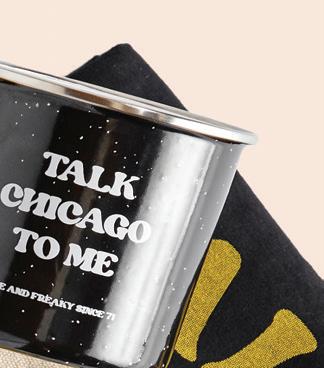
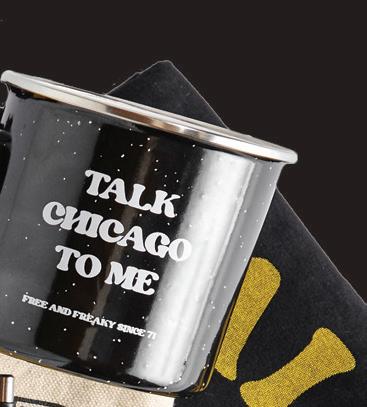



 By Megan Eileen McDonough, Content Strategist at Deskpass Paid sponsored content from Deskpass
By Megan Eileen McDonough, Content Strategist at Deskpass Paid sponsored content from Deskpass



Now more than ever, employees have a hand in choosing where and how they work. The rise of flexible work arrangements allows companies to better foster a diverse workforce, which can great ly improve company culture.

It’s not enough to just attract top talent, though; you have to retain employees, too. That’s where a hybrid work solution—a flexible arrangement where employees can work from home, their office, a coworking space or all three— can help. For many companies there’s no better way to get started than by utilizing a concierge service like Deskpass. When a team joins Deskpass, they have access to thousands of workspaces across the world, including on-demand desks, meeting rooms, and private offices. Employees can filter spaces based on what matters most to them, whether it’s prox imity to their home or varied seating arrange ments, or amenities such as an outdoor space, a game room, or an on-site cafe.
From collaborative meeting space to private phone booths, here are 5 ways companies can use a hybrid work model to care for their em ployees’ wellbeing while on the job.
Collaborative meeting space
Working from home is great, just not all the time. While email, instant messaging, and video conferences can be efficient virtu ally, there’s a certain magic of meeting with your team in person (safely, of course) when inspiration strikes. As more teams adopt a hybrid work approach, having access to col laborative meeting rooms and private o ces is key in boosting productivity and bolstering comradery.
Blue Lacuna in Chicago’s Lower West Side takes a creative approach to community-based programming. Their Banneker Class Room is ideal for learning new skills, sharing quarterly reports, and hosting interactive workshops. Both the classroom and their smaller, 6-person meeting room feature a whiteboard, presen tation display, multimedia connectors, and adaptors.
Private phone booths
Whether it’s meeting with a team member for a regular check-in with a team member or taking a client call, most workers would agree that having access to a quiet or private space matters. This is especially true for those who
work from a common area of a coworking space but need periodic privacy for phone or virtual meetings. In addition to ensuring con fidentiality, a private space blocks no outside distractions, so that workers can fully focus on the task at hand.
A day at Brick & Mortar comes with access to phone booths from ROOM, a company that makes modular products designed for focused work, collaboration, and effective communi cation. Each phone booth features US sound insulation, a built-in desk, motion sensor, ventilation fans, power outlets, and ethernet port. Bonus points to Brick & Mortar for also o ering standing desks and weekend access.
Lactation rooms for moms
Moms everywhere took an extra hit during the peak of the pandemic, with many juggling working from home and round-the-clock childcare. Fast Company reported that in Sep tember 2020 (the start of the first school year after the pandemic hit the US) alone, women dropped out of the workforce at a rate of four times that of men. On top of this, there is the ‘motherhood penalty’—a set of systemic dis advantages women face in their careers after becoming moms.
Spanning three floors of a chic industrial loft, Bond Collective - Fulton Market offers 31,000 square feet of workspaces and win dowed o ces. In addition to a dedicated shower space, moms have access to a lactation room where they can comfortably pump throughout the day as needed. No more pumping in communal bathroom stalls or stair wells where anyone could interrupt.
Outdoor space

Chicago isn’t called the ‘Windy City,’ for nothing, and while winters can be tough they make sum mers all the more sweet. Getting a bit of sun—a crucial source of vitamin D—can do wonders for the mind. While mental health in the workplace
is often overlooked, it should be taken as se riously as physical wellbeing. In fact, the CDC notes


Working From Fulton Market, the shared workspace on the 3rd and 4th floor of The Hoxton Chicago, is e ortlessly inspiring. In ad dition to ergonomic chairs and plush sofas and armchairs, they have an outdoor patio which is what dreams are made of, with lush greenery and twinkle lights dangling overhead. Reserve your space, and take your meetings outdoors or just catch a few rays before your next client call.
Varied seating arrangements
Ask any Millennial or Gen Z what they value most in a work environment, and they’ll say work-life balance. Not only can a hybrid work model increase productivity and decrease stress, it can also empower team members to curate their ideal working environment.
Located in the heart of the vibrant River North neighborhood, 620 N LaSalle offers varied seating arrangements that suit every work style. With communal desks, cozy restau rant-like booths, barstool seating, and private meeting rooms, teams can switch up their work environment as needed. Head to a phone booth for virtual meetings, or gather for an impromptu huddle at a four-top table.
APRIL 14, 2022 - CHICAGO READER 5
that one in five American adults reported mental health issues in 2016.
Deskpass is a hybrid work solution for companies with remote or distributed teams. Through our network of thousands of workspaces across the world, we provide on-demand desks, meeting rooms, and private offices by the hour, day, week, and month. There’s no setup or monthly fees—it’s purely pay as you go. Deskpass is available globally.
620 N. LaSalle
REP THE READER! store.chicagoreader.com
Working F r o m F ulton M arket
SFERA
R5759 N. Broadway (Coming in spring 2022) sferachicago.com @sferachicago
SOON-TO-BE RESTAURANT REVIEW
Sfera Sicilian Street Food ghosts its virtual kitchen
The new brick-and-mortar will feature the signature arancini and a new roster of formerly obscure snacks.
By MIKE SULA
In the Before Times, Daniela Vitale and Steven Jarczyk made a name for themselves selling cheesy, gooey, deep-fried rice balls at farmers’ markets.
Like many nimble food businesses, their Sfera Sicilian Street Food pivoted during the pandemic, jarring sauces and delivering their arancini chilled and ready to reheat at home. In October 2020, things took another turn when they moved into Avondale’s ghost kitchen and introduced an even more obscure Sicilian snack: scaccia, aka lasagna bread. Native to the southern town of Ragusa, it’s a thinly rolled pizza, folded upon itself in multiples, the pasta-like interior layers sheltering strata of marinara and mozzarella, mined with sausage, mushrooms, or roasted vegetables.
It was easily one of the best things I ate that year, and in some respects the partners really came into their own with foods like this in the 200 square feet they had to work with in the virtual restaurant hub, developing recipes for even more rare and unusual (for the midwest) island street food that they featured at catering events: pane panelle, sfincione, and a “Chicago-style” mu uletta, the iconic sandwich whose ancestral origins begin not in New Orleans but in Sicily.
The good news is that these items will be featured daily at their new brick-and-mortar space in Edgewater opening at 5759 N. Broadway, a few blocks from Kathy Osterman Beach. The bad news is the scaccia will not survive Sfera’s escape from the ghost kitchen—at least
not as an everyday indulgence. “Just because of labor,” says Jarczyk. “They take almost 30 minutes to bake. It’s a long process, and we don’t have the seating that would let that be a normal menu item.”
It’ll still appear for specials and special orders, and at least there should be some consolation that Sfera’s new spot will likely be the only place in the city you can get pane panelle, a crispy chickpea fritter sandwich, here served with roasted red peppers and lemon caper vegan aioli.
The pecorino breadcrumb-topped, semolina-crusted sfincione is an exciting development too: the precursor to Italian American focaccia-based Sicilian pizza. And they make the muffuletta their own with a giardiniera
base to the olive salad. Other sandwiches— pane cunzato, or “fixed bread”—are still in development.
Both the traditional and o -script arancini are the focus, of course. The classic core of saffron-scented beef ragu and sweet peas, sharing real estate with the ham and bacon “breakfast” arancini, and in the summer the roasted corn and poblano arancini—among some half dozen traditional and novel varieties in their repertoire.

“Italians tend to cook very strict—like, ‘This is how grandma did it and how you always do it,’” says Jarczyk. “Our food philosophy is not trying to cook like you would in Sicily but cook like a Sicilian would in Chicago.”
One thing that will lean more old world: the new space will feature counter service only— breakfast and lunch at first—with minimal seating but plenty of window space to stand and eat a pane cunzato or cannoli on the fly, “the way they do in Italia,” says Vitale. Her first language was Sicilian-Italian growing up in the latter-day Little Italy around Harlem and Irving Park, and she spent her teenage summers in Sicily. “I ate a lot and went to the beach a lot,” she says. She and Jarczyk are counting on a lot of beach tra c coming through for picnic supplies.
Another few things they’re looking forward to is cooking in a kitchen with some room to breathe, and being able to engage in the faceto-face art of hospitality. As far as they’ve come in three years, they don’t give much credit for their endurance to the ghost kitchen they left last fall. Contrary to the idea that they’re an incubator for big ideas, “the ghost kitchen concept for the most part is a graveyard of small business dreams,” says Jarczyk. “They’ll promise you the world and then absolutely deliver nothing for an incredible price. We are in the hospitality business, and when you’re not given the opportunity to show hospitality as a new business, that’s really hard.”
The front-facing Sfera will open this spring, hopefully “sooner rather than later,” says Jarczyk, allowing that one thing that never changes is that, on the city’s typical permitting timetable, one never knows. v
@MikeSula
6 CHICAGO READER - APRIL 14, 2022 ll FOOD
DRINK
&
Sfera’s owners fi rst made a name for themselves with signature arancini—cheesy, gooey, deep-fried rice balls. KRISTEN MENDIOLA
SICILIAN STREET FOOD





APRIL 14, 2022 - CHICAGO READER 7 What Greta said ... CHICAGO HUMANITIES FESTIVAL 2022 Get tickets: chicagohumanities.org May 7, 10:30am May 1 & 15 Anita Hill & Laura Washington Shermann ”Dilla” Thomas
POLITICS
MAGA delusion
By BEN JORAVSKY
As a habitual reader of four daily mainstream newspapers, I frequently come upon a headline so absurd, it makes me think . . .
This can’t be real. They must be making this up—just to mess with my mind.
So it was on Saturday morning when I came face-to-face with the following headline in an article in the print edition of the New York Times:
“After Grilling Judge, G.O.P. Sees Opening To Win Black Voters.”

The judge in question is Ketanji Brown Jackson, who the senate confirmed as a Supreme Court justice, and the first Black woman to sit on the highest court in the land.
Congratulations, Justice Jackson.
Having read that headline, I’m very curious as to which Black voters the Republicans think they can win over with their treatment of Justice Jackson. Other than people like Candace
Owens, Herschel Walker, and Larry Elder, who are already on team MAGA.
By the way, “grilling” is a euphemism for what Jackson faced from her Republican assailants on the Senate Judiciary Committee and in the media.
They teased her, taunted her, mocked her, maligned her, and rolled their eyes at her.
They said she was unqualified to sit on the bench, even though she’d been a federal judge for eight years, clerked for a Supreme Court justice, and had graduated from the finest universities in the country. Then they really went into the dirt, all but calling her a pedophile because—oh, it’s not worthy to mention their so-called reason. It’s just a toxic byproduct of their warped and diseased little minds.
In short, they trashed Justice Jackson like they trash Vice President Kamala Harris, Congresswomen Maxine Waters, Frederica Wilson, Sheila Jackson Lee, and just about any
powerful Black woman not wearing an I-loveTrump T-shirt.
Keep in mind, Justice Jackson was widely admired, and deservedly so, by a vast majority of Black people in America, who saw her as a role model for their children. Especially Black girls.
So, again, do the Republicans truly think they can win over Black voters by assailing her?
I can’t believe they do. It’s just more bullshit they’re spewing to get in the heads of Democrats and make them feel all is hopeless.
I’ve watched Republicans play this game for years. Every Republican president from Nixon to Reagan to Bush (both of them) was supposedly going to win over the Black vote.
For years, I’ve been hearing how high-profile Black Republicans—from Wilt Chamberlain to Ice Cube—were representative of anyone other than themselves.
And, yet, the vast majority of Black voters remained Democrats, for better or worse.
Look, I realize that not all Black voters are liberals, much less lefties.
Many are conservatives. And there’s a long line of Black Republicans going back to the days of Abraham Lincoln.
But obviously this current Republican Party bears no relation to Lincoln’s. And so, the overwhelming majority of Black voters will vote Democrat because really, they have no choice.
Other than not voting at all. Or voting for a third-party candidate who hasn’t a prayer of winning.
And as an old leftie, I can relate.
I often get upset at Democratic leaders. I’ve been known to rant and rail against party chieftains who push the party right in order to pick up the proverbial swing voters in suburban Virginia.
It irritates the hell out of me that Dems take my vote for granted. That centrists such as Mayor Rahm or Bill Clinton look at lefties like me and say: you’ve got nowhere to go, so shut up and fall in line.
I’m always looking for an overture, no matter how small, from the Republicans. Something that suggests I might have an excuse to vote for them—if only to send a message to the Bill Clintons of the world: stop taking me for granted.
And, yes, once in a long while, the Republicans sorta throw me a bone. For instance, in 2016, when Russian operatives, apparently looking out for Trump, hacked into Democratic Party computers and unveiled emails that party leaders favored Hillary Clinton over my beloved Bernie Sanders.
I was one of those outraged lefties whose resentment was fueled by Trump’s tweets about Hillary betraying Bernie. Like he cared about Bernie or lefties like me.
Those trash-talking tweets were the limit of Trump’s outreach to me. Once in o ce, Trump doubled down on all the inequities by getting congressional Republicans to pass a huge tax break for the richest of the rich.
And ever since, he and MAGA have lumped people like me into a subspecies they call the “radical left.”
We are, they say, an even greater threat to democracy than the “patriots” who overtook Congress in an attempt to overthrow that very same democracy.
That’s right. According to MAGA, people like me are more dangerous than the insurrectionists who overran Congress looking to hang Mike Pence and Nancy Pelosi. You know, because we want health care for all.
And I’m supposed to vote MAGA because Trump trashes the Clintons? I don’t think so. I haven’t lost my mind that much.
My guess is that it’s similar with the vast majority of Black voters. The Trump Republicans have welcomed white supremacists to the fold, opposed voting-rights laws, and attempted to reelect Trump by getting judges or election o cials to throw out hundreds of thousands of votes from Detroit, Milwaukee, Philadelphia, Atlanta, and other cities with large Black populations.
And now Black people are supposed to be attracted to them because they trashed Justice Jackson, a great hero to so many?
That’s delusional.
At best, the Republicans may convince Black voters that all is hopeless and they might as well not vote at all—which is probably the strategy.
If Black voters, or lefties, don’t vote—it’s a win for MAGA. v
8 CHICAGO READER - APRIL 14, 2022 ll
NEWS & POLITICS
The U.S. Supreme Court. AP/J. SCOTT APPLEWHITE, FILE
Republican strategists think they can win over the Black vote by trashing Justice Jackson.
@bennyjshow
Find hundreds of Reader recommended restaurants exclusive video features, and sign up for weekly news at chicagoreader.com/ food.

At the Chicago History Museum, we’re showing off ten neverbeen-displayed treasures from our clothing collection of more than 50,000 pieces. Learn about five stories within the folds of fashion—Stephen Burrows, Scotty Piper, Patrick Kelly, Willi Smith, and Barbara Bates. NOW OPEN!


LEARN MORE AT CHICAGOHISTORY.ORG

APRIL 14, 2022 - CHICAGO READER 9
The Chicago History Museum gratefully acknowledges the support of the Chicago Park District on behalf of the people of Chicago.
SPONSORED BY
CULTURE
Bleacher bummed
Will gambling save the national pastime?
 By DEANNA ISAACS
By DEANNA ISAACS
Something else took me to Arizona last week, but on what the locals considered a pleasant Tuesday afternoon I was in Surprise Stadium, in the Phoenix suburb of the same name, for the Cubs’s final preseason game. They were facing the Texas Rangers. Both teams were wearing Cubbie blue. The temperature on the field was approaching 100 degrees, and attendance was sparse.
After the second inning, a clutch of major leaguers left the Cubs dugout and paraded o the field, gear in tow. Apparently they had a plane to catch.
The rest of us su ered through seven more error-laden innings to witness an 11 to 5 loss by the minor league team we’d been left with.
Nothing on the field approached the impact of sporadic roaring flyovers from nearby Luke Air Force Base that shook us awake. So there was plenty of time to reflect on the future of baseball. Like print journalism, it’s a slow game in a fast world. And outrageously expensive for fans.
Are we already in the ninth inning?
According to Baseball Almanac, television viewership for the World Series dropped from 44 million in 1978 to less than 14 million in 2019. In-person attendance has been declining for years. People are no longer willing to sit for three, four, or more hours to see a few precious minutes of bat-on-ball action. Like dropping a line in the water and waiting for fish to bite,
that’s the thrill of a former, more relaxed time. What to do? In Surprise Stadium they were featuring Face the Cookie challenges on the jumbotron.
That might work, but in case not, out on the concourse you could sign up for the BetTenders app and get some skin in the game. They’re so sure you’ll like it, if you place a $10 initial wager, they’ll give you $200 in credits for future bets.

After a century of aversion that included banning Pete Rose and ousting the Black Sox, Major League Baseball is betting that this is the future of the game. Credit a 2018 Supreme Court ruling that cleared the way and estimates that $35 billion or more was
being wagered in illegal bets on baseball every year—estimates that had baseball owners, taxing bodies, and, most of all, the gaming industry salivating.
It wasn’t news around here. Before the Bleacher Bums became a play (dreamed up by Joe Mantegna and written and produced at Stuart Gordon’s Organic Theater in 1977), and a cable TV movie (in 2002), they were real Chicagoans, entrenched in the cheap seats at Wrigley Field. They operated in a cloud of cigar smoke and a profusion of curse words, betting each other as little as 50 cents on everything from pitches, hits, and win margins, to whether, when the umpire threw the ball to the mound to launch a new inning, it would land on dirt or grass.
I’m not a baseball fan, but I live with three generations of them—former high school and college players, and diehard lovers of the game. They say the betting that went on in the bleachers then was a richly social activity, the game providing the platform for intense personal interaction. In contrast, they say, the online betting that’s replacing it will have heads buried in phones, the interaction—like so much else today—only between “man and machine.”
Still, it might be a lifeline. The fan connection to individual players has been broken since the advent of free agency and multimulti-million dollar contracts. (As I write this, former Cubs favorite Kyle Schwarber’s swinging his bat for the Phillies and Anthony Rizzo’s at first for the Yankees.) And, since the mind-bending events of 2016, the Cubs’s long-running lovable losers mystique is gone. They’re just another contender now, while the fans—hungry for an active role—are the stars of their own experience. Skin in the game, even machine-managed, will count.
Betting is a cheap thrill and an expensive addiction but it might su ce. v
10 CHICAGO READER - APRIL 14, 2022 ll
&
NEWS
POLITICS
Scenes from Surprise Stadium in Arizona during a Cubs preseason game DEANNA ISAACS
@DeannaIsaacs
A Porch in Chatham
By Alexandria Valentine
Alexandria Valentine is a South Side Chicago born artist. Their practice engages the archive, writing, collage and photography to explore Black Latent Thought, the Black Romantic and ancestral landscapes. Valentine’s excavation of the archive serves as a tool to explore the past, create pathways to the future and peer at the spaces in between. Alexandria received a Master of Fine Arts in Fiction from Columbia University School of the Arts and a Bachelor of Fine Arts in Creative Writing from the School of the Art Institute of Chicago.
Poem curated by Jada-Amina. Jada-Amina is a South Side Chicago born and based, Black Indigenous American singer, writer, and cultural worker.
A biweekly series curated by the Chicago Reader and sponsored by the Poetry Foundation.








The porch steps peel in every season. In the winter ice and snow devour the paint. In the spring, harsh rains tear it apart and in the summer heat draws it into bubbles that crack and pop. I am sitting on the cracked paint listening to bees talk and the radio is playing from inside the screen door. My father is frying fish and fries and reaching to the back of the freezer for sherbet. My mother is walking through the house signing to herself, not because she is sad, because she has a song. The heat has a smell and everything is alive. The breeze grazes my knees as if reading my mind. The smell of grease emanates from the kitchen and it’s a sign that life still exists. Hours
Wednesday and Friday: 11:00 AM– 4:00 PM Thursday: 11:00 AM–8:00 PM
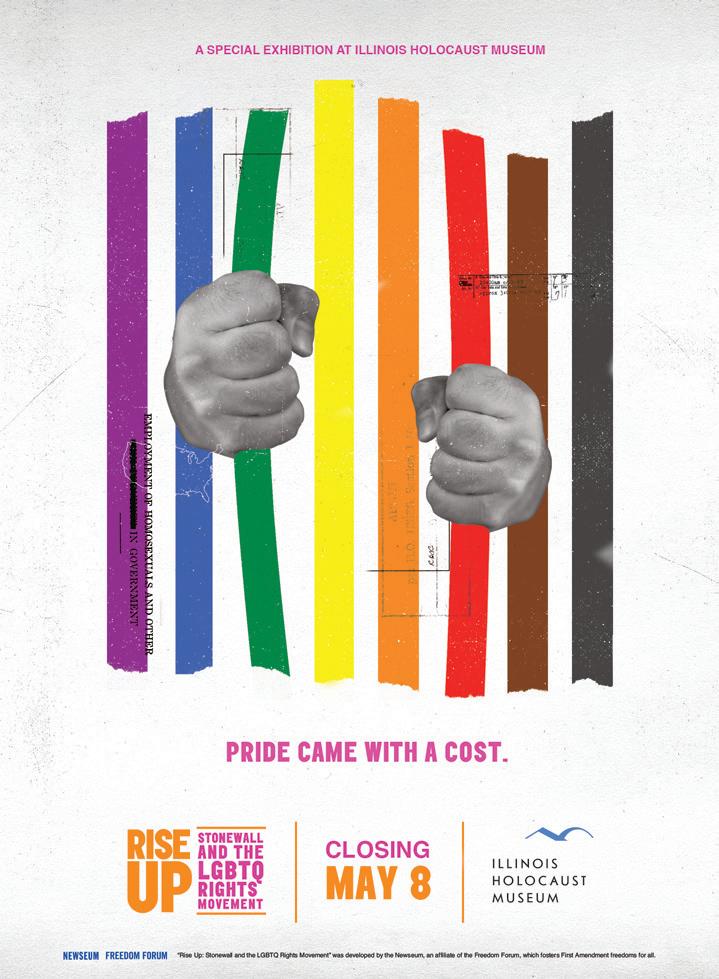



Open Door: Madeleine LeCesne, Michell Miller, Nat Pyper & Ang Zheng (In Person)
Highlighting outstanding Midwest writers and poetic partnerships Thursday, April 14, 2022, 7:00 PM




Exhibition Opening for Monica Ong: Planetaria (In Person) Celebrate the opening of our new exhibition, blending poetry and the night sky Thursday, April 21, 2022, 7:00 PM

APRIL 14, 2022 - CHICAGO READER 11
Poetry Month with the Poetry Foundation!
more at
Celebrate
Learn
PoetryFoundation.org
235 pages / perfect bound / 5.5” x 8.5” size Available in paperback and PDF download chicagoreader.com/store
FREE ADMISSION KIDS & STUDENTS THROUGH
Ben Joravsky’s Greatest Hits is a collection of profiles and features hand-picked by Ben from his 40 years of writing for the Reader. Each article
offers a distinctive portrait of an activist, politician, writer, or sports personality who has left an indelible imprint on Chicago.
4/17
LABOR
Brewing solidarity
Baristas in Chicago are joining a union wave that’s sweeping Starbucks nationwide.
By AMY QIN
About three weeks before Christmas, the sticker machine that prints out mobile orders for Starbucks was jammed, yet again. Customers were getting impatient, and Maria Fantozzi was behind on multiple orders.
“If only we had a union,” the 23-year-old barista joked to her coworker at the Logan Square Starbucks, 2543 N. California, as she tried to fi x the machine, which had been broken for months. Starbucks still hadn’t replaced it, despite multiple requests.
Fernando Vargas-Soto laughed. “Wait, but really?”
The 27-year-old shift manager was closely following the union drive in Buffalo, New York. But this was the first time he heard from his coworkers about a union.
“Yeah really,” Fantozzi replied, not realizing that her o and remark would set in motion a long, drawn-out challenge to organize their store.
At the time, it still seemed as if all eyes were on Bu alo, watching David take on Goliath as baristas there pursued the improbable. Starbucks employees tried to organize in the 1990s in Seattle and British Columbia, in the mid-2000s in New York City, and in 2019 in Philadelphia, but the company quashed those e orts.
When the Buffalo baristas voted 19-8 to
unionize in December, that set o a wave of similar e orts that soon grew into a deluge. After Bu alo, it “really started to take o ,” said Brick Zurek, a barista at a Starbucks in the Loop. “Mesa, Arizona, got on board and it started to look like they could really win.”
Stores across the country began following the Bu alo baristas’ lead by fi ling for union elections with the National Labor Relations Board. Organizers at six stores in Chicago —2543 N. California, 155 N. Wabash, 1174 E. 55th, 2101 W. Armitage, 5964 N. Ridge and 1070 W. Bryn Mawr—have collected enough union authorization signatures to qualify for
a union election with the labor board, while baristas at dozens of other stores in Chicago are quietly working to build union support behind the scenes.
As of publication, workers in at least 175 Starbucks stores across the country have filed to hold union elections, and 17 stores have won a union.
There are about 9,000 Starbucks stores nationwide, but what baristas have managed to achieve in the scores that have fi led for union elections so far is no small feat. Private-sector union membership is at an all-time low, especially in the food service sector, where

less than 2 percent of workers are members of a union. And in response to organizing e orts, Starbucks has waged one of the most aggressive corporate anti-union efforts in decades.
The success of the campaign boils down to the grassroots, worker-led movement made of “people with a lot of guts,” who contacted Workers United in the wake of the Bu alo union drive despite knowing the odds weren’t necessarily in their favor, said longtime Chicago labor activist Pete DeMay, who is midwestern organizing director for Workers United, the union representing Starbucks
12 CHICAGO READER - APRIL 14, 2022 ll NEWS & POLITICS
Brick Zurek, a barista at a Starbucks in the Loop, said that workers there organized a union in part because management ignored their safety concerns. MICHAEL IZQUIERDO
workers.
“It’s a worker-to-worker campaign,” DeMay said. “They create a lot of relationships organically on their own.”
Vargas-Soto and Fantozzi hit it off as friends soon after they met. They “quickly realized that we see eye-toeye on a lot of things,” said Vargas-Soto, a DACA recipient who is studying elementary education.
Both liked working at Starbucks, but were keenly aware of the growing gulf between themselves and the corporate bosses they worked for.
“I’ve always been angry about it, but it really escalated during COVID when we are literally putting our lives on the line to make them money, and they won’t even pay us a living wage,” said Fantozzi, who had graduated with a degree in political science in the spring last year and was working at Starbucks between job hunting for nonprofit work.
Former Starbucks CEO Kevin Johnson made $20.4 million last year, a 39 percent raise from his 2020 salary. Fantozzi and Vargas-Soto made a little over the hourly minimum wage of $15 an hour that Chicago mandated for employees at companies the size of Starbucks.
A few days after the pair met, Vargas-Soto sent a message to the Starbucks Workers United Twitter account and got connected with DeMay, who walked them through the union process, shared a few informational handouts, and sent them union cards. DeMay cautioned them that, “Despite the progressive veneer, [Starbucks] is a cutthroat company that takes a renegade approach to the law.”
After hearing about the aggressive anti-union tactics that Bu alo baristas faced, Vargas-Soto said that “the fact that it’s possible to create a situation in this company where things are so bad, and to see workers get treated the way that they have been . . . it really motivated us to stand in solidarity.”

A few weeks later, Vargas-Soto would meet Zurek, a 25-year-old barista at the Loop store. The baristas there had been dealing with violent customers almost daily at their store but weren’t getting the support they needed from Starbucks.
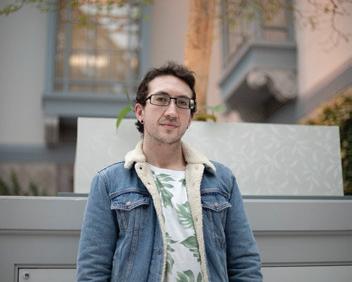
A customer threw scalding water at their manager, and female coworkers were constantly being threatened with sexual assualt.
Starbucks corporate hired a therapist to sit in the store’s lobby for an afternoon, but didn’t
schedule extra sta on the shift so that baristas could find time to talk to the therapist, Zurek said. The fi nal straw came when a man threatened to return with a gun and “come back here and kill you all.” The store closed early that night, but continued to stay open after dark that week. When, out of concerns for their safety, the baristas asked management to close the store early, Zurek said an upper manager dismissed her and said, “I’m not downplaying it, but you have nothing to worry about.”
Zurek had started to talk to their store about a union a few weeks before. People were supportive but still on the fence. “Then this incident happened and then it was like, OK everybody’s signing the cards,” they said. “This monumental disrespect and disregard for our safety just pushed everyone over. It became like, ‘We need to do this for our safety.’”
With the exception of two partners (what Starbucks calls employees) who were on vacation, the Randolph and Wabash store’s workers fi led unanimously for an election on December 30.
“We are listening and learning from the partners in the stores, as we always do across the country. From beginning to end, our belief [has been] that we are better together as partners without a union and that conviction has not changed,” a Starbucks spokesperson told the Reader
By mid-December, the Logan Square store was buzzing with talk of a union. Vargas-Soto, Fantozzi, and a few other partners started an informal organizing group of people who expressed interest in taking an active role in unionizing.
They made plans to talk to everyone in the store. Organizers would casually bring up the idea of a union when the store wasn’t busy, and continue the conversation on the phone at night so management wouldn’t get wind of what they were doing, said Emilia Fenzil, 25, who was excited to be helping out with the union when she heard about it from Vargas-Soto.
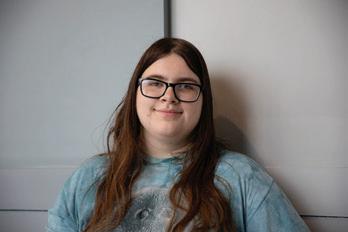

It wasn’t hard to fi gure out who was for or against the union, and most partners didn’t take much convincing. A lot of the conversations, Fenzil said, just involved clearing up misconceptions about what forming a union would entail stemming from what Starbucks had started telling partners about unions, such as emphasizing that no existing benefits would be taken away without their consent.
By early January, the group had gathered more than enough signatures to meet the NLRB threshold of 30 percent of the potential bargaining unit, and on January 7, 2022, the Logan Square store officially went public with the union and filed a petition for an election with the NLRB. Fourteen partners signed a letter addressed to Kevin Johnson, Starbucks’s then-CEO, sent it to their district manager, and tweeted it out on the Workers United account. Then, they stood at the ready, waiting for whatever Starbucks was going to throw at them.
On January 10, Starbucks requested the labor board consolidate the Chicago elections by district, arguing that a single store is not an appropriate bargaining unit. The board will hold a hearing to decide whether to accept or deny that request. The NLRB is expected to rule, and has ruled, in the union’s favor before, but “Starbucks is taking advantage of the fact that it takes a long time to render those decisions, and that’s why it’s a stall tactic,” DeMay said.
Aside from the legal challenge, which employees had expected, the next few weeks at the store were eerily quiet.
But it was the calm before the storm. At the end of January, Starbucks began sending anti-union language to the store’s group chat and flooding the store with outside managers. Their district manager, who normally visited once a month at best, would come in three or four times in a week. One afternoon, six managers sat in the store’s lobby for hours, watching partners on their shift.
“I’m here all the time because I love this store so much, you can come to me with anything,” the district manager told Fenzil. The district managers would pull partners into one-on-one conversations, suddenly curious about where partners went to school, what they studied, even how many siblings they had.
The purpose of the meetings, said a Starbucks spokesperson, “is to answer any questions that they have and give them the information that partners need to make a decision.”
Management almost never pulled the union organizers aside, said several partners the Reader spoke to, who believed they were using the one-on-ones to plant seeds of doubt in partners who they thought were on the fence.
Sara Spry, 27, was one of the fi rst baristas to sign a union card after Vargas-Soto approached her about it in early December. She

APRIL 14, 2022 - CHICAGO READER 13
NEWS & POLITICS
(From top) Fernando Vargas-Soto, Brick Zurek, Maria Fantozzi, Sara Spry, and Jasper Booth-Hodges helped organize union drives at Starbucks across Chicago . MICHAEL IZQUIERDO
was also one of the few pro-union partners who was good friends with the baristas who opposed the union—most of the anti-union partners were more tenured at the Logan store, said Spry, who had worked there since the summer of 2020.

Spry knew relationships were already starting to strain. Balancing her friendships while knowing some of the anti-union partners were “talking smack” about people in the union “hurt my heart,” Spry said. “When I see good people having bad things said about them, that’s not fair, it’s just not right.”
Her anxiety over the divisions came to a head on February 4, when her district manager and store manager called Spry and three anti-union partners for a “co ee tasting” in the back of the store.
The managers had a small table set up with a French press, a few paper cups, and printouts with notes on the flavors of the co ee. “What’s bergamot?” asked one of the baristas. “Oh, it’s like in Earl Gray,” Spry said.
It was an awkward a air—they all knew why they had been summoned during their shift.
Finally, the district manager addressed the elephant in the room. “‘We just wanted to have this meeting to see how you guys are feeling during this time and to talk about anything that might be on your mind,’” Spry recalled them saying. “‘We want to continue to have dialogues like this with you, and it’s possible that with the union, we may not be able to do things like this.’”
For the next hour, the anti-union partners each voiced their concerns about joining the union, some more vocally than others. Spry tried to stay silent, not wanting to alienate her friends, but also feeling isolated. At one point, someone asked whether they could transfer stores if the store became unionized, and the district manager told them that in a store in Canada, they forced a number of partners to quit and be rehired at a non-union store, an answer that visibly upset that partner, Spry said. She left the meeting afraid that “the bonds in our store were starting to break over the union.”
Fenzil had walked by while the meeting was ongoing, and texted Spry right after to check if she was okay. Spry saw in the union group chat they already knew about the meeting, and were assuring her to not let what their managers say get to her and to stay fi rm.
Although she was rattled, Spry said that the entire meeting only reiterated why a
union was necessary. “A union rep can be there with you,” she said. “These kinds of meetings are very stressful when you’re alone.”
Tensions in the store began to spike in mid-February, when hours were cut for almost everyone in the store, a change that the company seems to have made, according to Workers United, at stores across the country. Workers United also filed an unfair labor practice charge, alleging that cutting hours was an illegal retaliation against pro-union employees.
Partners in Chicago and across the country are struggling because of the reduction in hours, and some are at risk of losing critical benefits because their hours have dipped too low to qualify for health insurance.
“We always schedule to what we believe the store needs based on customer behaviors, and that may mean a change in the hours available, but to say we’re cutting hours wouldn’t be accurate,” said a Starbucks spokesperson.
When the Reader asked what was accurate to say about the change in scheduled hours, the spokesperson said, “like many industries, there are busy seasons and there are slower seasons, the holidays, summer, those are always busier times and the winter months are a bit slower. We schedule to those needs based on customer behavior, you know, it’s cyclical.”
“The only reason I’m able to make it by the past couple of months is because I have my tax return and my stimulus check fi nally came, but once that runs out I’m going to have enough money to pay for rent, gas, WiFi, electricity, and that’s it. I won’t have money
for food or to spend on myself,” said Fantozzi, who has lost an average of ten hours per week since February.
The reduction in hours came at a time when three partners had just left the Logan location, so the store was short-sta ed, and business was getting busier, Fantozzi said. On some shifts there were only half the usual number of employees on the floor, Spry said.
Pro-union workers were increasingly blamed by upper management for harassing anti-union employees. They said management started writing them up for minor infractions that would have never been enforced, or noticed, before. Others were afraid they were going to get fired after seeing baristas in other locations lose their jobs.
“They’ll create situations where people have less hours and things are really hectic, and then they’ll purposely blame it on the union, even though it is Starbucks doing it,” Fantozzi said. “Starbucks has really played into this psychological warfare, like, they will organize your coworkers against you.”
But she adds that the company’s efforts have only strengthened her resolve.
“The more Starbucks tries to union-bust, the more we obviously feel the need for a union,” she said. “You know, they’re cutting hours and there was nothing stopping them from cutting hours in the past for any reason. There’s nothing stopping them from doing it now.”
Four months have passed since the Logan Square store filed for an election, and two months since the NLRB held a hearing for the three Chicago stores on Starbucks’s appeal to consolidate elections. Both Starbucks and
the union have filed post-hearing briefs.
Starbucks stores in LaGrange—which fi led a week after the Logan Square store did— Cary, and Peoria have received their election dates; their ballots went out on April 5 and 6 and will get counted on May 6 and April 26 (for Cary and Peoria), DeMay said. “We expect [an election] soon, but we’ve been saying that for months.”
“We’re all waiting to hear for an election date,” Fantozzi said. ”We’re all just holding our breath.”
Tensions in the Logan Square store have subsided in the last few weeks, especially as the weather has warmed up and the store has gotten busier. Partners have begun putting their di erences aside and focusing more on the work at hand, Spry said.
But baristas in the organizing committee have also been working to repair the relationships in the store. Fenzil organized an active listening session on Zoom and invited all partners in the store; even a few who were opposed to the union attended. Some were more tenured and worried about what changes the union would bring. Others supported unions but didn’t believe one was right for Starbucks. Fenzil had a presentation ready and answered questions from partners who were opposed to the union about dues and benefits.
“The listening session went really well,” Vargas-Soto said. “Everyone was incredibly respectful, and patient, and kind in how they approached it. That really helped bring everybody a little closer together even if we weren’t agreeing on whether or not to vote for a union.”
Despite the risks, the setbacks, and the stress of trying to unionize at a company that desperately doesn’t want you to, the Starbucks organizers say that what they’re fi ghting for is completely worth it.
“Every year there’s higher expectations, the demand for profits increases, cost of living keeps getting higher, and money is funneling upwards. At least the way I see it, this is our way of taking things back,” said Fenzil, who now sees herself staying at Starbucks for a while, especially if they win a union. The journey to unionizing has made her job much more fulfilling than she initially expected when she applied.
“If what I’m doing inspires someone else to stand up for the treatment they deserve, that’s a good thing and I’m honored to be part of that.” v
14 CHICAGO READER - APRIL 14, 2022 ll
@amyqin12 continued from 13 NEWS & POLITICS
Zurek, Booth-Hodges, and Vargas-Soto met a er the Starbucks stores they worked at in the Loop, Woodlawn, and Logan Square independently voted to unionize. MICHAEL IZQUIERDO



APRIL 14, 2022 - CHICAGO READER 15 LGBTQ+ For the safety of our community, masks and face coverings are still required in our clinic spaces. Call 773.388.1600 to schedule today. In-person & telehealth appointments now available care where you are Find hundreds of Reader-recommended restaurants at chicagoreader.com/food.
Motherfuckin’ back and forth
Four Chicagoans describe what it’s like to seek shelter on the CTA.
By KATIE PROUT
Last month, standing at a lectern on the platform of the Chicago-State Red Line stop, Mayor Lori Lightfoot, Chicago Police Superintendent David Brown, and CTA President Dorval Carter, Jr. announced a plan “designed to improve public safety and security for Chicago commuters.” The plan includes two new
contracts, worth a combined $71 million, for unarmed private security guards to enforce the CTA’s Code of Conduct, and “strategically adjusting resources” from within the Bureau of Counterterrorism to increase surveillance and policing of the Blue and Red Lines.
Because they run 24 hours, those two lines also serve as vital overnight shelters
for many Chicagoans experiencing homelessness, who are frequently separated from “other” CTA commuters in ongoing conversations about public safety, despite paying the same fares. Hiring more security guards to enforce the Code of Conduct—which prohibits behaviors such as sleeping or camping on CTA property, alarming or disturbing others,
and loitering—could increase the risk of ticketing and arrest for people using the CTA for shelter.
As Steve Berg writes for the National Alliance to End Homelessness, “While su ering in plain sight, and making many housed people feel uncomfortable, the vast majority of homeless people, including people with mental illness, aren’t hurting anyone.” Indeed, research shows that people experiencing homelessness are seven to ten times more likely to be victims of violence than their housed counterparts.

I interviewed four Chicagoans who use the CTA for shelter to find out more about why they use the trains, and what they think about the current debate around policing and safety on public transit. Their accounts have been edited for clarity and length.
On Thursday, March 24, I sat down for lunch at the McDonald’s on LaSalle and Jackson with Jeff, a white man in his 60s. One summer day nearly three decades ago, Jeff came down from Kenosha for an off-the-books construction job. That night, the truck left without him, and without paying him for the day’s work. Looking for help, Jeff walked from the suburbs into the Loop. He’s struggled with housing ever since.
I met Jeff last year, when he was a resident of the Ewing Annex Hotel. These days, he moves between Lincoln Avenue motels, the CTA, and in a tent he’s pitched at a small green space downtown. Jeff’s words follow:
Iused to stay on the Red Line, but then I switched to the Blue Line. But it’s getting just as bad as the Red Line now. I used to stay on the train; now sometimes I stay on the platform. It’s a closed platform between Monroe and Jackson that they’re not using. I would stay there. There’s a plug where I can plug my phone in and all that. They got WiFi under there too. The first time I stayed there was maybe six months ago. I went back there three days ago.
I don’t do shelters. I’ve gotten in fi ghts there. They got too many rules. I don’t like the people that are there—they’re usually troublemakers. So I prefer not to be in a shelter. I’ll stay out in the cold before I stay out in a shelter.
The first time I stayed on the train was . . . man. It was years ago. Many years ago. It was probably close to my last time there, too.
[Jeff witnessed a violent mugging soon after he began staying on the Red Line that left him shaken.]
So I have a hard time staying on the Red Line
after that happened.
A month ago, I was on the Blue Line at about 2 o’clock in the morning, going to O’Hare because they said you could stay at O’Hare. Almost every car had homeless people on them. They were laying around, had blankets on. It was cold.
And they stopped at Cumberland, and security guards got everybody o the train. It must’ve been about 60 homeless people. They stayed right there until everybody was o . There was another train coming back the other way. They wouldn’t take nobody to O’Hare.
Now the city is putting more money into policing the CTA. There was like four cops at the Jackson stop. I talked to them, I told them I needed to charge my phone, I’ve stayed down there and stuff. They know I got my bag, they leave me alone. Now they got this security guard, they’re kind of difficult. I don’t think they’re doing much.
As far as people messing with people: if staying on the CTA was safer, I think more people would do it. But a lot of people know about the pickpockets and people beating up on people, so they don’t do it.
It’s obvious why people stay on the train: they ain’t got nowhere else to stay out of the elements. People sleep on the train for warmth, heat, to stay out the rain, out the cold. If you pay to get on, why not? You’re paying to get on, you’re still a customer. You just want to ride around, so what?
Even people who ain’t homeless fall asleep on the train. How many people get on the train, have a house, have a place to go to, plan on getting o at a stop, and then fall asleep and miss their stop?
16 CHICAGO READER - APRIL 14, 2022 ll
NEWS & POLITICS
paying to get on, you’re still
You
— Jeff LLOYD DEGRANE
“You’re
a customer.
just want to ride around, so what?”
HOUSING
Later that night, I went to the Forest Park Blue Line stop. From around 8 PM to midnight every Thursday, staff from The Night Ministry are out on the lower platform, providing free health care, harm reduction supplies, and outreach services to anyone who needs them. There, I met T, a Black man in his 50s with a quiet, passionate voice and a slight stutter, while he was in line to fill out paperwork for a new state ID. (IDs are required to obtain housing, Medicaid, and other benefits, but many people who are homeless don’t have one, and the application process can be a significant barrier without advocate support). T grew up on the west side, and has been staying on the CTA for shelter since last winter. He misses his kids and family, and asked to use my phone
after our interview to call his cousin. T’s words follow:
Homeless people is not the ones that doing the crime—I mean, it’s guys that get on the train, they get on there and take stu . That’s what they do. We get on the train, we just trying to make it to daylight the next day. Why would a homeless person wanna start something he knew he ain’t got no win in? It doesn’t happen like that.
Homeless people don’t mess with nobody. They don’t do that. What they gonna do that for? It’s not beneficial, it’s not gonna help them at all.
I stay overnight on the Blue Line. It’s a place to stay. You do have people on there that are
your friends, that you might say are your friends. I never stay on the Red Line.
[T says he rides the Blue Line to O’Hare; unlike Jeff, he says he’s never been forced to depart the train before that last stop.]
I’m really tired right now. You gotta make sure that you got your things, because people be along and take your stuff. I had a fight on the Blue Line a couple weeks ago. That’s how I got my hand messed up. They was high, getting high. They hit me with a stick. I’m glad they didn’t break my nose. They took my stu in a bag.
If police and security guards are gonna be on the train to kick a few homeless o , it’s gonna be a problem. That’s all I’m saying. At least sometime, they gotta understand, we just have
nowhere to go. There’s a lot of property out here, buildings out here, they should do something about. Everybody can’t live in Pacific Gardens.
Homeless people don’t have anywhere to go. We really gotta try to get back to reality. That’s the thing that’s gonna give you a normal living, you know? Riding on the CTA train is not normal. You have to do it if you have to do it. We are very fortunate that the Blue Line runs all night. Very fortunate. If it didn’t run all night, can you imagine where all the guys, all the people would be? Can you imagine? Can you imagine?
You know what they’d be doing? They’d be breaking into abandoned buildings. It’s really a blessing that you got that train running 24 hours.
After T finishes calling his cousin, I meet Brian, a white man in his 50s who grew up in Tinley Park. A veteran with an active addiction, Brian tells me he’s overdosed more than a dozen times. He sets bags of food, clothes, and harm reduction supplies from The Night Ministry at his feet while we talk. His left foot is in a boot brace. A month ago, Brian says, he got jumped on the platform of the Jackson Blue Line stop, and his ankle broke when he was pushed to the ground. Brian’s words follow:

Isleep on the Blue Line. Just ride the motherfuckin’ train motherfuckin’ back and forth. However, I’m working on getting this little apartment. Well, I’ve got the apartment, but I’m splitting it with someone. I’m trying to break totally away from drugs, and I keep seeing needles and shit on the table. Gotta get that out of the equations.
I’ve stayed on the train on and o for ten years. I’ve been robbed, yeah. Gun right to my head, ch-ch . Someone tried to take my shit. Sometimes if I take too many pills, like benzodiazepines, Xanax—it knocks you out completely.
It is absolutely not true that homeless people are why crime is rising on the CTA. A lot of the homeless people, they get out every day and work hard, shake their cup, try to make money and take care of theirself. But that’s just another propaganda we’re reading, un-
fortunately. I would debate this for an hour. There’s some bad apples, I get it. But there’s bad apples at Pacific Gardens, and that’s Jesus-rollin’, you know what I mean?
Why do homeless people get blamed? If you’re homeless and sleeping on the train, you can’t rob nobody. There are other people. I see how they do and how the whole operation works. They wait until you’re real close to the station. Just tapping away, tapping away, as soon as the door opens up, boom. They grab your phone and run into the dark until they’re gone.
There are several reasons I don’t stay in a shelter. A, You still can get your belongings stolen. B, we’re not over this COVID yet. C, you gotta worry about getting bedbugs, and D, if you ever do get a shower, it’s ice cold, the water’s ice cold. The food, you know—you know what? The animals eat better, I’ll put it that way. And that’s not fair, you know, a motherfucker’s down on their luck.
Let’s fi gure out what the root cause is for why you’re homeless. Don’t beat up on yourself. It’s something in your past that happened. When you were growing up, you didn’t tell your mom, your dad, your school, “What color’s your daddy’s eyes?” “Blue.” “What color’s your daddy’s eyes?” “Green.” When it comes to my daughter, it’s “What color’s your daddy’s eyes?” “Red.” [Laughs a little.] You understand?
“Let’s fi gure out what the root cause is for why you’re homeless. Don’t beat up on yourself. It’s something in your past that happened.” — Brian LLOYD DEGRANE
APRIL 14, 2022 - CHICAGO READER 17
NEWS & POLITICS
A week later, home in my apartment, I called Kelly, a white woman in her 40s. I met Kelly when I was working on a story about the Loop’s Pigeon Lady. The day I first interviewed her was, coincidentally, her last day using the CTA for shelter: the next morning, she picked up keys to her first apartment in six years, an efficiency she shares with her boyfriend Marcus. Kelly’s words follow:
My first experience staying on the CTA was in 1999. I was 19. I last stayed in December 2021. I used to do the Blue Line. I did do the Red Line a few times. They’re really both dangerous, but for some reason I think the Red Line is more dangerous. I’d stay from anywhere around 9 PM to midnight, I’d get on the train, and then around 6 or 7 AM is when I would get o .
I did it for a couple months each year. I would start in the middle of November, and stop in January, sometimes February, depending on the weather. There were some days when I stayed outside, and other times I’d sleep on the train. I have my boyfriend: he
was with me most of the time, which made me feel a little bit safer.
You’re talking about the homeless people being a problem on the CTA. We wanna be dry, and sometimes homeless people are scared to sleep outside. But the homeless people are actually, I believe, more the victims than the suspects.
It’s ridiculous. I have gotten so, so many backpacks stolen from me while I fell asleep. I would try so hard to not sleep so hard. But sometimes when you’re up all that time, your body is just so exhausted. I’ve always said this: like, whatever is in my backpack, or any homeless person’s backpack, probably is not useful to a “normal” person.
Sometimes the CTA people try to get all the homeless people onto one train. Let’s say you get to the end of the line at Forest Park. [CTA workers] say, “Oh this train is not working, so the next train going out is the one, you know, on the next track. So everybody to the next track.” So the homeless people move to the next train and go back and forth. But then, along the way, of course they pick up more homeless people on the di erent stops. And
then, when they get to O’Hare, they try to do the same thing. They’ll wake you up at the end of the line, make everybody get up and move to another train. Sometimes, if they see this whole train is homeless people, they’re like, “Man, don’t bother ’em, don’t even wake them up, just let ’em sleep.” This way, the regular people, the non-homeless people who are taking public transportation are separated from us.
It’s very annoying. I’ve even gotten into arguments with security guards. Like in the winter, you get to Forest Park, it’s outside at the Blue Line. They’re assholes. There’ll be a train sitting there, nobody will be on it, doors are shut. And we’re all standing there freezing cold. Sometimes they’ll do that for a half hour, 40 minutes. And we’ll say, “What the hell, open the door!” And they’ll say, “This train is out of order. The next train, that’s the one going back out.”
Sometimes I feel like they just do shit to be deceitful and discriminate against homeless people. It is discrimination! I know there’s a lot of homeless people that are alcoholics, or drug addicts, and a lot of them do their what-

ever openly on the train, and it probably gets the other passengers irritated.
I’ve been asked many times why I stayed on the train and not in a shelter. And this is what I say. The shelters are very dangerous, just like on the streets. They’ve got thieves, they’ve got people that are dangerous, they have bedbugs—it’s not a place that I’ve ever found comfort to be in. I’m already homeless, miserable, going through something. So why would I go out to another place, you know what I’m saying? And be more miserable?
If I lost this apartment, I would probably not stay on the CTA again. It’s gotten so bad. Now they’ve got some kind of new security supposedly, and if it works out and is really making it safer, then I would say OK. But other than that, honestly, I feel safer just making a pallet on the ground and sleeping outside.
I just want people to know that it’s not always the homeless, you know? People who take the train back and forth to work, you do not have to be scared of the homeless. v
18 CHICAGO READER - APRIL 14, 2022 ll NEWS & POLITICS
@katie_prout continued
from 17
“Sometimes I feel like they just do shit to be deceitful and discriminate against homeless people.”
— Kelly LLOYD DEGRANE
THE WAY TO PL AY ONLINE













































































































CHICAGO READER 19
FASTPLAY® AGS LLC.
Political rift opens on the southwest side
BY KELLY GARCIA

Apolitical battle is emerging between candidates running to represent the southwest side in Springfield. State senator Celina Villanueva—a vocal leader for immigrants’ rights—is being challenged by Pilsen resident and first-time candidate Javier Yañez.
In early March, Villanueva was invited to speak about her campaign at a meeting of the 25th Ward Independent Political Organization (IPO) in an e ort to win their endorsement. Sources told the Reader that IPO members were not satisfied with some of her responses.
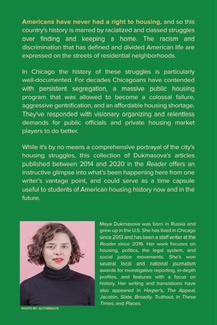

The following morning, Yañez—himself a member of the 25th Ward IPO—launched his campaign for state senate. He was able to get enough petition signatures to get on the ballot by the March 14 deadline for established parties. Yañez is 25th Ward Alder-
person Byron Sigcho-Lopez’s chief of staff; Sigcho-Lopez denied encouraging him to run against Villanueva.

Yañez was born and raised in Pilsen and was elected to Orozco Community Academy’s Local School Council in 2020 as a community representative, but will not be seeking reelection to the LSC. Yañez says that if he’s elected to the state senate, he wants to tackle issues related to public safety and economic development.
Villanueva, a Little Village resident who represents the 11th district in the General Assembly, is running for reelection in the newly drawn 12th district, which now includes Pilsen, Bridgeport, and Chinatown, in addition to Little Village, Brighton Park, and McKinley Park.

“I believe the 12th district deserves independent, accountable, and elected leadership and that’s a big part of why I’m running,”
Yañez said.
His primary challenge reveals growing friction among progressive Latinos on the southwest side. Villanueva is a close ally to Chuy Garcia, a long-time community activist who has represented the area for decades as an alderperson, state senator, Cook County commissioner, and now U.S. congressman. Garcia’s progressive coalition on the southwest side is expanding amid a power vacuum created by the federal indictment of the oncemost powerful Democrat in the state, former house speaker Michael J. Madigan.
Garcia endorsed Villanueva in the state senate race. Yañez previously worked as an aide to Garcia when the congressman was a Cook County Board commissioner.
The General Assembly is divided into two legislative bodies, with 59 members in the state senate and 118 in the house of representatives. Both groups work closely with the governor to pass legislation and decide how
your tax dollars are spent.
In 2018, local party leaders appointed Villanueva to fi ll a vacancy in the house, and she kept her seat in the following election. She was appointed to the senate in 2020 after former state senator Martin Sandoval resigned amid a corruption probe.
Villanueva has been a vocal leader for immigrant workers’ rights. Earlier this year, she introduced a bill that would establish stronger penalties against employers who violate workers’ rights to a 24-hour rest day each week. Recently, Villanueva introduced legislation that would allow noncitizens to vote in school board elections across the state.
“I’m somebody that values community and the belief that we need to fight to have our voices heard and that’s why I’m running for reelection,” Villanueva said. “I feel like I have a long list of accomplishments and I still have a lot more to do.”
The 2022 Illinois primary is on June 28. The general election is on November 8. v
20 CHICAGO READER - APRIL 14, 2022 ll
@_KellyGarcia__ NEWS & POLITICS
State senator Celina Villanueva PHOTO COURTESY OF CANDIDATE
POLITICS
State senator Celina Villanueva faces a primary challenge from Byron SigchoLopez’s chief of staff.
chicagoreader.com/mayabook The new book from Chicago Reader’s own Maya Dukmasova Available in paperback and PDF download A HOME IN CHICAGO: Rent, ownership, and neighborhood struggle since the collapse of public housing
POLÍTICA
Se abre una grieta política en el lado suroeste
La senadora estatal Celina Villanueva se enfrenta a un desa o en las elecciones primarias por parte del jefe de personal de Byron Sigcho-López
Por KELLY GARCIA
Una batalla política surge entre los candidatos que se postulan para representar el lado suroeste de Chicago en Springfield. La senadora estatal Celina Villanueva - una líder que ha defendido los derechos de inmigrantes - se enfrenta a Javier Yáñez, un residente de Pilsen y candidato por primera vez.

Al principio de marzo, Villanueva fue invitada a hablar sobre su campaña en una reunión de los miembros de la Organización Política Independiente (IPO, por sus siglas en inglés) del distrito 25 en un esfuerzo para obtener su aprobación. Algunas fuentes han informado al Reader que miembros del IPO no estaban satisfechos con algunas de las respuestas de Villanueva.
Al día siguiente, Yáñez - quien también es un miembro del IPO del distrito 25 - lanzó su campaña para el senado estatal. Consiguió obtener las firmas de petición apropiadas para entrar en la boleta electoral antes de la fecha límite
del 14 de marzo para los partidos establecidos. Yáñez es el jefe de personal del concejal del distrito 25, Byron Sigcho-Lopez, quien negó haber alentado a Yañez en la campaña contra Villanueva.
Yáñez nació y fue criado en Pilsen. Fue elegido para el Consejo Escolar Local de Orozco Community Academy en 2020 como representante de la comunidad, pero no buscará reelección. Yáñez dice que si es elegido al Senado Estatal, quiere abordar temas relacionados con la seguridad pública y el desarrollo económico.

Villanueva, una residente de La Villita, que representa el distrito 11 en la Asamblea General, se presenta a la reelección en el nuevo distrito 12 que ahora incluye Pilsen, Bridgeport y Chinatown, además de La Villita, Brighton Park y McKinley Park.
“Creo que el distrito 12 merece un liderazgo elegido, independiente y responsable. Esa es una gran parte de la razón por la cual me pre-



sento”, dijo Yáñez.
Su desafío en la elección primaria revela la creciente fricción entre los latinos progresistas del lado suroeste. Villanueva es aliada de Chuy García, y por décadas ha representado el área como concejal, senador estatal, comisionado del condado de Cook y ahora como congresista de los Estados Unidos. La coalición progresista de García en el suroeste de Chicago está creciendo en medio de un vacío de poder creado por la acusación federal del demócrata más poderoso del estado, el ex-presidente de la Cámara de Representantes, Michael J. Madigan.
García respaldó a Villanueva en la carrera por el Senado Estatal. Yáñez trabajó anteriormente como asistente de García cuando el congresista fue comisionado de la Junta del condado de Cook.
La Asamblea General está dividida en dos cuerpos legislativos con 59 miembros en el Senado Estatal y 118 en la Cámara de Representantes. Ambos grupos trabajan juntos con el gobernador para aprobar leyes y decidir cómo se gasta el dinero de los impuestos.

En el 2018, líderes locales del partido nombraron a Villanueva para cubrir una vacante en la cámara, y ella mantuvo la posición en la siguiente elección. Fue nombrada para el Senado en 2020 después de que el ex senador estatal Martín Sandoval renunciara en medio de investigaciones por corrupción.

Villanueva ha sido una líder que ha defendido los derechos de los trabajadores inmigrantes. A principios de este año, presentó un proyecto de ley que establecería sanciones más fuertes contra los empleados que violen los derechos de los trabajadores a un día de descanso cada semana. Recientemente, Villanueva presentó una legislación que permitiría a los no ciudadanos votar en las elecciones de los consejos escolares en todo el estado.
“Soy una persona que valora la comunidad y la creencia de que tenemos que luchar para que se escuchen nuestras voces y por eso me presento a la reelección,” dijo Villanueva. “Siento que tengo una larga lista de logros y todavía tengo mucho que hacer.” Las primarias demócratas de Illinois de 2022 son el 28 de junio de 2022. Las elecciones generales son el 8 de noviembre de 2022.v
APRIL 14, 2022 - CHICAGO READER 21
Javier Yañez CORTESÍA DE LOS CANDIDATOS
@_KellyGarcia__
NEWS & POLITICS Chicago Reader Reporter’s Notebook The perfect notebook for when you want to keep things on the record. $12 (shipping included) chicagoreader.com/store
ARTS & CULTURE
MAKING MEXICAN CHICAGO: FROM POSTWAR SETTLEMENT TO THE AGE OF GENTRIFICATION
 By
By
AMEZCUA IN CONVERSATION WITH JAMES AKERMAN
Thu 4/28, 6 PM, Newberry Library, 60 W. Walton, 312 943 9090, newberry.org, reservations required
tion, a new organization arose here, “Amigos for Daley.” City Hall, in turn, offered them some patronage jobs and a few concessions in fighting discrimination, but not enough to usurp existing power structures.
Mexicans in the city answered such slights in different ways. Amezcua describes the “sweat equity” that came with increasing home buying and building economic strength. Others became radicalized in the later 1960s and embraced Chicano Power and the Brown Berets (who were modeled after the Black Panthers). Pilsen’s Casa Aztlán cultural center and its original exterior murals emerged from this movement. Some rejected the Democratic Party entirely and started an organization named after Illinois’s Republican governor Richard Ogilvie, “Adelante con Ogilvie.” [Go ahead with Ogilvie.] Eventually, white developers saw certain Mexican areas as desirable for urban renewal, or for an arts colony, and Amezcua draws from Garry Freshman’s 1978 Reader article headlined, “The Colonization of Pilsen.”
BOOKS
Sweat equity, radical politics, and gentrification
By AARON COHEN
Before Pilsen welcomed gallery spaces and Little Village became La Villita, the city’s Mexican population fought to make their voices heard and for places to live. Georgetown University historian Mike Amezcua chronicles this decades-long struggle in his compelling Making Mexican Chicago: From Postwar Settlement to the Age of Gentrification, published in February by University of Chicago Press. As he describes it, building these communities
meant continually changing tactics, alliances, and opponents.
Mexican citizens living in Chicago (as well as American citizens of Mexican descent) faced a considerable foe when the federal government’s Operation Wetback initiated mass deportations during the 1950s. Amezcua details the resulting civil liberties violations and lasting collective trauma. A few years later, local segregationists decried Mexicans
moving into such southwest-side neighborhoods as Gage Park and Back of the Yards. But Amezcua also shows the complexities in those reactions as Brown families received substantially less violent hostility than their Black counterparts.
At the same time, he writes about how different Mexican activists used their growing numbers to enter Democratic machine politics. Coinciding with John F. Kennedy’s elec-
These controversies continue while some of the politicians who ascended decades ago have remained. Amezcua mentions that a big advocate for Little Village’s La Villita arch in the 1980s was Mayor Harold Washington’s young aldermanic ally, Jesus “Chuy” Garcia. Throughout this history, Amezcua highlights myriad personalities and their transformations. Garcia’s political rival, realtor Anita Villarreal, was arrested for resisting immigration laws in the 1950s, then aggressively obtained properties for Mexican homebuyers before supporting Richard J. Daley and Ronald Reagan.
Others were unheralded but their experiences spoke volumes, even when their statements were brief. Cicero resident Xochitl Casas responded as to why she and her husband were welcome in that notoriously antagonistic suburb: “We spend.” v

22 CHICAGO READER - APRIL 14, 2022 ll
Le : the cover of Making Mexican Chicago ; right: Mike Amezcua COURTESY UNIVERSITY OF CHICAGO PRESS
A new book published by University of Chicago Press details the history of Mexican citizens migrating to Chicago.
Mike Amezua ($ 45, University of Chicago Press, press.uchicago.edu)
MIKE
@aaroncohenwords















APRIL 14, 2022 - CHICAGO READER 23
Singers +
2022 / 7:30PM What does it mean to be Black and free
the
Emancipation seeks the answers
that
through
love, loss,
and the
The Irving Harris Foundation, Joan W. Harris The Lohengrin Foundation Corporate Sponsor 312.334.7777 | harristheaterchicago.org | 205 East Randolph Street Family
2022 / 2:00PM HTP Mainstage Sponsor Engagement Presenting Sponsor
Emancipation by Adrian Dunn The Adrian Dunn
Rize Orchestra April 29,
in America in
21st century?
to
question
an exploration of
queerness, Black liberation,
human experience.
Series: The Adrian Dunn Singers April 30,
ARTS & CULTURE
says Carré.
The body in focus
Two gallery shows at Western Exhibitions that rediscover the human form
By S. NICOLE LANE
While living alone in the woods of northern California at the start of 2020, Lilli Carré started learning chess. Like many folks deep into the pandemic, she took up a new hobby. While trying to draw inspiration for her work, she incorporated her new vehicle for communication when all touch and connection were lost.
Carré’s fourth solo show at Western Exhibitions, “Arrangement in the Steps of a Horse,” opened March 12. The show’s title comes from a classic move in chess where the knight
touches every square on the board only once. The knight piece pivots in an L-shape across the board. Based on this movement, Carré says she started “making a web of connections around this idea,” and the show evolved as a result.
The work clearly references chess but steers away from the look and purpose of traditional chess pieces. “I wanted them to stand at human scale in the room in a power dynamic with the other pieces that can only be imagined from their presence and names,”
“LILLI CARRÉ: ARRANGEMENT IN THE STEPS OF A HORSE” AND “FIGURES, GROUNDS”
Through 4/23 : Tue-Sat 11 AM- 5 PM, Western Exhibitions, 1709 W. Chicago, 312 480 8390, westernexhibitions.com
“Arrangement in the Steps of a Horse” includes Glazing , an animated, one-minutelong, looped video. A nude watercolor figure folds and bends at a quick pace. Their hair whips, they slump to the floor, their skin melts into a giant foot, hand, and limb as the audio track plays the sounds of people talking in a room. At one moment, the figure runs into the distance and directly back again, bumping into an invisible wall or barrier along the way. Thinking about Carré’s chess pieces, I imagine this is how the knight fights when making his L-shaped movements towards the king.
Pedestals in the center of the gallery nod at chess pieces in a more direct way, although they are still reimagined. Their geometric shapes cut into the space as enlarged pieces that are human-sized. One piece, in particular, features a pawn—green in color and small in size. Titled Green Queen, the glazed ceramic on the geometric pedestal makes a bodily statement as is the constant theme of much of Carré’s oeuvre. The positions of bodies and how they move through space is an ongoing interest.
Carré often exhibits sculpture, mosaics, ink drawings, animation, and weavings. When I ask her about the use of so many mediums within the show she says, “I’m always orbiting between di erent forms and materials and I couldn’t work any other way.”
The “pivot” that the knight makes is represented in how the artist works, jumping from one medium to another. “Unfortunately for me, I am drawn to very labor-intensive mediums like hand-drawn animation, weaving, and now stone mosaic, but there’s a tactility and meditation to those processes that is necessary for me,” she explains. These more tedious works are shown alongside her ink drawings, which she explains were quickly rendered.
Carré’s background is in comics and experimental animation where she exaggerates and dramatizes the body. In these ink drawings, feet are engorged as they walk on the chessboard, hands seem monolithic as they determine which pawn to move, and noses seem comically large as they ponder their strategy. One of the drawings, Tip Toed , features two feet interlocking with the hands of a figure that seems to be being stepped on, as if the figure lying down is now the chessboard, directing the moves of the feet that it holds.
Hands and feet are central in the exhibition. They reference movement, placement, and appendages that physically contribute to change. Touch penetrates the gallery. Carré
sees “a cartoon body” being “freed from the usual physical and psychological constraints and expectations.”
She says, “I liked all of the shifts between how the work all feels together in the room; the fluidity of the animated body smearing between art historical poses, versus the heaviness of the stone mosaic on the floor, versus the lightness of the ink gestures on paper, versus the verticality and posture of the ceramic chess pieces on pedestals that evoke rising and falling accordions.” A push-pull concept between the pieces in the space.
In gallery two of Western Exhibitions is “Figures, Grounds,” a group show featuring work by Dan Attoe, Elijah Burgher, Julia Schmitt Healy, Leasho Johnson, Robyn O’Neil, Lauren Roche, and Frances Waite that also opened in March. Working alongside Carré, although in an entirely different show, “Figures, Grounds,” blends landscape and bodies within the work. Though these two exhibitions should not be compared to one another, it’s di cult to not see similarities.
Attoe’s painting Midnight Swim is the current background on my laptop. The painter and sculptor, who lives in Washington state, paints haunting depictions of landscapes and the small people who inhabit them. Often dark in hue, images of water contrast the small pale bodies that frequent the mountains or forests that Attoe dreams up. While Midnight Swim isn’t a part of the exhibition, two of his other works, The Hook Up and Escape From Women’s Prison, feature landscapes: one with water and the other with mountains and sand. Much of Attoe’s work includes text written so small that you have to inch up close and squint to read it.
The works in “Figures, Grounds” illustrate the human body through silhouettes like Johnson’s work—who references his experience growing up Black and queer—or Schmitt Healy, a Chicago Imagist who focuses on the body’s absurdity, represented here in her 1974 sewn watercolor on treated muslin.
Many of the works in the exhibition use acrylic or oil, charcoal, or pencil to depict figures in movement. When in the space, the viewer is left with questions of who, what, where? While there aren’t many answers, the space and the works exist thoughtfully on their own and in conjunction with one another. Though they are two-dimensional, Western Exhibitions reverberates with bodies and the spaces they inhabit. v

24 CHICAGO READER - APRIL 14, 2022 ll
ART REVIEW
The Hook Up by DAn Attoe (2004, oil on wood) COURTESY WESTERN EXHIBITIONS
@snicolelane
Through 5/ 15 : Tue-Sun, 10 AM- 5 PM (Thu until 8 PM; closed Mon), Smart Museum of Art, 5550 S. Greenwood, 773 702 0200, smartmuseum.uchicago.edu
ARTS & CULTURE
ART REVIEW
A shooting star of a talent, gone too soon
By DMITRY SAMAROV
The 1960 oil painting Garden of Music the magisterial centerpiece of a knockout survey of the art of Bob Thompson— shows Ornette Coleman, John Coltrane, and a half dozen other jazz luminaries coexisting in a pastoral landscape. Some figures are silhouettes, while others are rendered with distinct features. How the painter balanced so many disparate elements into a coherent whole eludes easy description.
In his too-brief career, Bob Thompson synthesized influences from all over the map and across mediums and genres, while continually adding his own ingredients. He is one of those shooting-star-type talents, taken away much too soon. With this dazzling retrospective, organized by the Colby College Museum of Art, he’ll be introduced to a new audience who may be in his debt without even knowing it, and reintroduced to longtime fans, who’ve been singing his praises all the decades he’s been gone.
Born in Louisville, Kentucky, in 1937, Thompson was exposed to art and music at an early age and went on to study painting under Ulfert Wilke and other exiled German expressionists at the University of Louisville in the late 1950s. Spending time in the art community of Provincetown, Massachusetts, he quickly made connections with both painters and musicians working out experimental forms in the wake of abstract expressionism, developing his own voice while paying tribute to his forebears.
He spent significant time in the early 1960s in Europe, soaking up the masterpieces of European painting, with which he had an ongoing, sometimes playful, sometimes combative dialogue. Finding inspiration in a tradition from which—as a Black man—he was all but excluded, Thompson nevertheless carved out his own place in the continuum of Western representational painting. Pictures of figures in a landscape in the late 1950s to early 1960s were the furthest thing from the cutting
edge. At a time when pop art, minimalism, and performance art were the thing, Thompson was riffing on Nicolas Poussin (1594-1665) and Francisco Goya (1746-1828). But these were not pastiches, nor mere tributes. As Thompson wrote in 1965 in an unpublished artist’s statement posthumously collected in his papers, “I’m interested in the relationships of the figure and the landscape—mass against movement.”
Always conscious of the tension between flat forms and illusionistic perspective, Thompson placed brightly colored but often featureless people in natural settings that could not logically accommodate them. These various creatures are sometimes cartoonish (and other times visually accurate) but their path through and relationship to their environment is always up in the air. Do they belong? Where are they from? Where are they going? Unlike narrative art forms such as literature or film, painting can pose simultaneous
questions with no resolution and still feel satisfyingly complete.
The kind of rumination that standing before a Thompson canvas encourages is very much the headspace that listening to jazz can inspire. That’s no accident: aside from old European painting, jazz was Thompson’s jumping-o point, as well as the pot he boiled in. Archival photos in the exhibition show his canvases gracing New York music clubs as the appreciation was often reciprocal. Speaking in a 1988 interview with writer Judith Wilson, the musician Steve Lacy (who was a friend of Thompson’s) remarked, “There was no distance between him and it. The way he painted was like jazz—taking liberties with colors. That’s what we do.”
During his lifetime, Thompson faced criticism for not addressing racism in his work as didactically as some would have liked. However, when walking through “Bob Thompson: This House Is Mine,” no viewer can miss the pervasive theme of the figures in friction with their environment—not to mention the many hanged and maimed bodies throughout. Thompson was well aware of the fraught world he was living in. The fact he chose to evoke it in poetic terms, using motifs from other centuries and cultures, should only raise his standing. It’s easy to beat an audience over the head with messages about suffering and inequality, but much harder to fashion work that will speak across decades to viewers who may or may not know the setting and circumstances under which it was made.
Thompson died of a heroin overdose, shortIy following gallbladder surgery in 1966. He was just shy of 29. While it’s true that he was a distinct minority as a Black man in the mid-20th-century American painting scene, there were precursors like Romare Bearden, near-contemporaries like Robert Colescott, and now followers like Kerry James Marshall; all engaged in their individual ways with the tensions between European and Black legacies and traditions. Today, Thompson should be the patron saint of a new generation of Black painters, not only in the U.S., but worldwide. Each takes the past and puts it through the mysterious mechanism that forms art from influence and experience. I wonder what he’d be painting now if he had stuck around. v

APRIL 14, 2022 - CHICAGO READER 25
Midcentury artist Bob Thompson is introduced to new audiences.
Garden of Music by Bob Thompson (1960, oil on canvas) COURTESY SMART MUSEUM OF ART
R“BOB THOMPSON: THIS HOUSE IS MINE”
@Chicago_Reader
ARTS & CULTURE
CULTURE CLUB
RFRAN LEBOWITZ INTERVIEWED BY GRETA JOHNSEN

Fri 4/ 15, 7: 30 PM, Auditorium Theatre, 50 E. Ida B. Wells Dr., $29 75 -$142 50, 312 341 2310, auditoriumtheatre.org
& Order, and whether Fran Lebowitz ever finds herself at a loss for words. (Spoiler alert: No.)
Donald Liebenson: We may be the last two people in America with a landline.
Fran Lebowitz: That means that eventually we’ll be the only two people whose phones work.
Do you have any Chicago connections?
I’ve been to Chicago numerous times. I have often said what I believe to be the truth, that there’s only two real cities in the United States, New York and Chicago. I really like Chicago, which is not true of every place I go.
You were recently overseas, so I can’t pass up an opportunity to quote a line from Citizen Kane when the reporter asks Charles Foster Kane, “How did you find business conditions in Europe?”
I went to Copenhagen, Stockholm, Venice, Paris, and Athens. These places are incredibly different from each other, but the one thing that seemed to be true of all these places is that the employers in these cities apparently did not ask the employees if they would like to go back to work. They just told them to. So, the cities are almost exactly like they were before: everything is open.
There is an incredible sense of urban life and this is untrue in this country where employers apparently said, ‘If you don’t feel like coming back to work, don’t.’ American cities have been murdered by this. I have never been an employer, but I feel like I am not a nice enough person, or the sort of employer who asks people if they feel like coming to work. Because if people do not go back to work in their o ces, which I would understand they would prefer not to, then I don’t know what the point of cities is.
Are you in full post-pandemic mode?
By DONALD LIEBENSON
Fran Lebowitz is coming to Chicago, which she considers to be one of two “real” American cities—the other, of course, is New York City, where she has lived since 1970 (a transplanted Jersey girl).
She will be onstage April 15 at 7:30 PM at the Auditorium Theatre, where she will be
engaged in conversation with Greta Johnsen, the producer and host of WBEZ’s Nerdette podcast, after which she will take questions from the audience. If the Netflix limited series Pretend It’s a City is any indication, these questions will attempt to prompt from her an acerbic quip, cynical observation, or any
number of endlessly quotable opinions about our fractured times.
Beyond New York City, this is her natural habitat.
Lebowitz spoke with the Reader by phone about how employers are failing American cities, the joy of banging a gavel as a judge on Law
I’m traveling all the time. I’m on planes almost every day. I will say that all the things that were horrible about air travel before COVID are worse now. Having to wear a mask on a plane is a drag, I agree, but just because people are tired of wearing masks doesn’t mean they don’t work. I personally get a COVID test almost every day because the venues require it.
I’d be remiss if I didn’t ask you about what happened at the Academy Awards.
26 CHICAGO READER - APRIL 14, 2022 ll
‘The way these people talk about themselves . . .’
Checking in with Fran Lebowitz before her April appearance in Chicago
Fran Lebowitz appears April 15 at the Auditorium Theatre. BRIGITTE LACOMBE
















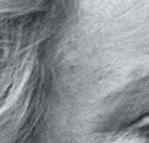




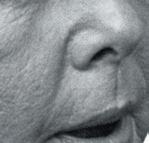








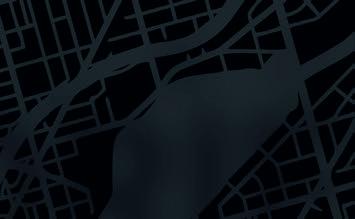







APRIL 14, 2022 - CHICAGO READER 27 #ChicagoStoriesWTTW wttw.com/chicagostories TUNE IN FRIDAYS 8 PM AND STREAM:
Chicago Mayor Jane Byrne, 1982.
Chicago History Museum, ICHi-037841; Richard T. Kaner, photographer. AN ORIGINAL DOCUMENTARY SERIES ABOUT PEOPLE AND EVENTS THAT SHAPED A GREAT AMERICAN CITY Food & Drink A weekly newsletter featuring exclusive new writing by our critic Mike Sula and the latest restaurant reviews, chef profiles, and more from our site. Hot off the grill every Friday. SANDY NOTO FOR CHICAGO READER chicagoreader.com/newsletters
Photo:
Photo:
ARTS & CULTURE
continued from 26
I did watch it. Apparently, a lot of people thought when Will Smith got up, that it was some sort of bit. But I knew instantly. I knew it because I could see the way he was walking.
Chris Rock is a friend of mine. I’m not up to speed on Jada Pinkett Smith’s health. I saw her in the audience. I saw she had very short hair. A lot of people have that haircut. It is totally possible Chris Rock did not know she had a medical condition. It wasn’t a funny joke, but the idea that you can hit someone because a joke’s not funny, this is incredibly dangerous. Imagine what a bad precedent this sets. When I was a child, there were rules about fighting: bigger boys don’t hit smaller boys. And he’s much bigger than Chris Rock.
The Academy Awards in general seems like something they should have stopped five years ago. It seems old-fashioned to me, and I am old. I also felt Will Smith’s speech was incredibly aggravating. The way these people talk about themselves, you would think they were actually countries, not just actors. Clearly whoever was running that thing had no idea what to do.
After Pretend It’s a City, you’ve been trending, as they say. What are your audiences like these days?

For some unknown reason, the audiences for my speaking dates are hugely young. No matter what I say, I get these blank looks. The other night, I said, ‘So the Civil War, you’ve heard of it, right?’ Because maybe they haven’t. I spoke to a literature class at the University of California, Davis, and I mentioned John Cheever. No one had heard of him. And they were very smart kids, very studious. But they were certainly ill-informed. And afterwards the teacher of that class said, ‘Thank you for telling my students about John Cheever,’ and I said ‘Wouldn’t that be your job?’ He’s an important American writer. This isn’t some peripheral weird figure.
Has social media devalued expertise? A tweet makes you a critic these days.
There is certainly the idea that there is no value in expertise. This is for almost everything, including medicine. Someone asked me my opinion on some medical thing. What would my medical opinions be based on? My medical opinion is I ask my doctor. That’s my medical opinion. His medical opinions are of interest to me because he’s a doctor. I’m not
interested in the opinions of other people that much as far as movies or books unless I know them. I also have actually complained to a certain magazine in New York that they don’t tell you who the writers are. They have the name, but they don’t give you any background. If I want to read an article in a magazine about Afghanistan, I want it to say underneath, ‘This writer spent two years in Afghanistan.’
If it says underneath, ‘This writer reviews desserts,’ I don’t care what they think about Afghanistan.









Your Janice Goldberg was my favorite judge on the original Law & Order . Has anyone contacted you about appearing on the new reboot?
They have not. I really enjoyed doing that because I loved wearing the judge’s robe. More than even wearing the robe, I loved banging the gavel. I got numerous letters from real judges saying that judges don’t gavel and explanations why I shouldn’t bang the gavel. Truthfully, if you ever have the opportunity to sit on a judicial bench, it is irresistible.
I loved Pretend It’s a City . I could have probably watched eight hours of you just walking around New York. But my wife noticed you don’t carry a purse. What’s in your pockets?
I never thought I would say this, but no one’s ever asked me that, but I will tell you: cash, my Metro card, my vaccination card; my keys I leave with the doorman. Cigarettes and a lighter.
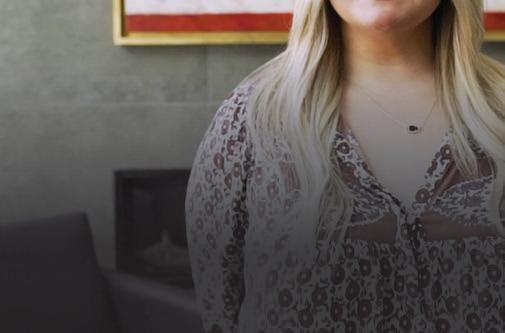
You’ve said that these stage appearances are where you are your most buoyant. You’ve talked about your writer’s block, but are you ever at a loss for words? I have to think there were nights at the Algonquin Round Table where George S. Kaufman couldn’t come up with a decent quip to save his life. Do you ever have an off-day?
No. Truthfully, I have no idea where it comes from. The secret to this is co ee. The world’s greatest drug. I just drink gallons of coffee. I have a rider in my contract and the rider is mostly about co ee: how much co ee has to be in the dressing room and my hotel room. There has to be co ee all around me. That coffee is my entire cognitive ability. v
28 CHICAGO READER - APRIL 14, 2022 ll
@Groupof60 Overcome Addiction in 2022 INPATIENT & OUTPATIENT TREATMENT INCLUDING TELETHERAPY, FAMILY SUPPORT & ALUMNI SERVICES Open & Admitting Patients 24/7/365 In-Network with Major Insurance Providers As your journey to recovery begins at our world-class facility, you will be treated with compassion and dignity by our expert team of addiction professionals. Our team is dedicated to treating addiction and healing families and will be by your side from the time you call us through a lifetime in recovery. AT ST . CHARLES Call Today: 331-422-4851 RecoveryCentersOfAmerica.com/stcharles “You deserve recovery.” KAT C. / RCA ALUMNI












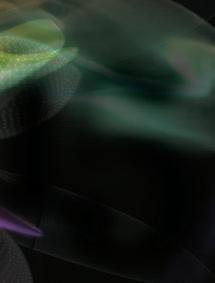
APRIL 14, 2022 - CHICAGO READER 29 Sweet 15 2007. 22 oh how ’ blossomed! CENTER ON HALSTED HUMAN F1RST GALA 2O22 FRIDAY, MAY 6 ~ THE OLD POST OFFICE : 433 WEST VAN BUREN STREET : CHICAGO ~ CO CHAIRS : SOL FLORES & JOE BETANCOURT ~ HUMAN F1RST AWARDEES : MARY MORTEN : JULIO RODRIGUEZ : ROBERT & SUSAN SULLIVANCOMMUNITY SPIRIT AWARD : WILLIAM BLAIR ~ 5:3OPM : COCKTAILS & RECEPTION 7:OOPM : AWARDS, DINNER & DANCING ~ CREATIVE BLACK TIE ~ LIVE PERFORMANCE : CRYSTAL WATERS FOR MORE INFO : VISIT CENTERONHALSTED.ORG/HF ~ FOR LIVE SUPPORT : 773.472.6469 GET TICKETS : CENTERONHALSTED.ORG/HF CREATIVE BY SPARCINC.COM
A Den of comedy
Bringing in stand-ups keeps the Wicker Park theaterplex on its feet.
By KERRY REID
also took away some venues that had provided rentals to the large and vital band of itinerant theater companies in Chicago.
The last few months have been busy ones with theaters announcing new venues: if all goes well, American Blues, Steep, Northlight, and TimeLine will all be producing in their new homes sometime in the next couple of years.
But the long COVID shutdown of 2020-21
Stage 773 (formerly the Theatre Building Chicago and one of the longest-running rental facilities in town, as well as the home for the Chicago Sketch Comedy Festival) announced a year ago that they were reimagining their Belmont Avenue digs as an immersive experiential space, described by executive director Jill Valentine to the Tribune’s Chris Jones as “Willy Wonka meets Burning Man meets the Museum of Modern Art.” Stage 773 promises that WHIM is coming. What is WHIM? According to their website, “It’s more than a destination, it’s an exploration of creativity and inspiration where the line between artist, performer, and audience is blurred. The inner workings of the creative brain are explored and translated into reality for your play and enjoyment.” All righty then! But in the meantime, the four stages that were available as rentals in the venue are gone.
So too is the Royal George on North Halsted,
right across from the ever-expanding Steppenwolfverse; they told their existing renters, including Vicki Quade of the popular Late Nite Catechism franchise, that they had to move out last spring. (Quade is now producing at the Greenhouse Theater Center, where longtime resident company MPAACT is opening their first live show since shutdown, Pulled Punches, this coming weekend.)
The Athenaeum, a longtime go-to for rentals in Lakeview next door to owner Saint Alphonsus Church, has been reimagined as well; it’s now The Athenaeum Center for Thought and Culture. According to a press release last October, “The mission of the Athenaeum Center for Thought and Culture is to invite people into encounters with beauty and to revitalize the great Catholic tradition of the arts from one of Chicago’s most unique, religious, artistic, and civic buildings.” They are still offering rentals, but their website notes that those will be “curated” by the theater. Though some dance companies have performed there, I haven’t seen any announcements of upcoming theater
productions.
Keeping commercial houses open during a time of no rental revenues is obviously an even more daunting task, since they’re not eligible for nonprofit grants. (Mercury Theater Chicago announced they were closing for good in 2020, but were mercifully able to reopen.) But in the case of Wicker Park’s the Den, they’ve found a savior in stand-up comedy.
Ryan Martin, once a member of the nowdefunct Sinnerman Ensemble, first rented out a second-floor space in what was formerly a department store on Milwaukee Avenue in 2010 to produce and codirect William Inge’s Bus Stop with longtime Chicago actor Lia Mortensen. Quickly, however, the Den turned from producing their own work to providing rental facilities for others.
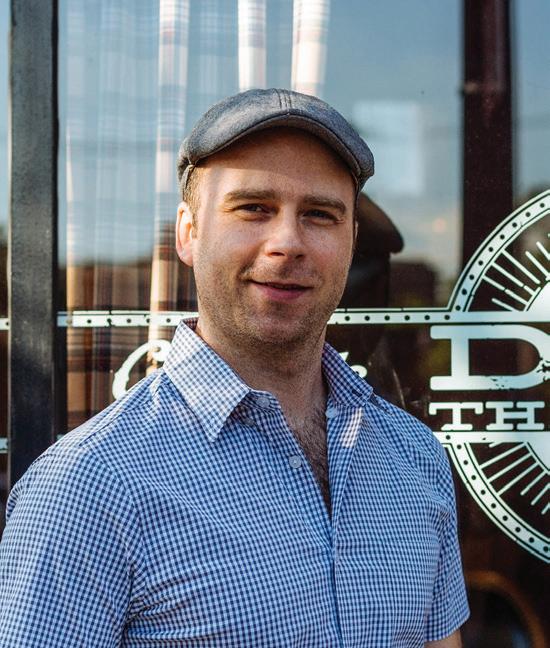
With generous investments from theater philanthropists Michael and Mona Heath, the Den has grown to currently encompass five theaters, a downstairs bar/cafe, and comfortable lobby and bar areas throughout with cozy leather couches that do indeed feel denlike. A

30 CHICAGO READER - APRIL 14, 2022 ll
THEATER
Ryan Martin, CEO and founder of the Den Theatre; interior of the Heath mainstage AUSTIN PETERS/ABIGAIL BRASHER COMIC INTERVENTION






























APRIL 14, 2022 - CHICAGO READER 31 CALL 1-855-927-2570 promo code N7017 * Prices are per person based on double occupancy plus up to $299 in taxes & fees. Single supplement and seasonal surcharges may apply. Add-on airfare available. Free date changes prior to final payment. Deposits and final payments are non-refundable. Onboard Credit requires purchase of Ocean View or Balcony Cabin. O ers apply to new bookings only, made by 6/30/22. Other terms & conditions may apply. Ask your Travel Consultant for details. BEST OF HAWAII FOUR-ISLAND TOUR GRAND ALASKAN CRUISE & TOUR Oahu • Hawaii Island • Kauai • Maui — Enjoy a fully guided 4-island Hawaiian vacation with centrally located lodging in Waikiki on Oahu, and beachfront lodging on the “Big Island” of Hawaii, Kauai, and Maui. Guided throughout by our friendly Tour Directors—your local experts. Includes 3 inter-island flights. Seattle • Vancouver • Ketchikan • Juneau • Skagway • Glacier Bay • Anchorage • Denali • and more Visit Denali and Glacier Bay on the same incredible trip! Cruise through the Gulf of Alaska and the Inside Passage as you discover the best of the Frontier State by land and by sea. 12 days, departs year-round 12 days, departs July - Sep 2022 FREE ONBOARD CREDIT FREE DATE CHANGES FROM $2,549 $2,299 * FROM $1,949 $1,699 * 600+ Tours starting from $1,200 pp Speak to an expert at: 866-502-2279 Hours: 9 am - 7 pm EST Monday - Friday
THEATER
continued from 30

wide range of Chicago companies have called the Den home, including First Floor Theater, Broken Nose Theatre, Haven Chicago, and the Hypocrites.





The latter were supposed to be in residence 36-44 weeks per year in the downstairs Heath mainstage space, a large flexible-use room built out in 2014 that can seat up to 300. But by the end of 2016, the company, led by founder Sean Graney, was effectively shut down, leaving a large hole in the center of the Den’s operations.
Martin, who owns the business entity that runs the Den (but not the building itself) along with Carol Cohen, founder of Haven Chicago, says the departure of the Hypocrites left them scrambling for a model to keep the theaters viable even before COVID-19. “The challenges that came were fast and hard financially, you know, and it was like, ‘How do we support all this square footage?’ So I’ve always been searching for ways.”
The downstairs bar/cafe space, the Haven Lounge, was open for a while during the day, but Martin found that it wasn’t generating enough revenue to cover costs. (Currently the lounge is open one to two hours before shows; the Den is also planning on unveiling renovations later this spring that will open up the street windows for better ventilation, and they will expand bar service into the downstairs main lobby.)
Enter the comedians.
The first high-profile comedian to rent at the Den was Cameron Esposito, who used one of the smaller studios for a two-week residency in 2017 to work out some new material. “I watched every single show sell out in two days,” says Martin. “And then I also watched my team, the Den sta , put together this show with such minimal cost.”
Now the downstairs mainstage is mostly dedicated to presenting comedians; last weekend, Michael Kosta of The Daily Show and River Butcher filled the room. Patton Oswalt and Maria Bamford have performed there in the past, and the Den is now also becoming a spot for comedians to film specials; Todd Barry will be taping there on April 24.
“We have a really cool green room for them, we take care of them. We built a team where our goal is to give great customer service to the comedian,” says Martin. “So they come here and they go, ‘Oh, the Den takes care of us.’ We have a stage manager specifically for them. We have security. We treat them like royalty, you know?” He adds, “I think that we try to
give the audience a really cool vibe.”













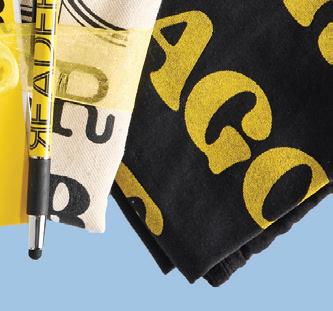

The layout of the Heath mainstage has cabaret-style VIP seating in the middle, with green and blue velvet padded seats around cocktail tables, and then regular seating around the perimeter on three sides, with enough space so cocktail service isn’t disruptive. The stage itself, designed by veteran theater designer Jeffrey D. Kmiec, is flanked by shelves with tchotchkes and books, giving it the feel of an intimate library room, as opposed to the stereotypical austere brick-wall backdrop of many comedy clubs.
I suggest to Martin that the Den is aiming for the sweet spot between clubs like Zanies and big headliner venues like the Chicago Theatre. “That’s a good way to put it. I love that,” he responds.








Martin notes that the Den offers what he categorizes as below-market rates (ranging from $275/nightly-$1,100 weekly for the smallest studio, which seats 45, to $1,200/ nightly-$4,500/weekly for the Heath mainstage, not including facilities and equipment fees), with a dedicated technical and frontof-house sta to help renting companies. But rentals have been slow to return, as storefront companies worry about canceling due to new waves of COVID-19. (Upcoming non-stand-upshows at the Den include the Chicago Circus and Performing Arts Festival April 21-24; First Floor Theater’s production of The Secretaries, by Chicago playwright Omer Abbas Salem, opening May 5; and Broken Nose’s Chicago premiere of Zoe Kazan’s off-Broadway hit, After the Blast, opening May 13.)
By building up the comedy headliners at the forefront of their business model, the Den in essence is letting the comedy help bankroll the drama. But Martin has other ideas, too. Upcoming plans include turning the spacious downstairs lobby into a vendors’ market with a DJ on the weekends; Martin hopes to kick that o this summer. “If it all works, we could have 50 to 70 vendors on any Saturday that are all paying us a small amount of money, but where, when you add it all together, it’s significant. And it doesn’t interfere with our theater or our comedy.”
He adds, “I think it is picking up among the comedian community that in Chicago, if you want a place where you can really connect with the audience and it’s a good neighborhood, good vibe, come to the Den. I think that that’s growing and it’s so important for us as a theater because our first love is theater.” v
32 APRIL 14, 2022 ll
@kerryreid SOMETHING READER FOR EVERYONE! store.chicagoreader.com Choreography Young Dancers Beginners Pointe Pre-Professional Little Dancers Mini Camp Teen/Adult Ballet Creative Movement Pre-Ballet Ballet Floor Barre Modern Hip Hop Tap DISCOVER THE JOY OF MOVEMENT THIS SUMMER AT HPSD! We offer dance classes for all levels from beginner to preprofessional and for all ages from toddlers to adults. Regular Classes Regular Classes Workshops | Camps Intensives Workshops | Camps Intensives Summer 2022 June 4-July 1 | July 9-August 5 Training | Performance | Community www.hydeparkdance.org To learn more, visit www.hydeparkdance.org
APRIL 14, 2022 - CHICAGO READER 33 CANNABIS CONVERSATIONS An exploration of cannabis and hemp topics from multiple perspectives: medical, historical, social equity, ecological and more. Cannabis Beverages Interview with a Canna-Mom Community Education, Expungement & Reentry Resources, and more! Featuring: Brought to you by: Green Thumb | Curaleaf | Nature’s Grace and Wellness pts | Dispensary 33 | NECANN
GROWING FOR GOOD with Green Thumb


Cannabis Equity Illinois Coalition: fighting to end the war on drugs, and for justice and equity in legalized cannabis.


Who is the Coalition:
The Cannabis Equity Illinois Coalition is a grassroots nonprofit formed in Chicago in 2019, dedicated to ensuring that the legalization of cannabis in Illinois repairs and reinvests in the communities most impacted by the war on drugs, and that the cannabis industry prioritizes people over profits! You can learn more about our work at CannabisEquityIL.org and @CannaEquityIL on all social media.
Community Programs:
Expungement:
•The Coalition hosts RAP Sheet Assistance Days every other month in Chicago, supporting community members start the record-clearing process for free.

•Email ceicexpungement@gmail.com for support with record clearing!
•We’re also a partner with New Leaf Illinois, where anyone with a cannabis record in Illinois can receive free record-clearing support by visiting: newleafillinois.org/s/
Resource fairs:
•We host quarterly resource fairs with di erent community partners, where we provide access to wraparound resources to ensure community members have everything they need, including housing resources, employment opportunities, food assistance, IDs, and much more! These resource events are in both English and Spanish.
Calls to Action:
4/22 fundraiser:
•We’re hosting a three-year anniversary celebration with our partners at Hush Chicago!
•This event will celebrate the Coalition members who’ve worked so hard over the last three years to make this organization a reality.
•We hope you can join us to celebrate three years of organizing!
•Check out hushchicago.com/420 for details and tickets.
Join a meeting or invite us to speak:
•We host weekly Coalition meetings, where you can learn more about the work and plug in with our programs!
•We welcome you to invite our members to speak to your organization. Reach out to CannabisEquityIL@gmail.com for meeting links and to invite us to speak.
Donate:
•The Coalition is a grassroots nonprofit that exists because of community fundraising. To support our work, please visit: cannabisequityil.org/donate/
Community Programs:
Community education:
•The Coalition hosts community programs to educate the public about their legal rights and how cannabis a ects them, the benefits of medical cannabis, how to advocate for change through community organizing, and much more.
•These programs are in both English and Spanish, and are hosted both in person and online, so we reach as many people as possible.
Youth education:
•We are hiring young people to develop and host bilingual educational programs for their peers on topics important to them. Topics include learning their legal rights and how to protect them, and how they can create change through community organizing!
•By developing a youth leadership committee, we will create the next generation of leaders to bring change to Illinois.
Policy advocacy:
•We lead a community-driven policy advocacy program, where community members identify issues important to them, research them, and learn how to advocate for their passage.
This is a paid sponsored content article from Green Thumb Industries.
To find out more about the Cannabis Equity Illinois Coalition, visit cannabisequityil.org or @CannaEquityIL on all social media.
34 CHICAGO READER - APRIL 14, 2022 ll
PAID SPONSORED CONTENT


APRIL 14, 2022 - CHICAGO READER 35 AVAILABLEAT


































































































































































































































































































































































































































































































































































































































































































ll





APRIL 14, 2022 - CHICAGO READER 37 The Reader 420 Companion is filled with great recipes, activities and coloring pages. Details may be found at chicagoreader.com/420book 21+
How and why
and
health
important to talk about mental health
It’s undeniable, mental health is a key part of our overall health and wellness. According to mental
How has becoming the owner of one of Illinois’s first cannabis cultivations contributed to your family’s agricultural legacy?
My husband’s family has farmed in Fulton and McDonough County for six generations. This in itself is the legacy and something to be proud of. It has been generations of hard work and family e ort that made it happen. When our family applied for a cannabis cultivation center, it seemed like it could be a natural fit to where our family could grow, and an extension of our farm and community footprint. Our hopes were that Nature’s Grace and O’Hern Stock Farms could work together to help continue our agricultural legacy. We as a family are good stewards of the land and NGW is an extension of this sentiment.
This is a family affair! Please tell us a little about your family.
So what can we do today to help improve our mental health wellness? Well, one sustainable and accessible treatment starts by simply talking about it! According to Banyan Mental Health, talking about feelings and emotions can make us feel less alone and can help relieve stress just by speaking it out loud. Although many of us are not used to talking about these things, learning to have proactive conversations about mental health could make a huge impact in someone’s life. And according to The National Alliance on Mental Illness, seeking help through support systems for our physical and mental well-being helps us address and prevent crisis situations.
So how do we Spark the Conversation about mental health? Let’s check in with Alia Reichert from the Spark initiative who guides us through some common ways to talk to others about mental health.

Q: How can we start this complicated and personal conversation for ourselves?
This is indeed a family a air, with myself, my husband Larry Joe, and our four sons all playing a part in the cannabis company. Our oldest son, Patrick, does the market branding and outreach for NGW. Our second son, Tim, is head of operations and legal matters for NGW. Our younger sons Dan and Matt are not involved in the day-to-day operations at the cannabis farm, although their experience and leadership is utilized. With myself as CEO and my husband as CFO, we co-lead Nature’s Grace. I especially appreciate Larry Joe for his knowledge and experience in farming. It is what has driven our family and helped our brand’s success.

As one of the only family-owned-and-operated cultivation



t’s health our our one sustainable by about feelings less help speaking many not talking things, learning National systems well-being helps prevent crisis Alia initiative compliwriting down a to
Alia Reichert: Talking about feelings and thoughts can be scary. Start by writing them down in a journal, record what you want to say on your
phone, or even talk in front of a mirror for practice.
even
Q: How should we have this con-





The Budrista platform is a cannabis industry and lifestyle project. Its purpose is to support the healthy and balanced lifestyle of cannabis industry workers. Budrista functions through various outlets such as educational programming and recreational events. By signing up, you’ll have first access to our events and programming!

AR: No, according to the National Institute of Mental Health, asking someone directly if they are planning on harming themselves can help to identify if they are at risk for a serious mental health crisis such as suicide.
centers in Illinois, do you feel added pressure to perform well in the Illinois marketplace?



Q: What is the most important thing to remember when talking to others about their mental health?
AR: The most important things are the ability to listen, to not interrupt, to not diagnose (unless you are a medical professional), and to not judge the person or the feelings being shared.
The short answer is yes. When we started this, we felt we had to prove to ourselves and especially to our local area that this was a real business, not a fly-by-night that was going to hurt the community. We like to operate traditionally as we have in the many years within the agricultural world of operations. As such, it is important that we do healthily engage in the pressures we face in this new market and create a positive impact through our company’s practices and values.
Q: What if I’ve talked and still feel like harming myself, or my loved ones are threatening self-harm after talking?
Is having a cannabis cultivation center more stressful than running a typical farm? What are the stressors?

AR: If you feel friends, family members, or yourself are a risk, immediate action should be taken by dialing 911 and requesting a crisis intervention o cer or mobile crisis team. In nonimmediate situations, you can text, call, or chat the National Suicide Hotline at their updated three-digit dialing code 988.
We always feel pressure to perform well. With hard work and determination, we strive to be the best we can be at whatever we are growing. Farming in general has a lot of regulations that must be followed, and running a cannabis cultivation is no di erent. We prioritize our business’s organizational structure and for it to be in line with the standards we are supposed to abide by. The cannabis industry is still very new, and so this entire process has been a learning experience that we’re grateful to endeavor.
Institute help they a serious most important to talking AR: most important not not (unless medical What if I’ve talked and loved AR: memor a immediate dialing crisis mobile can or code our or labeled is real. our It imperative that emotions but more with we alone.


A big thank you to Kelley for taking the time to talk cannabis with us and explore Nature’s Grace’s growing legacy in the Illinois market.
The rest of Kelley’s interview may be found online at chicagoreader.com/ ngwspark
Talking about our personal thoughts and feelings is hard. The fear of being judged or labeled is real. These stigmas prevent us from speaking our truths and keep us silent. It is imperative that we rewrite the narrative and allow ourselves the ability to discuss our feelings and emotions without fear. We all have thoughts that can get us down, but the more we share with others, the more we realize we are not alone. Be well, be open to listen, be supportive, and Spark the Conversation.
This sponsored content is paid for by Nature’s Grace and Wellness.
sponsored
This sponsored content is paid for by Nature’s Grace and Wellness.

CHICAGOREADER.COM/NGWSPARK
CHICAGOREADER.COM/NGWSPARK


38 CHICAGO READER - APRIL 14, 2022 ll
Kelley O’Hern: An Interview with Nature’s Grace’s Canna-Mom
PAID SPONSORED CONTENT
it’s
AR:
CONTENT
it’s
le
cannabis platform a Reader resource for the canna curious www.neuromedici.com 312-772-2313 Findouttoday ifmedical cannabisorinfusiontherapyis rightforyou.Telemedavailable! Yourpartnersinhealthandwellness. Serving medical cannabis patients since 2015. To advertise, email ads@chicagoreader.com CBD / cannabis recipes, psychedelic drawings to color, word puzzles to stimulate your brain, growing tips, and more! chicagoreader.com/420book
Kelley O’Hern (third from
) with her family.
the





































































































































































































































































































































































































APRIL 14, 2022 - CHICAGO READER 39 Selec t E ssentia Introducing Your favorite strains. Our quality oil. Available at your local dispensary: ials




40 CHICAGO READER - APRIL 14, 2022 ll rmi a e a e i e enter 01 S. a e S re ri e Exhibit Hall Hours 150+ VENDORS 100+ SPEAKERS 100+ SPEAKERS THE LARGEST CANNABIS INDUSTRY EVENT FOCUSED ON ILLINOIS! I C C LLINOIS ANNABIS ONVENTION THE necann.com/illinois Fri., June 10: 10 am-5 pm / Sat., June 11: 10 am-4 pm BOOTH SPACE AVAILABLE!
The big meal
In Every Generation examines inherited trauma across four Passovers.
 By KERRY REID
By KERRY REID
In a recent New Yorker profile of Natasha Lyonne, star and creator of the trippy Netflix series Russian Doll, Lyonne reflects on her heritage as the granddaughter of Holocaust survivors, and how that trauma creates ripple effects through the generations. “I joke that there’s a straight line from Hitler to heroin,” she says.
The Levi-Katz family we meet in Ali Viterbi’s In Every Generation , now in its world premiere at Victory Gardens under Devon de Mayo’s direction, isn’t shooting up, but they’re primed for generational pain. Only perhaps, as Grandmother Paola (Carmen Roman) warns, maybe they’re still a little too comfortable sitting around the seder table in 2019, in southern California. What makes them think it can’t happen again, in the United States?
There are more than four questions facing the family, and the answer goes beyond the cheeky response we hear: “They tried to kill us. They didn’t. Let’s eat.”
Grandpa Davide (Paul Dillon) is an Auschwitz survivor in the late stages of ALS, while Paola rode out the war in the relative safety of a convent in Zagreb after fleeing Italy as an orphan. Their daughter, Valeria (Eli Katz), an art history professor still reeling from her rabbi husband abandoning her for another woman in the congregation, is hosting the seder under protest. Paola and Davide’s granddaughters have their own issues. Yael (Esther Fishbein) is back from Yale, filled with the fiery righteousness of a newborn campus activist, while Devorah, or Dev (Sarah Lo), the homebody, is delving deeper into Judaism.
A lot comes flooding out at that dinner, including the fear of growing anti-Semitism in the U.S. in the wake of the Tree of Life massacre in Pittsburgh only months earlier. The conflict between Dev (adopted from China as a baby) and Yael takes root in the familiar soil of who bears the greater responsibility for taking care of elders, as well as Dev’s own insecurity as to how much she really is tied to the family’s history. Yael is collecting her grandparents’ stories, while Dev is tending to their physical needs. Yael is also fascinated by epigenetics—essentially, the study of how trauma imprints on DNA, which makes Dev feel even less connected.
It would all be meaty enough for one meal. But Viterbi spreads it out over four di erent seders, spanning centuries. In the second act,
we meet the family again in various configurations. First, Roman and Dillon reappear as younger versions of Paola and Davide, enjoying their first seder in the United States in 1954, where Davide tells a different story about an incident in Auschwitz than the one we heard in the first act. The two are terrific at pulling at the tightly entwined threads of fear and survivor’s guilt, alongside love and lust (their decision to go for a “sexy seder” is simply delightful) and unraveling all that it takes to survive the worst thing imaginable.
In 2050, middle-aged Yael and Dev have reunited after a period of estrangement. Paola and Davide are long dead, of course, and now Valeria is in a wheelchair, unable to speak (but communicating through some unexplained tech device that apparently reads her thoughts). It’s the first seder the family has had after another period of anti-Semitic repression—one that cost Valeria her university job, and one that is all too imaginable in the current climate. So much so that we, along with the sisters, jump when there’s a knock at the door—especially since we know Dev, who is now a rabbi, has put a mezuzah back up as a marker of her faith.
Finally, Viterbi goes full Russian Doll time-travel with us, sending us all the way back to the first seder in 1416 BCE. But narrative echoes from the previous dinners recur in the dialogue, and anachronistic artifacts (Valeria’s beloved Diet Coke) pop up out of the sand surrounding the set. (For this production, de Mayo and set designers Andrew Boyce and Lauren Nichols have cunningly reconfigured the downstairs space at Victory Gardens from its usual proscenium to allow audience seating on two sides, as if we’re silent participants in the dinner. It’s a terrific choice.)
The last scene feels oddly superfluous and anticlimactic, undercutting the tensions that de Mayo and Viterbi build so carefully in the near-dystopian future of 2050. We’ve grown to understand these characters over the first three scenes so well that this coda feels unnecessary and self-conscious, reducing them at times almost to caricatures. Still, Viterbi’s dialogue, de Mayo’s staging, and the rich performances offer us plenty to consider about survival, fear, and love. Even if the narrative line gets a little crooked by the end. v
@kerryreid
APRIL 14, 2022 - CHICAGO READER 41
SEDER STORIES
THEATER R IN EVERY GENERATION Through 5/1: Tue-Sat 7: 30 PM, Sun 3 PM; also Wed
2 PM (open
Sat 4/ 16 and Tue
open
Fri
In Every Generation at Victory Gardens Theater LIZ LAUREN
4/20,
captioned performance); no performances
4/ 19;
captioning also Fri-Sat 4/22-4/23 ; ASL interpretation, audio description, and touch tour
4/22 ; audio description/touch tour also Sun 5/1, 3 PM (touch tour begins 90 minutes before showtime); Victory Gardens Theater, 2433 N. Lincoln, 773 -871-3000, victorygardens.org, $29-$ 62
THEATER


R THE KING AND I Through 5/22 : Wed 1: 30 PM, Thu 1: 30 and 8 PM, Fri 8 PM, Sat 3 and 8 PM, Sun 2 and 6 PM, Drury Lane Theatre, 100 Drury Lane, Oakbrook Terrace, 630 530 0111, drurylanetheatre.com, $ 64 -$79

MUSICAL REVIVAL

A warhorse, reconsidered


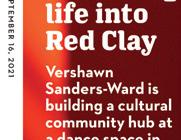
Drury Lane’s The King and I strips away Orientalism.
By JACK HELBIG
ichard Rodgers and Oscar Hammerstein II’s 1951 musical The King and I , based on Margaret Landon’s novel, Anna and the King of Siam , is one of the warhorses of musical theater. The original run was three years (1,246 performances), and it has been revived with a mind-numbing regularity since, produced seemingly by every professional and amateur theater at one time or another. And why wouldn’t it? It contains almost nothing a middlebrow, middle-class, white, heterosexual audience could object to—no sex, no overt political messages, and it features a squirming gaggle of kids running around the stage.
On the surface, the story concerns a British governess who comes to the court of the king of Siam and teaches him, his children, and the court to do things the correct way, which is to say the late Victorian British way. (To tilt things further in the direction of European superiority, the Siamese court was often portrayed, like Gilbert and Sullivan’s The Mikado or Puccini’s Madama Butterfly, by white actors in yellowface.) At least that’s how I read the show growing up in the mid-60s, in my middlebrow, middle-class, white, heterosexual, small-town, southern Illinois bubble.
I should have known R & H were after something deeper than this.
One of the beauties of Drury Lane’s current revival (and there are many) is that it strips away much if not all of the quaint G&S-style Orientalism that has marred earlier productions and muddied the message of a show that, though told from the point of view of the governess, works hard to provide as clear-eyed a view of the historic court of King Mongkut of Siam as you can provide in a three-hour Broadway musical.
Hammerstein’s book and lyrics undercut any smug notions that the European way of doing things is best. The show climaxes in a scene where we are invited to laugh at the preposterous native costumes of the Victorians—hoop skirts, gloves, and insanely painful shoes—that the Siamese court must wear to









“prove” they are not barbarians. The show even contains a devastating song, “Western People Funny,” that is quite the subversive dig at 19th-century-style imperialism.

They think they civilize us
Whenever they advise us
To learn to make the same mistake
That they are making too!


Director Alan Paul wisely avoids yellowface. Most of the major characters in the court are played by Asian actors. The actor who plays the king himself, Adam Jacobs, is of Filipino heritage on his mother’s side; his portrayal of King Mongkut is powerful and dignified. He avoids any of the thundering cartoonish bu oonery that Yul Brynner (and others) indulged in.
Together, Jacobs and Betsy Morgan (as the governess, Anna) have a palpable chemistry. Even though there is no romance in the relations between the King and Anna, the spark between them adds drama to even the most routine interactions (such as a negotiation for a raise in Anna’s monthly salary).
The result is a production that does not take sides in the clash of East and West. Or rather it errs on the side of self-rule and adaptation. (One of the hallmarks of King Mongkut’s reign is that he avoided being “protected” by French and English colonial powers the way countries around him—Burma, Cambodia, Vietnam—were.)
More importantly, all that is great about the original show (and it is a remarkable show, still powerful 70-plus years later) is visible in this production, packed with strong singers, able actors, and dancers who, led by choreographer Darren Lee, e ortlessly bring Jerome Robbins’s original dances to life. But for all the tinsel and glitter on stage, all the dazzling costumes and soaring tunes, the simple story—about two stubborn people who butt heads and then learn from each other—still moves us. v
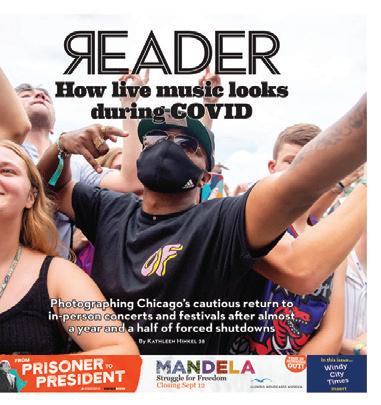
42 CHICAGO READER - APRIL 14, 2022 ll
@JackHelbig
Providing arts coverage in Chicago since 1971. chicagoreader.com








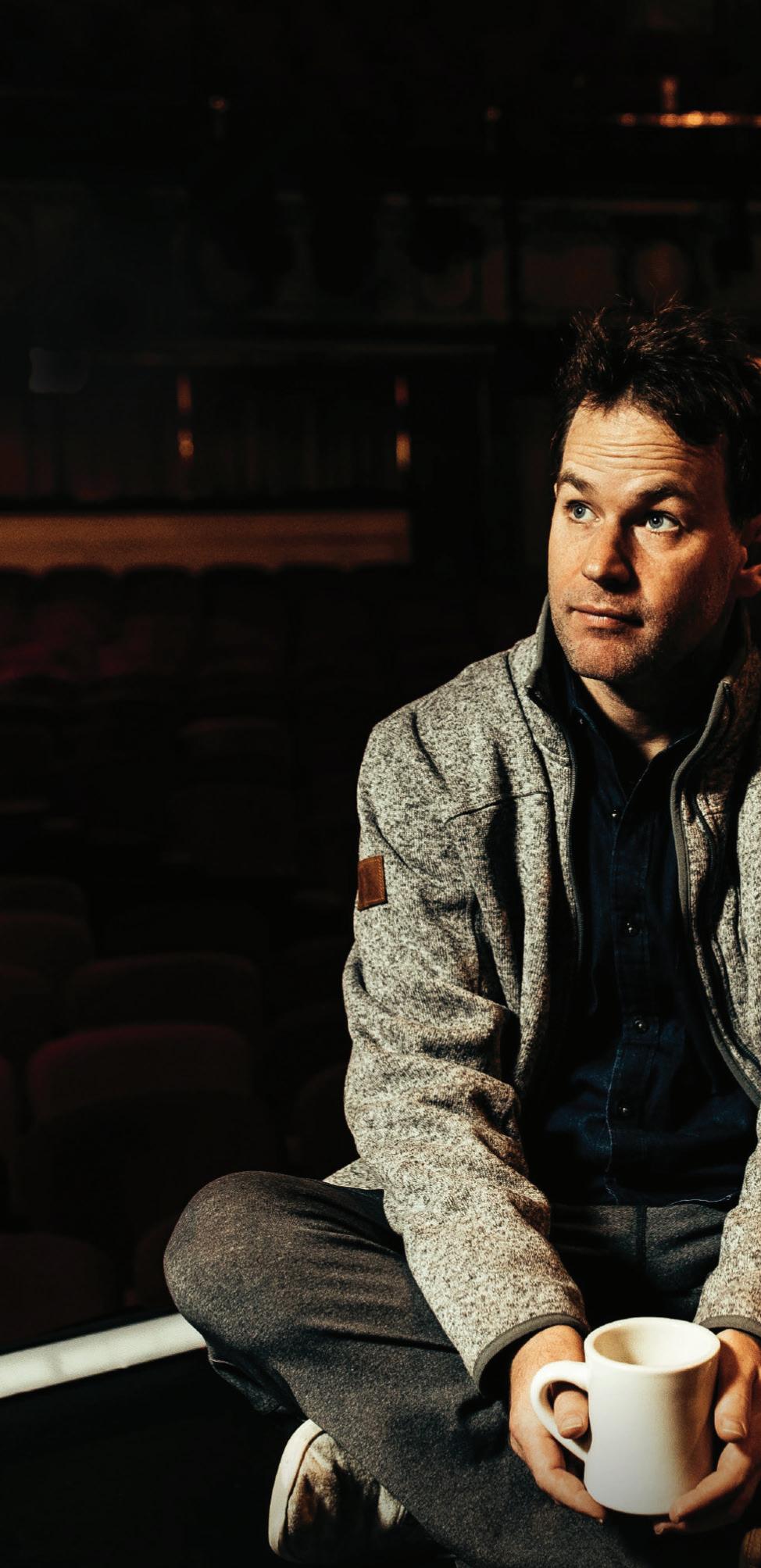














APRIL 14, 2022 - CHICAGO READER 43 Relentless is supported by SPONSORS OF THE ORIGINAL PRODUCTION SPONSOR OF THE GOODMAN PRESENTATION Additional support provided by Corporate Sponsor Partner DOUGLAS BRADBURY THE ELIZABETH F. CHENEY FOUNDATION GoodmanTheatre.org 312.443.3800 Groups 10+: Groups@GoodmanTheatre.org RELENTLESS BY TYLA ABERCRUMBIE DIRECTED BY RON OJ PARSON After a sold out run this winter, Tyla Abercrumbie’s world premiere play comes to the Goodman, weaving a mother’s past with her daughters’ present in a centuries-spanning tale of family, legacy and progress. TIMELINE THEATRE COMPANY’S PRODUCTION OF “THE BEST NEW WORK IN YEARS” –Chicago Tribune EXTENDED BY POPULAR DEMAND THROUGH MAY 8! THE OLD MAN AND THE POOL MIKE BIRBIGLIA APRIL 28 - MAY 22
By JANAYA GREENE
When Coquie Hughes started working on her first film, Sunday After Church, in 1997, platforms like YouTube and Vimeo that allow filmmakers direct access to their audiences didn’t exist.
She had tried making her first film years prior, in the early 90s, but it didn’t quite work out. Hughes had just relinquished her scholarship to Xavier University in New Orleans, realizing that she wanted to pursue filmmak-
ing. Stipulations of her scholarship wouldn’t allow her to change her major, so at 18 years old she returned to her home state to pursue her dream career at Northern Illinois University and learned very quickly that as fulfilling as it is, being a filmmaker would have major hurdles.
“I went to Northern [Illinois University] and didn’t like it. I was like, ‘OK if these people aren’t going to pay for me to go to film school, I’ll pay for it myself,’” she recounts. “I left Northern and went to Columbia College. It was so financially hard being a 19-year-old trying to pay for college, so I ended up dropping out of Columbia.”
Still, the challenges of gaining an institutional filmmaking education didn’t stop the west-side Chicago native. While riding the CTA bus, she saw a production set shooting a commercial. In excitement she hopped o of the bus and asked the person in charge if she could help; right there she was onboarded as a production assistant. This is where she began to learn the ropes of film production.
As she continued to learn, Hughes connected with other locals who were still enrolled in universities, like the School of the Art Institute of Chicago, and was able to begin filming projects with equipment her peers had access to. This resourcefulness not only helped her gain needed supplies—it expanded her network of filmmakers in the city.
“I was just always asking people to help,” she says, laughing. “People were always willing to help because, back then, making a movie was exciting. For screenings, I’d just ask people, ‘Hey, can I show my trailer?’”
One of her more steady roles was teaching theater performance through the Chicago Park District. She got the job due to her success teaching performance to kids in underresourced communities.
“I took advantage of those opportunities to work with the park district teaching theater to also showcase my films. I was also able to attract a potential investor who came to see a play I wrote called Gotta Get My Hair Did,” she says. “I was able to raise money from people coming in to see the play to actually make my first o cial film, which was [of the same name as the play]. I distributed that film by buying
a whole bunch of VCRs and I’d make tapes. I would go to Kinko’s to make the covers for the tapes.”
Since then, Hughes has made an array of films about the range of experiences of Black queer women. A pioneer of creating these independent films in her earlier days of filmmaking, Hughes is still focusing on writing and directing these stories, the most recent one being a pilot called Black and Merry , an anthology series centering Black queer women in relationships facing di erent challenges.

Since her times of manually creating VHS tapes, Hughes progressed to DVDs and now digital distribution, as most films today are streaming. But as an indie creator whose films have reached people all over the world, pre-digitally, finding an ongoing, long-term distributor for her archives has posed its challenges.
“I was approached by a distributor who wanted to distribute my films, but the terms that they wanted distribution under were not fair to me. Their exclusive contract wasn’t o ering me anything up front, yet they wanted all these rights,” Hughes says. “A lot of my counterparts were doing this: signing over their IP (intellectual property), but I had sense enough to not do that because you’re not getting anything for it. It was very predatory.”
Even the digital ways she could distribute her films aren’t as financially conducive for her, so she just asks folks to reach out to her directly for digital access, and to kindly send a donation.
As Hughes continues to create, she dreams of having a deal with a television company or streaming network that “fucks with me. They’ll say, ‘We’re going to give you the budget, and you just do your thing,’” she says. “I also want to have opportunities for young people, particularly young Black women from marginalized backgrounds, to gain the educational components and have resources.”
When Coquie Hughes saw The Wiz as a kid, she had no idea what it’d take to be the person on the other side of the screen who created it all. Now, her movies serve as a similar inspiration to a new generation of indie creators. v
@janayagr
44 CHICAGO READER - APRIL 14, 2022 ll FILM
COQUIE
Coquie Hughes hasn’t let the hurdles of the industry stop her from creating.
COURTESY
HUGHES PROFILE The business of indie filmmaking



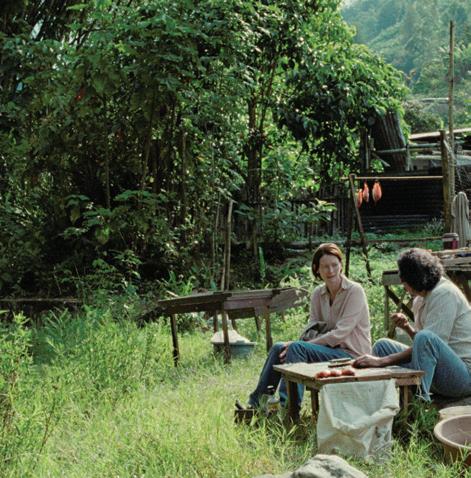



APRIL 14, 2022 - CHICAGO READER 45 ON35MM SISKELFILMCENTER.ORG /MEMORIA MEMORIA opens exclusively at the Film Center AfilmbyApichatpongWeerasethakul StarringTildaSwinton April 15 Never miss a show again. EARLY WARNINGS chicagoreader.com/early
REVIEW
Sound is the star
By KATHLEEN SACHS
Recently something happened to me that I hadn’t experienced in a while—I heard the sound of a telephone ringing outside my window. It sounded just as it did when I’d experienced this before, when I was younger and landlines were more common. It’s always a telephone ringing but muffled, like it’s coming from inside a home or car. A perfectly normal sound, yet trying to describe it, the uncanniness of only occasionally hearing it and in places where it seems unlikely one would be able to hear another person’s phone ringing, is surprisingly difficult, no less because I’m never sure whether what I’m hearing can be done so by others as well.
Something similar happens to Jessica (Tilda Swinton) in writer-director (and School of the Art Institute of Chicago alum) Apichatpong Weerasethakul’s latest masterpiece Memoria, screening at the Gene Siskel Film Center on 35-millimeter through Thursday, April 21. The film opens with her being woken up by a loud, dull bang, which she initially supposes to be
from construction happening by where she’s staying in Bogotá. Jessica is a Scottish expat and an orchidologist, living in Colombia near her sister and brother-in-law. (This marks a departure for Weerasethakul, as it’s the first feature he’s made outside his native Thailand.)
Jessica continues to hear this noise intermittently—for example, while out to dinner with her sister and her family, celebrating the former’s recovery from a cryptic illness that they’re discussing as possibly being due to her work researching a reclusive civilization; mysterious ailments are a commonplace phenomena in Weerasethakul’s films—and soon attempts to realize the sound with the help of an audio engineer, Hernán (Juan Pablo Urrego). Using a library of sound e ects with humorously vague titles, Hernán is able to recreate Jessica’s sound, though he warns it won’t resonate (pun intended) as it does in actuality.
As usual, Swinton gives an astonishing performance, lending nuance to Weerasethakul’s
exquisitely subtle story; here especially she gives herself over to the director’s caprices. She’s less Tilda Swinton the art-house icon and more waking phantasm, a figure from Weerasethakul’s dreams, a vessel for his inviolable prophecies to take shape. Surmising Swinton to be the film’s star, however, would be to overlook its most important element: sound.
Neon, the film’s distributor, is employing a unique exhibition model for Memoria: it will screen in one-week increments at one location at a time, moving on to the next and then the next. Likewise, the film will never be released on home video or via any streaming platforms. Part of the reasoning behind this is to preserve the sanctity of the exhibition experience, which includes professional sound systems that allow for the film’s meticulous sound design to resonate—quite literally.
“If you watch the film on TV or your laptop, you won’t hear most of the details,” a rmed Akritchalerm Kalayanamitr, the film’s sound designer, in a recent interview with MUBI’s Notebook. “You can achieve that only in the theater; that’s a controlled environment.” Just as one goes to a show or a concert with the intention of seeing the performers live, one, too, must venture out to the theater to experience the film’s topliner in action. No one else in it can hear Jessica’s sound—only her and us, the audience, for whom the opening bang is as much a shock. Thus viewers are along for the ride, the only witnesses privy to Jessica’s delusion. “I think I’m going crazy,” she tells a new friend, an archaeologist (Jeanne Balibar) whom she meets at the hospital where her sister had been staying. “You are,” the friend replies. “And me, too. It’s not the worst thing to be.”
The recurring motif of the inexplicable bang, which sounds like it’s wrapped in a sweater, per Jessica’s description of it, is based on Weerasethakul’s real-life experience with exploding head syndrome. It’s exactly what Jessica is experiencing, random bursts of
sound inaudible to anyone else. In interviews he sounds markedly distressed that he’s unable to explain the sound in question, a dilemma that permeates Memoria . Interestingly, this causes what should be his most accessible film to date, his first in English (and also in Spanish) with a recognizable star, to feel even more impenetrable than his previous, similarly opaque tone poems ( Tropical Malady , Syndromes and a Century , Uncle Boonmee Who Can Recall His Past Lives, and Cemetery of Splendor).
If the first two-thirds of the film convey Jessica’s, and by extension Weerasethakul’s, frustration with the phenomenon, the last section embraces the uncanniness, both inherent to it and wholly outside of it, expanding the film’s purview to embrace the haunting reverberations of memories singular and collective. Jessica travels further into Colombia’s mountainous region—a persistent theme throughout Weerasethakul’s films being the delineation between urban and rural spaces— where she again meets Hernán ( Elkin Díaz), this time as an older man who lives a modest life in the country.
Just as Jessica begins to embrace the unknowingness of what she’s experiencing, so, too, might viewers relinquish the incessant need to understand what’s happening. This is par for the course with Weerasethakul’s films, which utilize an inscrutable logic to beguiling e ect. But Memoria somehow feels di erent: More elusive, yet even more enveloping, typified by a scene toward the end where Hernán and Jessica’s memories meld in a sublimely intimate moment. It’s revealed around that point what the mysterious bang may be, a truly audacious deviation from the narrative up to then.
There’s a certain cause and e ect to these final revelations, which impacts the archaeologist friend’s nearby excavation. This idea of connection between seemingly (and maybe even actually) disparate occurrences is at the heart of the film and Weerasethakul’s entire oeuvre. It may take months, years, perhaps a lifetime to fully understand the impact of this singular work—or, more provocatively, it might not be something we ever fully grasp, yet another thing about this mysterious world that so maintains its deeply held secrets but bears so freely the scars of its collective memories. Maybe we all hear the telephone ringing sometimes. v MEMORIA ssss PG, 136 min.
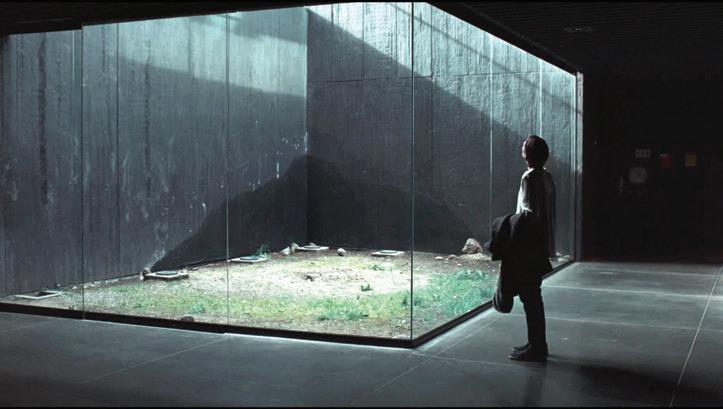 Gene Siskel Film Center
Gene Siskel Film Center
46 CHICAGO READER - APRIL 14, 2022 ll FILM
COURTESY NEON
Apichatpong Weerasethakul’s Memoria is more elusive and even more enveloping than his other beguiling films.
ssss EXCELLENT sss GOOD ss AVERAGE s POOR • WORTHLESS
NOW PLAYING
R Ambulance
Ambulance is a Michael Bay film to its core, an engine revved nearly beyond its limits, that somehow manages to stay together and crash stunningly into its destination.
Former marine Will Sharp (Yahya Abdul-Mateen II) is in desperate need of money to cover experimental surgery for his wife. Lured by the prospect of a big payday, he teams up with his adopted brother Danny (Jake Gyllenhaal) to knock off $32 million from a Los Angeles bank. When the heist goes wrong, Will and Danny hijack an ambulance carrying EMT Cam Thompson (Eiza González) and a wounded cop. Attempting to keep everyone alive and escape the law that’s hot on their tails, our trio takes an unyieldingly unmoored ride across the city of Los Angeles.

The film is a tribute to the heroism of EMTs done Bay style, with an extra dash of explosions on the side. It’s easily Bay’s best work in several years, refusing to slow down its frenetic pace for even a moment. A proponent of action maximalism, more is more for Bay, who not only goes over the top with chaotic cinematography, explosive set pieces, and the cranked-up-to-11 Gyllenhaal performance, but also throws in enough side-plot details and self-referential moments to fill an entirely separate film. There’s even amateur trauma surgery, directed via FaceTime, by surgeons on a golf course while in the back of a speeding ambulance.
Does everything in the film make sense? Absolutely not. Do most of the plot elements even stand up to scrutiny? Not really. But, when you’re hurtling towards the future with bags full of cash and sirens at your
R Cow
The first documentary from British writer-director Andrea Arnold following a string of acclaimed narrative features (Fish Tank, American Honey) isn’t silent, per se—its bovine subjects make quite a bit of noise, plus there are the ambient sounds respective to life on the farm—but it nevertheless conveys something similar to the splendor that radiates from the best of silent cinema. Depicting the life of dairy cow Luma, starting with her birth and initial separation from her mother, Arnold creates a testimony to the intricacies of being à la F. W. Murnau’s Sunrise and King Vidor’s The Crowd; the film covers Luma’s years as a calf to those she spends breeding to, finally, the twilight of her short life. This is the natural cycle for most living creatures, yet Arnold all but humanizes the cow with her benevolent lens. Scenes of Luma as a calf are shot like she’s a human child, confused by the separation from her mother but ultimately resilient and playful; a sequence of her mating with a bull is accompanied by fireworks and what could be termed foreplay, like a scene depicting the consummation of a couple in a romantic drama; and her years as an older cow find Luma obstinately protective over new calves in the herd. The film’s anthropomorphism is less Disneyesque than it is philosophical, considering humanity as an idea that could be extended to animals as well as people. Music is always an important factor in Arnold’s films, and that remains the case here, with contemporary indie and R&B hits on the soundtrack (including one by former Chicagoan Angel Olsen), mostly as they’re
being played over the dairy farm’s speakers. Arnold is noted for her depictions of life on the fringes, a guiding concern that extends to our bovine heroine. Its ending, a key point in critical discussion around the film, might shock some viewers, though it shouldn’t—perhaps us humans are just less accepting of life’s fleetingness than Luma is. —KATHLEEN SACHS 97 min. Siskel Center
Father Stu
The feature debut from director Rosalind Ross, Father Stu tells the true-life story of former amateur boxer Stuart Long (Mark Wahlberg). When an injury brings his boxing career to an end, the hard-drinking and bigtalking Stu heads out west to LA with hopes of making it big in showbiz and possibly even reconnecting with his estranged father (Mel Gibson). Falling short of seeing his name in lights, he instead falls for Carmen (Teresa Ruiz). Attempting to woo her, the agnostic Stu joins the local Catholic congregation Carmen avidly attends, but when a motorcycle accident and degenerative illness upends his life, Stu wonders if he’s been called to a higher purpose, joining the priesthood.
I’m not entirely sure that we need a movie starring Mark Wahlberg and Mel Gibson about problematic men finding a redemption arc, but if we do, this is certainly that movie. Father Stu is competently made and Wahlberg puts in another turn as an entertaining loser with a heart of gold. Narratively though, the inspirational story loses inspiration as the film suffers from front-loading, and much of our time is spent in the buildup to Stu’s priesthood. Without much time to focus on the positive effects he had in his local community, the final message of the film focuses less on personal growth and the impact we can have in the lives of others, than it is does
on a hardheaded but lovable jackass who pivots from scheme to scheme and won’t take no for an answer. ADAM
MULLINS-KHATIB
Morbius
R, 124 min. In wide release
I’m trying to think of a movie that thinks less of its audience than Morbius, and I am failing. Instead of a comic worthy of its Marvel origins, we get a story that is a sloppy, cynical mash of The Incredible Hulk and Batman with a huge assist from Robert Louis Stevenson’s Dr. Jekyll and Mr. Hyde. The plot, such as it is, follows Dr. Morbius (Jared Leto) as he tries to cure himself and his best friend (Matt Smith) from some unspecified wasting disease. Leto goes from veiny and emaciated to CrossFit-competition-ready with alarming commitment: The permutations he puts his body through for this movie are the most interesting thing about it. Director Daniel Espinosa follows a formula (screenplay by Matt Sazama and Burk Sharpless) that’s essentially a series of chase scenes and grody special effects, many of them involving IV bags and tiny bats. If you’re in a theater with any kind of sound system, your seat will vibrate so much during all those visually dizzying chase scenes, you’ll start to feel like you’re on one of those virtual roller coasters that don’t actually move. Or so you will until an abrupt final scene sets up a sequel without providing so much as a hint of satisfying conclusion to the movie we just saw. If it were just a ride in a theme park, Morbius would be fun enough. But it is not. And on top of everything else, it is a criminal waste of Jared Harris (who plays a kindly doctor so one-note his name doesn’t bear remembering), and that I simply cannot countenance. —CATEY SULLIVAN PG-13, 104 min. Wide release in theaters
R You Won’t Be Alone
You Won’t Be Alone is a bewitchingly beautiful film. The scary story uses succinct dialogue, a serene setting, and a striking score to create a poetic take on life, death, and the in-between, expertly luring its audience into its equal parts eerie and ethereal world. Set in an isolated mountain village in 19th-century Macedonia, it follows a feral girl who is transformed into a witch by an ancient spirit. While the spirit (who reads much like an art house Freddy Krueger) remains steadfast in its sinister ways, the witch embarks on a journey to understand what it means to be human. Her method for doing so is horrific, but her experiences are harrowing and heartwarming. As she moves from one life to the next, a cast of actors fill the role, with Noomi Rapace giving a standout performance that will likely remain with viewers long a er they leave the theater. —BECCA JAMES R, 108 min. Wide release in theaters v
APRIL 14, 2022 - CHICAGO READER 47 FILM
PICTURES
Ambulance COURTESY UNIVERSAL
Find new film reviews every week at chicagoreader.com/movies
back, sometimes good sense is the last thing you need. —ADAM MULLINS-KHATIB R, 136 min. Wide release in theaters
Judas Christ Superstar: Easter thoughts on being just
A er more than 50 years, Jesus Christ Superstar still speaks clearly to the tensions that fracture every group working for revolutionary change.
By KATIE PROUT
When I was growing up in the early 90s, Lent marked the transition to spring, and spring meant my family’s annual pilgrimage to the town library to check out Jesus Christ Superstar on VHS. Ecstatic, my siblings and I would dance in the living room for the rock opera’s full hour and 48 minutes, half a dozen kids in various states of underwear and madness, all tranced out and grooving. My siblings liked the soundtrack, but I loved it. I loved it with the kind of full-bodied intensity peculiar to children under the age of ten, especially the freaky little anxious ones.
The music of Jesus Christ Superstar moved me in a way Catholic mass was supposed to but never did. It was sensual, it was physical, and it suggested the sour sweat smell of strife and real life. The story line loosely follows the last week of Christ’s life, according to the Gospels of Luke, Matthew, Mark, and John, and prioritizes passion and psychological complexity over religious dogma. The original

48 CHICAGO READER - APRIL 14, 2022 ll
In the original Jesus Christ Superstar, Judas is played by Black American actor Carl Anderson. DANI KNIGHT FOR CHICAGO READER
concept album was released in 1970, and the film adaptation followed in 1973—funk was at its mainstream peak, and these songs are soaked in it.
Lanky multiracial dancers in lilac leotards and dusty bell-bottoms hop out of a bus in the middle of the Israeli desert to jut and shake. Deliciously bitchy priests sing with what appear to be flowerpots on their heads and bondage straps on their chests. Mary Magdalene, no longer a parable or a whisper but real at last, is played as Christ’s lover—a sweet hippie beauty with power lurking underneath her kind face—by Japanese American singersongwriter Yvonne Elliman. Each guitar lick, each bright streak of string, set my body aflame and my mind wandering toward God.
But it was Judas Iscariot, portrayed by Black American actor and singer Carl Anderson as a frowning, squinting, sharp-questioning revolutionary, who lit me up the most. He’s right there from the first song, “Heaven on Their Minds,” glowering alone atop a mountain as he hurls his voice down to Christ. The messiah-fication of his friend (“You’ve started to believe the things they say of you”) has begun to overshadow the freedom movement to which they both belong (“You’ve begun to matter more than the things you say!”). This could bring danger to them all. “We are occupied,” Anderson hisses, then, shockingly, roars. “Have you forgotten how put down we are?”
In this story, Judas is not the amoral, snake-hearted betrayer of God I understood him to be from catechism class. He’s sullen, passionate, and self-righteous. He loathes hypocrisy and is obsessed with keeping his people safe. He has a sweaty forehead and powerful pipes, and he wears a red embroidered tunic slit down to his waist. I was all-in. In my bed under our bungalow’s slanted eaves, I fantasized about what it’d be like to be Judas-as-Carl Anderson. (In my child brain they were one, the same way Indiana Jones was Harrison Ford and also absolutely real. I wanted to be Indiana too, but I couldn’t imagine a way to do that—I settled for imagining I was his wife.) What would it be like to sing like Judas, sway like him? Publicly express rage and despair? Descend from on high in a white leotard and fringe during the musical’s
penultimate number to steal the show from the Crucifixion?
I’d think about it at school too, sometimes while swinging on the monkey bars, imagining with such intensity that the sounds of the real world dropped away and I could almost see it: me able to open my maw and pour out the best singing voice my classmates had ever heard; me center stage with a backup chorus of haughty angels in knee-high boots and white wigs that trembled with each kick and thrust. The parents at Southwest Elementary Family Fun Fest, I thought, wouldn’t know what hit ’em.
Like Judas in the musical, I was hyperfocused on how to keep the people I loved safe, and consumed by questions of Right or Wrong, Good or Bad. I figured that everything and everyone would be OK if I just knew what the rules were and stuck to them. By the beginning of fourth grade, these traits of mine had fused into religious OCD: for a while, I said the rosary every night, starting over if my mind strayed, if I forgot a word, or if I had an impure thought.
Because one Lenten prayer said something about kissing a crucifix, I believed I had to kiss every cross I saw, including the black shadows of branches, crossed and waving, cast by streetlight onto my bedroom wall. Before I slept, I had to pray for each person in my family by name and mention something specific about them, beginning again each time I lost focus for even a fleeting moment. Under no circumstances could I relax enough to let my parents leave the house without muttering under my breath, “Don’t die in a car crash.” Failing to do this would not only be a sin—it would also lead to the deaths of everyone I loved, deaths that would be my fault.
It meant a good deal to me that Judas, in his tight white bodysuit with fringe suggestive of wings, came down from heaven for the final number—rather than up from hell. It a rmed the musical’s sympathetic portrayal of him and what I suspected in my baby bones. Judas the revolutionary, Judas the narrator surging with a powerful combination of love and despair, Judas the jealous zealot with his inflexible ideas of right and wrong, Judas who loved Christ but loved being right and playing it safe for the people he loved even more: he
had tried his best, in his way, to be good.
Early in Jesus Christ Superstar , there’s a number called “Everything’s Alright” that starts as a lullaby and ends with a prophecy of death. It’s twilight, and the apostles are settling down for the evening in some surprisingly cozy-looking caves. Mary Magdalene, in love with Jesus, senses some of the enormous weight resting on his shoulders, even if she doesn’t know exactly what it is. She offers to rub his feet with ointment. Judas, sulking in the dark, interrupts.
Woman, your fine ointment, brand-new and expensive Should have been saved for the poor Why has it been wasted? We could have raised maybe Three hundred silver pieces or more People who are hungry, people who are starving They matter more than your feet and hair!
The song begins aimed at Mary Magdalene, but Judas knows Jesus is listening. By the end, it’s become the first public fracture between these two movement leaders and close comrades (“I’ve been your right-hand man all along,” a frustrated Judas reminds Christ in an earlier song), as they begin to realize just how deeply they disagree about the best way to get their people free.
Judas also raises a great question! Even as a kid, playing a made-up game with my brothers called Lava Monster and still secretly sucking my thumb, I felt its righteousness. My family checked out Jesus Christ Superstar from the library because it was free. We were poor, and I knew it. Why did Christ accept this precious gift? Didn’t it contradict what he preached, when so much of the gospel specifically raised up the righteousness of class warfare and the need to redistribute wealth? I understood Judas’s anger at what he saw as hypocrisy; I didn’t have the words for it, but I too longed for material change. I’d had enough of prayer.
Ted Neeley, a white Texan with a rock scream better than Robert Plant’s, plays Jesus with the hot, despairing intensity of someone who knows he was born to die. His fatalism isn’t peaceful, and Neeley-as-Jesus’s colossal,
hair-raising wails in “Gethsemane” later make that clear (“Why should I die? Oh why should I die? Can you show me now that I would not be killed in vain?”). But Jesus is taking the long view here—easier to do, perhaps, when your perspective of time is as long as the universe is wide, and when you know that God is real and so is the afterlife.
In “Everything’s Alright,” Jesus’s answer to Judas’s question starts out low:
Surely you’re not saying we have the resources
To save the poor from their lot? There will be poor always, pathetically struggling
Look at the good things you’ve got!
Then, suddenly, Jesus cups Judas’s chin, cradling his beloved’s face. Their eyes meet.
Think! While you still have me Move! While you still see me You’ll be lost, you’ll be so sorry when I’m gone!
Like Judas, Jesus wrestles with his own doubts about the course he’s on, and both men agonize over whether Jesus’s death will really serve a purpose. And yet Jesus recognizes that huge, systemic change takes time, and that the seeds of his teachings and actions might not bear fruit until long after they’re fertilized by his death.
Judas wants his people free, here on earth and still alive. He worries that Christ, with his growing power and visibility, is endangering them all, but he’s also growing disillusioned with his friend for not being revolutionary enough. Christ, in Judas’s eyes, has settled on his savior-martyr role. Judas doesn’t want to die for a cause; he wants to lie low and keep working to redistribute the wealth.
“Everything’s Alright” ends with the two men gripping each other’s hands as they realize they will, inevitably, need to let go. It’s a gorgeous, terrible moment. Mary Magdalene rushes in to soothe them both. Her imploring voice is raised up by a chorus of unnamed women who join her in peacekeeping and tending to the men—as so often happens in radical circles, regardless of how leftist and
APRIL 14, 2022 - CHICAGO READER 49
egalitarian a movement claims to be.
As I grew up, the focus with which I imagined myself performing Superstar softened, but I’d be lying if I said it went away. I’m still moved by all of it, and still by Judas most of all. Obviously his character has traits I identify with: stubbornness and rigidity about the Right Thing to Do; frequent inability to give up the pursuit of the perfect in order to embrace the reality of the good (or good enough); resting mutiny face. I don’t think I’d collaborate with the police to execute a comrade I thought was going off the rails, but I do know a bit about deals with the devil, and there have been times in my life I would’ve given up anything to keep my family safe.
To this day, it’s Anderson’s voice I want in my earbuds when I run for miles every spring; it’s Judas’s songs I put on when I’m struggling with how to be the courageous, questioning person I thought I could be when I first heard him more than 25 years ago. Jesus Christ Superstar matters to me in a di erent way as an adult: When the stakes are as high as the freedom of the oppressed and the salvation of humankind, when do you compromise? And when do you refuse to bend? The story is driven by the music’s attention to the tension present in every group of people working for change, whether they’re trying to agree on what to fight for in a union contract or arguing about tactics to dismantle America’s carceral state.

In the New Testament, Jesus is referred to as the Word, and in Jesus Christ Superstar, he has the last word. But it’s Judas who has the last song: to deliver “Superstar,” he comes down from heaven, dripping white and silver, one hand open wide, the other coolly holding the tail of a shooting star. The last time he was onstage, we saw Judas grasp the consequences of his terrible betrayal and wrestle with his own fatalism (“Was I just a pawn in your story?” he sing-shouts to the heavens). Sweating and sobbing, he hangs himself from a tree. So it’s a relief to see him shining and looking so good. But it’s still the same Judas, frowning like he has an ice cream headache and wagging his finger.
Did you mean to die like that? Was that a mistake or Did you know your messy death Would be a record breaker?
As the song continues, scenes of Jesus carrying the cross to Golgotha are interspersed with visions of Judas and the angels wailing and rocking on a stage set like a night sky. The



e ect leaves the viewer with the impression that Judas is now Christ’s guardian angel, keeping his old friend and comrade company in his own prickly way.

The musical might not be perfect, but this song is. As in life, Judas in heaven is still doubting, still critical, but there’s less anger in him now and more wonder. Singing, Judas asks Jesus upward of 30 questions. “Who are you? What have you sacrificed? (I only wanna know.)” In between righteous hip slinging, he’s begging for understanding, for knowledge—and for intimacy. As the angels groove, Jesus keeps grimly stumbling forward, sweat and blood on his skin. We’re back to the music of turmoil and doubt that was present in the beginning, only now one man is dead and the other about to die.
So where does the musical leave us? What’s changed? Judas’s final song abruptly cuts off, and in its place blares an ambient haze of horror: the sound of jeering people gathered to watch an execution. Surrounded by a crowd that includes distraught apostles and a screaming Mary Magdalene, Christ is the most alone he’s ever been, for only he can endure his final agony.
Like Judas, Jesus expresses doubt about the purpose of his death even as he’s dying (“My God, my God, why have you forsaken me?”), but his final words are ones of acceptance, faith, and hope. “Father, into your hands I commend my spirit.” It is done; what his sacrifice will mean for his movement, and for the people he loved and who loved him back, will only be evident in the days and centuries to come.
I’m no longer religious, but I still see doubt as a testimony of faith. Criticism of others in a movement or group, without self-reflection and a willingness to stick your own neck out, is just annoying. But doubt is holy, for it demonstrates a desire for understanding, reconciliation, and change. Doubt is part of any commitment to being just, because it’s a commitment to growth over comfort, to the stubborn e ort to bridge contradictions and air out conflict.
The tragedy of Jesus Christ Superstar to me isn’t Christ’s death, as moving as it is, because he chose it. He lived out his convictions—including when he wrestled with the agony of his own questions—until the end. The tragedy is that these two men, whose story ends with betrayal and death, loved each other as deeply as they loved their people. Judas couldn’t move beyond their ideological di erence, so he made a choice, a terrible one, with hope in his bitter heart. v @katie_prout
50 CHICAGO READER - APRIL 14, 2022 ll
3730 N CLARK ST METROCHICAGO.COM @METROCHICAGO SMARTBARCHICAGO.COM 3730 N CLARK ST | 21+ FRIDAY APR 22 LEON VYNEHALL FRIDAY APR 15 Diamond Formation ft. SHERELLE ARIEL ZETINA JOSH MAJ SATURDAY APR 16 Research & Development ft. VERONICA VASICKA BEAU WANZER JS ALVAREZ MAKEEN FRIDAY APR 15 / 7PM / 5+ A BENEFIT FOR CHARLES LEVI FT. STABBING WESTWARD + Combichrist + Chris Connelly / Mark Atkins and more! TUESDAY MAY 03 / 8PM / 18+ ANGEL IN REALTIME TOUR GANG OF YOUTHS FRI MAY 06 + SAT MAY 07 / 7:30 PM / 5+ ASHE: THE FAULT LINE TOUR + The Brook and The Bluff SATURDAY APR 23 / 11:30PM / 18+ AMERICAN GOTHIC PRODUCTIONS PRESENTS NOCTURNA with DJ Scary Lady Sarah FRIDAY APR 29 / 9PM / 18+ SEAN HEALY PRESENTS KOTA THE FRIEND: FLIGHT NIGHT MON APR 25 PABLLO VITTAR + Alice Longyu Gao DAN ANDRIANO & THE BYGONES DRAGULA ANDY STO @ SLEEPING VILLAGE THE REGRE ES FRONT LINE ASSEMBLY LUCIUS MAY 11 MAY 12 MAY 12 MAY 13 MAY 14 MAY 20 Laid Back | Cold Beer | Live Music @GMANTAVERN GMANTAVERN.COM 3740 N CLARK ST 21+ FRI APR 22 METRO / SMARTBAR + OBSCURE PRESENT MALL GRAB THU APR 28 MILD HIGH CLUB + JW Francis SAT APR 23 BLACK PISTOL FIRE







APRIL 14, 2022 - CHICAGO READER 51 5~1 SUN PEDRO THE LION oceanator 5~12 THU DESTROYER PRESENTED BY 5~7 SAT ALEX CAMERON aoife nessa frances 5~13 FRI NILÜFER YANYA tasha, ada lea 5~9 MON HELADO NEGRO PRESENTED BY 5~17 5~18 5~19 THE MOUNTAIN GOATS will sheff 5~11 WED SLEAFORD MODS sorry 5~25 WED HOMESHAKE salami rose joe louis 5~10 TUE MEWITHOUTYOU FAREWELL TOUR tigers jaw 5~20 FRI ESTHER POVITSKY 5~26 THU BENDELACREME IS...READY TO BE COMMITTED 6~1 WED EZRA FURMAN grace cummings THE ANTLERS wild pink (solo) 5~31 TUE SOLD OUT LOW TIX SUN 5~22 BONNIE ‘PRINCE’ BILLY PERFORMANCE & CONVERSATION MON 5~16 JENS LEKMAN & YOUTH ORCHESTRAS ACROSS AMERICA 5~5 + 6 THE MAVERICKS EN ESPAÑOL WORLD TOUR COMING SOON TO THALIA HALL SIGN UP FOR OUR WEEKLY NEWSLETTER AT THALIAHALLCHICAGO.COM Become a Published Author with Dorrance. We want to read your book! Trusted by authors for nearly 100 years, Dorrance has made countless authors’ dreams come true. Complete Book Publishing Services FIVE EASY STEPS TO PUBLICATION: 1. Consultation 2. Book Production 3. Promotion 4. Distribution 5. Merchandising and Fulfillment Our staff is made up of writers, just like you. We are dedicated to making publishing dreams come true. Call now to receive your FREE Author’s Guide 844-625-0186 or www.dorranceinfo.com/reader ©2021 Molly Maid, LLC. Each franchise locally owned and independently operated. 833-751-0835 $25 OFF YOUR FIRST CLEAN New customers only. Limited time o er. No cash value. Void where prohibited. Coupon must be presented at time of estimate. Not valid with any other o er. Valid only at participating locations. Other restrictions may apply. O er expires 07/31/2022 LET US CLEAN • Professional Quality • A ordable Price • No Contracts • 24-hour Clean Warranty • Call for a FREE Estimate
MUSIC
build a Creative Mansion J J J C C C loud Boy Wade and
By LEOR GALIL
Jaylin Wade remembers a night in 2019 when he’d just gotten into bed, shortly after 1 AM, and a FaceTime call yanked him awake. His friend Jordan Patterson had just finished a track and knew he had to send it to Jaylin. Jordan produces loose-limbed hip-hop under the name Cloud Boy, and Jaylin raps as J Wade. For that track, Jordan had slowed down a vocal sample from a soul song till it began to droop, then looped it atop a palatial instrumental; Jaylin liked it so much that he started working on his verses right then and there. “I got up out of my sleep, wrote the whole song,” Jaylin says. “I sent him a video of me rapping the whole song and went to sleep.”
That track would become “Accused,” and it appears on J Wade and Cloud Boy’s newest album, The One Who Knocks. It’s far from their first release, but it’s the one they consider their grand opening statement and their introduction to their world—to the extent that they delayed it for years, working to get everything just how they wanted it.
Jordan and Jaylin began collaborating in fall 2017. For their first song together, the vibraphone- speckled “Global Saturation,” Jaylin recorded his verses in Jordan’s bedroom closet at his mom’s house in Jackson Park Highlands. Jaylin raps in a baritone rumble that pairs well with Jordan’s rhythmically slippery quilts of blocky samples. For their first few years as a duo, they dropped the occasional single, and in 2020 they put out a trio of impressive projects: the Lily of the Valley EP in May, the four-song EP Yall Thought We Was Done but We Right Back on It FYTB in August, and the full-length Ozymandias in November. Jordan and Jaylin consider those releases stopgaps—they helped build buzz and allowed them to sharpen their skills while they figured out how to bring their big album across the finish line. The One Who Knocks finally came out last month, pressed in a vinyl edition of

52 CHICAGO READER - APRIL 14, 2022 ll
Jaylin Wade (aka J Wade) and Jordan Patterson (aka Cloud Boy) of the Creative Mansion collective MATTHEW GILSON FOR CHICAGO READER
The hip-hop duo’s long-gestating new album, The One Who Knocks, has become the gravitational center of a sprawling artistic collective.
250 by boutique Danish label Copenhagen Crates. The digital version is essentially self-released—that is, it came out via the label arm of Creative Mansion, a local hip-hop collective to which the duo belong.
Jordan began dreaming of building such a collective even before he partnered with Jaylin. His interest goes back to his admiration for Odd Future, who rose to infamy when he was in junior high. “I didn’t really have a lot of friends growing up who liked the same music as me,” he says. “I wanted to have a group of artists that were like-minded, like the same stu , and can make something super cool.”
Over the past few years, this dream has come to fruition. Creative Mansion now has more than a dozen members—enough that nobody involved seems sure exactly how many. In early March, when I met up with Jordan, Jaylin, and producer-rapper Bill “Elkay Sapphire” Bonansinga at the Harold’s Chicken on Wabash near Harrison, Jordan told me that 18 people were involved in the crew. A couple days later, he texted me the names of all the producers, rappers, videographers, and photographers in Creative Mansion, and there were 17.
Members of the crew have already made waves, even if only locally. Producer-vocalist Blake Parker (formerly Blake Saint David) put out an EP called Be Your Own Celebrity in October, through Chicago indie Sooper Records. Producer and Clairo drummer Eddie Burns, who’s working on a full-length with Chicago

While working on The One Who Knocks with Jaylin, Jordan built up Creative Mansion’s ranks. He’d ask people to hang out, sometimes at a session, and they’d often develop a friendship strong enough that he’d invite them to join. The album isn’t a product of the entire collective by any means—only one other member, Elkay Sapphire, makes an appearance, as one of three guest vocalists. But The One Who Knocks is as important to Creative Mansion as a whole as it is to the two artists who made it.
Jordan and Jaylin became friends in the mid-2010s while attending Lindblom Math and Science Academy in Englewood. Jordan started his freshman year in fall 2014, and Jaylin was a year ahead; they met in a computer science class during Jordan’s first year and bonded over music and video games. Jaylin would later serve as president of the school’s fighting-game club, and he still plays an anime-influenced game called Skullgirls competitively. In January 2022, he entered the 14th Frosty Faustings video-game tournament at a hotel in suburban Lombard, where he says he fell one win shy of the top eight in the Skullgirls bracket.
Jordan also played video games a lot in high school, at least at first—then he downloaded FL Studio, and by spring 2015 he was spending practically all his free hours making beats. “I was very depressed at that time,” he says. “I
was excused from school, and I would do all my schoolwork at home. I didn’t have anything to do at home, so I just made beats. And since I had so much time at home, that just became what I did. I did it to feel better.”
Jordan transferred to Mount Carmel High School in Woodlawn in fall 2015, but he and Jaylin stayed in touch. At Mount Carmel, he befriended and collaborated with a rapper who’d later become known as HateSonny.
When Jordan began experimenting with FL Studio, Jaylin was already involved in music— he’d taken up saxophone in eighth grade. He started writing raps in 2016, and he made his first recorded song, “Crumble/Congregate,” with a producer named Noah Mac he’d befriended at an Urbana jazz camp. In fall 2017, Jaylin started at Valparaiso University, which constrained his ambition as a rapper.
“I didn’t have any equipment. I didn’t have anybody out there I knew that could record me,” he says. “I was writing a lot, but I didn’t have the means to record.” While he was away at college in Indiana, Jaylin would make videos of himself rapping a cappella and send them to Jordan, but that arrangement didn’t last long—Jaylin dropped out after a year.
In spring 2018, Jordan and Jaylin developed a rapport with Blake Parker. “We tried to make music together, and it worked,” Blake says. “I don’t make music with anyone. I don’t know how to collab—[I’m a] terrible collaborator.”
Blake shared more than their talent with Jaylin and Jordan, though. They shared their
space. “I’m like a hermit,” Blake says. “I don’t like leaving the house.” To hang out or work on music with Blake, people basically had to go to their three-bedroom apartment in Garfield Park. Blake had outfitted it with the three things they need for a place to feel like a home: a Spider-Man poster, a TV, and a lot of music equipment.
“The whole living-room area had a couch with a TV, and then behind that couch there was a whole o ce area,” says Bill Bonansinga. “So we would be making music in that area. And then we would be back in Blake’s room— all the way at the end of the hallway, past all the bedrooms—we’d be making music over there.”
“Two completely different music environments,” Jaylin says.
“There were also booths by the front door,” Bill adds. “So sometimes it would be, like, three di erent projects going at once.”
In fall 2018, Jordan began his freshman year at the Illinois Institute of Technology. During the week, he studied computer science. On Fridays, Jaylin would take the train to Jordan’s IIT dorm, where Bill would pick them up in his car and drive them to Blake’s apartment to make music. Jordan would often spend the entire weekend there, sleeping on an air mattress in an unoccupied bedroom.
Blake lived in the Garfield Park apartment for less than two years, but that was long enough. “That was kind of the birthplace for CM,” Bill says. “For real.”
APRIL 14, 2022 - CHICAGO READER 53
MUSIC
Creative Mansion members Sidaka, Aln!/Akf!, AjaniMF, DvntBeats, Jaylin Wade (aka J Wade), Bill Bonansinga (aka Elkay Sapphire), and Jordan Patterson (aka Cloud Boy) MATTHEW GILSON FOR CHICAGO READER
rapper Qari, has a distribution deal with the label run by music magazine the Fader.
MUSIC
continued from 53
Jordan formed what would become Creative Mansion while he was still in high school, and at first he called it simply “Create.” It’d be generous to describe the group as a collective at that point, since it was just Jordan, Jaylin, and a producer named Lavaboi, who’d met Jordan through HateSonny. Lavaboi would eventually bring his best friend, producer Gualagabe, into Creative Mansion. He’d also gone to middle school with Bill—though Jordan and Jaylin met Bill through Blake.
Create became Creative Mansion before the Garfield Park apartment years—Jordan looked up the preschool he’d attended in Hyde Park, also called Creative Mansion, and discovered it had closed in 2016. “I was like, ‘Damn, that sucks,’” he says. “And I was like, ‘That’d be a cool name for a group, instead of Create.’”
Jordan says Creative Mansion officially started in 2017, but it became a crew at Blake’s place. By then producer, rapper, and DJ Sidaka had developed a rapport with Jordan. Jordan had first reached out to Sid during the Create days to book him for a show that included several other future Creative Mansion members, and the two of them kept in touch. One day in 2018, while Sid was interning at Classick Studios, Jordan walked in with Eddie Burns and invited Sid to Blake’s place. And Sid kept coming back. “I started asking Jordan, ‘Can I come over to Blake’s crib?’ And they were like, ‘Yeah, we’re all here, come on,’” Sid says.
Sid liked what he heard from Blake, Bill, and the duo of Jordan and Jaylin. So when Jordan asked Sid to join Creative Mansion, it felt like an obvious next step. “I never worked with a group of people to that extent, because of my trust and my own specific flow of making music,” Sid says. But his new friends overcame his reluctance. “These people care just as much with sonic delivery as the delivery on a social basis and trying to create a following,” he explains. Creative Mansion also helped him fill out the roster of his band Brinstarr—Bill drums, and Jaylin’s cousin JP (styled “.jp”) plays bass.
Once Creative Mansion developed its own gravitational pull, all sorts of people in its orbit became members. Producer-rapper Flee Ku was Jordan’s best friend at Mount Carmel; videographer and producer Rigo had homeroom with Jordan at Lindblom; and videographer EJ shared a friend group with Jordan in high school. Rapper KofiDaChemist and rapper-producer-dancer Aln!/Akf! were close friends with JP and had crossed paths with
Jordan in after-school programs as children.
Other members made their entrances online. Rapper AjaniMF first messaged Jordan on Instagram in 2017, and introduced future recruits Eddie Burns and producer-engineer Sobby to the collective. Producer DvntBeats also met Jordan on Instagram.
It’s not often that all 17 members end up in the same room, but they keep abreast of one another’s work in an iMessage group chat. “We give input,” Bill says. “We send [music] to the group chat with all of us in it before doing anything. It’s a lot of checks and balances— we’re always being like, ‘Oh, how does this sound?,’ and give honest feedback.”
The members of Creative Mansion could often give Jordan and Jaylin that feedback face-to-face while the duo worked on The One Who Knocks, even though the rest of the crew didn’t spend nearly as much time at Blake’s. The two of them made the bulk of the album at that apartment, usually in Blake’s room or in the living room. And if Jordan and Jaylin were in the living room, chances are they were watching TV while working on the album. As its title indicates, it’s inspired by Breaking Bad
Some of the earliest material on The One Who Knocks dates from 2018, when Jaylin was coming out of a breakup. That colored his interpretation of Breaking Bad. The show’s cartel battles, secret second
lives, and verboten chemistry weren’t at the front of his mind as he wrote his lyrics—other elements of its story felt more important to him. “It’s a lot of how you lose sight of love, chasing . . . your dream or whatever you’re after,” he says. “Not focusing on love until it’s gone, until it’s too late.”
Work on the album continued into summer 2019. After Jordan finished his freshman year at IIT, he moved out of the dorms and back to his mom’s place in Jackson Park Highlands. But Blake’s place was his real home that summer, and some weekends he worked through half a dozen songs. Even when his Breaking Bad project with Jaylin wasn’t the focus of their sessions, the show was often on the living room TV. Jordan says he’s watched the entire series four or five times.
Not everyone in Creative Mansion feels the same way about Breaking Bad, of course. “I don’t like that show,” Blake says. “I didn’t until super recently, until they got over it or whatever. They’re not over it, but until they stopped watching it watching it. I didn’t like that show because I was like, ‘It’s just an old white dude terrorizing communities with drugs, and we’ve seen it.’ But I get it now.”
Sometimes Jordan and Jaylin couldn’t work in the living room, and the TV wasn’t an option either. One night they showed up to the apartment to find a party raging away, and they slipped o to Blake’s room to make music. Jordan found a sample to use in the
One Who Knocks track “What It Cost,” and Jaylin borrowed some cognac from the party to share with the folks who’d followed them back. “There was a bottle of Hennessy in the front of the house, and I was like, ‘They’re not drinking this,’” Jaylin says. “I grabbed it while [Jordan] was making the beat, and I was passing it around the room.”
Jaylin and Jordan finished most of The One Who Knocks before the pandemic, but they were hesitant about releasing it. “What we had was really strong,” Jordan says. “But I also feel it needed, like . . . the skits I put in there. It needed that to bring the narrative together. And I feel like it needed a few more songs.”
After COVID struck, the duo developed a relationship with Charlotte rapper Lord Jah-Monte Ogbon, who’d found them on Twitter in 2019. When Ogbon posted a video he’d shot of a live performance by Jaylin and Jordan at a show they’d played with him last summer, it caught the eye of Copenhagen Crates. The label reached out, and once the duo had finalized arrangements for a release, they set themselves a deadline of fall 2021 to complete The One Who Knocks —they had to get final mixes to Copenhagen Crates in November. As that deadline approached, they came up with more tracks (including the brassy “Celeste” and the intro “Sweet Perfection”) and re-edited some old material. Lord Jah-Monte Ogbon appears on the bonus cut “Blurred Lines.”
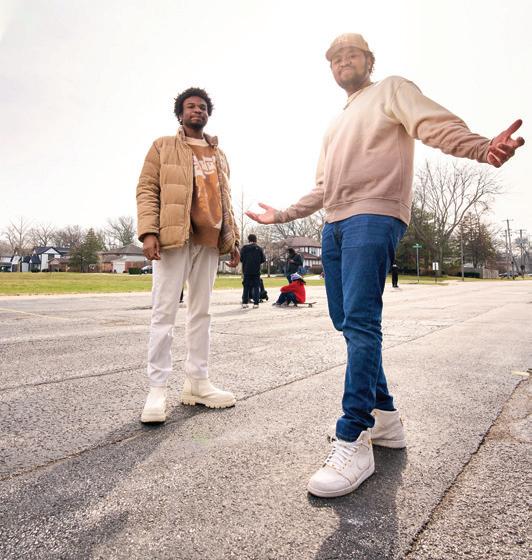
On the home stretch, Jordan and Jaylin discovered that the usual feedback from the Creative Mansion group chat had lost some of its usefulness. After years of listening to the developing tracks, their friends all liked them just as much as the duo did. “We’ve been listening to those songs for so long, so it was kind of hard to nitpick songs that are special,” Jaylin says. “Our friends have been listening to them for so long too, so it’s kind of hard to get an unbiased opinion.”
Jordan hopes to make a Creative Mansion album that will feature everyone in the collective. He and Jaylin are working to manifest that dream, and for now they can know that they’ve opened a door for their crew with The One Who Knocks. They made it for their friends as much as for themselves. “For everyone else in the group, this album means a lot to us, because we were watching that happen, and we love these songs,” Bill says. “These songs specifically, to our group, feel like classics.” v
@imLeor
54 CHICAGO READER - APRIL 14, 2022 ll
Jordan and Jaylin, aka Cloud Boy and J Wade MATTHEW GILSON FOR CHICAGO READER






APRIL 14, 2022 - CHICAGO READER 55 Stick Men David Nail Widowspeak OTHERPEACE Touched By Ghoul · David Zollo 4 / 19 @ Reggie’s 4 / 30 @ Joe’s on Weed 5 / 14 @ Beat Kitchen 4 / 28 @ The Hideout May 8, 7:30 PM North Shore Center, Skokie May 9, 7:30 PM Harris Theater, Chicago baroque.org/brothershaydn TICKETS START AT $25 CHORUS & ORCHESTRA The
THE BROTHERS HAYDN Let’s Play! Make time to learn something new with music and dance classes at Old Town School! We offer flexible schedules for all skill levels both in-person and online. oldtownschool.org Sign up for classes today at MUSIC CLASSES FOR ADULTS & KIDS LINCOLN SQUARE LINCOLN PARK SOUTH LOOP & ONLINE OTS_1_2V_ClassAd_072921.indd 1 7/23/21 2:21 PM
musical brothers Haydn were no strangers to sibling rivalry. Joseph traveled in fancy musical circles in Esterházy; Michael set up shop in Salzburg where he befriended the Mozart family. Decide which brother was better as Dame Jane Glover leads a celebration of each man’s unique artistry.
PICK OF THE WEEK
Recommended and notable shows and releases with critics’ insights for
the
CONCERT PREVIEWS
THURSDAY14
Jawbreaker See also Friday and Saturday. Jawbreaker also play a show with the same bill at the same venue and time on Wed 4/13. Built to Spill, Smoking Popes, and Irene Tu open. 7 PM, House of Blues, 329 N. Dearborn, $55$61.50. 17+

It’s been five years since iconic New York punk band Jawbreaker reunited—though two of those were inactive pandemic years—so that now the band’s second run has nearly matched the length of time they spent releasing records together in the early 90s. Their current tour, originally planned for 2020, is a belated 25th-anniversary celebration of their fourth album and major-label debut, 1995’s Dear You (DGC). It’s a chance for Jawbreaker to celebrate a record that didn’t get its due upon its release, in the process highlighting the wide-ranging appeal they’ve always had among tightly knit underground scenes. Because Jawbreaker are supported here by indie-rock institution Built to Spill and local Jawbreaker worshippers Smoking Popes (plus comedian Irene Tu), their Chicago shows effectively bisect punk, emo, indie rock, and alt-rock all at once. These were all scenes Jawbreaker had a foot in back in the day, but (much to the chagrin of genre purists) they never fully conformed to any one of them. As much as this tour is a way for the band to finally play “Fireman” to a room full of receptive fans (in the mid-90s, they were sometimes heckled for playing songs from Dear You due to its major-label connections), it’s also a chance to remind people that Jawbreaker have always done things their own way. And if you don’t think they still have that in them, look at setlist.fm—notwithstanding the trend of full-album sets, so far they haven’t played through Dear You in order even once. Jawbreaker are many things, but predictable has never been—and hopefully will never be—one of them.
—DAVID ANTHONY
Fri 4/22, 8:30 PM, Constellation, 3111 N. Western, $20, $5 streaming. 18+
THE MEMBERS OF THUMBSCREW are nonpareil instrumentalists. Drummer Tomas Fujiwara easily balances ornamentation and propulsion at any speed; double bassist Michael Formanek plays with a woody tone whose bulk belies his ability to invest each note with its own expressive inflection; and guitarist Mary Halvorson employs fluid phrasing and adroit manipulation of delay e ects that make her instantly identifiable in any setting. Each of them is a distinctive composer and veteran bandleader. But when they convene as Thumbscrew, no one’s the star or the boss. The trio have been playing together for 11 years, and the members have known each other for much longer. Their consequent rapport provides the foundation for a group dynamic in which each musician figures out how to make everyone else sound good and the soloing supports the integrity of the compositions. Thumbscrew have issued six albums to date, four of which are equally divided among the members’ tunes. Two more apply their methodology to other composers’ material, and the group sound as persuasive amplifying the music-box delicacy of Evelyn Danzig’s “Scarlet Ribbons” as they do negotiating the triple-helix bebop of Anthony Braxton’s “Composition No. 35.” Even during the pandemic, Thumbscrew stayed active; in 2020 they livestreamed a birthday celebration for Halvorson, and in 2021 they embarked on an international tour. The band have recorded a new album, Multicolored Midnight, that won’t be out until the fall; this concert is an early chance to hear some of its tunes. —BILL MEYER
FRIDAY15
Jawbreaker See Thursday. Built to Spill, Smoking Popes, and Irene Tu open. 7 PM, House of Blues, 329 N. Dearborn, $55-$61.50. 17+
SATURDAY16
Jawbreaker See Thursday. Built to Spill, Smoking Popes, and Irene Tu open. 7 PM, House of Blues, 329 N. Dearborn, $55-$68.50. 17+
FRIDAY22
Thumbscrew See Pick of the Week at le . 8:30 PM, Constellation, 3111 N. Western, $20, $5 streaming. 18+
56 CHICAGO READER - APRIL 14, 2022 ll
THUMBSCREW
Thumbscrew are an all-star ensemble where no one is the star week of April 14
MUSIC
b ALL AGES F
Thumbscrew: Michael Formanek, Tomas Fujiwara, and Mary Halvorson BRIAN COHEN
Two Houses Nervous Passenger and Babe Report open. 9 PM, GMan Tavern, 3740 N. Clark, $12, $10 in advance. 21+
I’m not sure if the title of Two Houses’ self-released new sophomore album, Can’t Fail , is a demand or an expression of optimism; the Chicago three-piece play workingman’s punk that confronts challenges with a mix of hard-assery and hope. Two Houses heave their songs into being, so that you can hear the labor that went into them: the rumbling bass, steel-toe guitars, and no-nonsense drumming give their music the heaviness of masonry and a rugged charm that comes from the aches and blisters that work implies. When Two Houses hoist a stack of vocals onto the hollered hook of the muggy single “Lost,” they overcome draining exhaustion to achieve genuine joy—thanks in part to the hardship they experienced along the way.
—LEOR GALIL
SATURDAY23
Waldos Forever Fest Junglepussy headlines. Sudan Archives, Jessy Lanza, and Glitter Moneyyy open, with additional performances by Shea Couleé (live and drag sets), Jezebelly, Bambi Banks-Couleé, Mom Jeans & Friends, Kitty Banks, Maureen SanDiego, Lucy Stoole, and Trqpiteca. 10 AM-9 PM, outside Dispensary33, 5001 N. Clark (intersection of W. Argyle and N. Clark). 21+ F

It’s mind-boggling to think that recreational weed wasn’t yet legal the last time Dispensary33 hosted an in-person Waldos Forever Fest—so named for the group of 1970s Bay Area high schoolers who dubbed themselves “the Waldos,” whose inside slang for their a ernoon meeting time can-
onized “4:20” as shorthand for everything cannabis. So it’s safe to say that this iteration of the very 420-friendly festival (held on the Saturday closest to 4/20) will be its biggest yet—it’s expanded from the 2019 festival grounds on Argyle (outside Dispensary33’s Andersonville space) to include Clark as well. Waldos Forever has certainly nabbed its biggest artists to date: Raunchy and raring-to-go hip-hop duo Glitter Moneyyy hold down the coveted local opening slot (1-1:35 PM), before kaleidoscopic electronic artist, DJ, and vocalist Jessy Lanza (3:45-4:30 PM) and violin mastermind Sudan Archives (5:15–6 PM). Headlining is New York rapper Junglepussy (6:45-7:45 PM), making her first Chicago appearance since 2018 on the heels of her fi ve-track EP Jp5000 , which came out in February. In addition to musical performances, the festival features live drag sets by Shea Couleé, Bambi Banks-Couleé, and Lucy Stoole (all Waldos Forever veterans), plus other hometown acts such as burlesque artist Jezebelly and multidisciplinary artistDJ duo Trqpiteca (those set times are all still TBA). Now for the catch: though cannabis is king at Waldos Forever Fest, public smoking remains illegal in Chicago. So if you plan to indulge, you might want to consider toking up somewhere private before or a er. (What? I’m not winking. Smoke in my eye.)
—HANNAH EDGAR
SUNDAY24
Candlemass Ruby the Hatchet and Frayle open. 8 PM, Thalia Hall, 1807 S. Allport, $24-$32. 17+
If you love modern doom, you owe a debt of gratitude to Candlemass. Formed in Stockholm in 1984, the group were among a handful of early purveyors of the slow, down-tuned, and monumentally forlorn heavy form of metal inspired by Black Sab-
bath. In fact, their 1986 debut album, Epicus Doomicus Metallicus, helped establish the genre’s name. Aside from two hiatuses of a couple years apiece, Candlemass have been trucking ever since, with founding member and bassist Leif Edling leading the way through various lineups. From 2014 till 2019 Edling had to step away from touring due to ongoing health issues, but he continued to write and record with the band in the studio. During that time, he and original guitarist Mats “Mappe” Björkman (who le for eight years in the mid-90s before rejoining in 2002) pondered the future of the band and decided that the best way forward was to reach back to their roots. Thus Candlemass surprised and delighted fans in 2018, when they announced they’d recruited a new front man: Johan Längqvist, who’d laid down the devastating vocals for Epicus Doomicus Metallicus as a session musician. Läng qvist’s first time singing live with the band was at a 20th-anniversary show for Epicus Doomicus Metallicus in 2007. The record turns 36 this spring, but if the Längqvist era 2.0 is any indication, this Candlemass gig at Thalia Hall won’t feel like a tired rehashing of the past. Their 12th record, 2019’s The Door to Doom (Napalm), returns to their doomy foundations, magnifying Edling’s dynamic songwriting with Längqvist’s powerful presence—and Sabbath fans take note, “Astorolus— the Great Octopus” features a searing guest solo from Tony Iommi. (The track landed them their first Grammy nomination, for Best Metal Performance.) This set will include Candlemass material past and present, and we can hope the band will play their cover of Trouble’s “The Tempter,” recorded in tribute to Eric Wagner, vocalist of that pioneering Chicago doom band, a er he passed away last year. (Wagner’s group the Skull was slated to open this concert when it was announced in 2020.) Come early for Philly psych rockers Ruby the Hatchet and gloomy Cleveland crew Frayle, and stay till the end to fill your soul with earthshakingly heavy epic doom. —JAMIE LUDWIG
ALBUM REVIEWS
Earthen Sea, Ghost Poems Kranky earthensea.bandcamp.com
Jacob Long has been knee-deep in the DIY punk underground over the past two decades, spending time in a couple of beloved bands. In the early aughts, Long doled out a batshit-crazy mess of postpunk and free jazz with his pals in the waytoo-short-lived Dischord Records outfit Black Eyes before jetting from D.C. to San Francisco to make a dubby racket in Mi Ami. Not too long a er the dissolution of those groups, Long reinvented himself as Earthen Sea, a one-man project whose revelatory melding of dub, techno, ambient, and electronic music feels like it could set off mind-altering episodes. In recent years, Long has been prolific as Earthen Sea, churning out a small mountain of fulllengths and singles (check out his ever-ballooning Bandcamp page), and his output on Chicago’s Kranky label is next-level stuff. His craftsman’s affinity for heady, low-key soundscapes has produced epic slabs of hypnotic beauty, such as the feather-light beat-driven techno grooves of 2017’s An Act of Love and the atmospheric abstractions of 2019’s Grass and Trees. He explores similar vibes on his arresting new third album for Kranky, Ghost Poems . Pieced together in Long’s New York City home studio while he was holed up during the first lockdown, its ten trippy experiments ooze an airy mix of turbulence and claustrophobia. The album could be thought of as a soundtrack to the pandemic; these clattering tunes feel perfect for blaring out of earbuds while you walk through desolate streets. Long’s knob twiddling, synth splatter, and found recordings have an unsettling quality, but the sonic vistas created by his tones and patterns seemingly fl oat in from above like little miracles that ease the mind. Long also aces spaced-

APRIL 14, 2022 - CHICAGO READER 57
MUSIC
Sudan Archives ALLY GREEN
Jacob Long, aka Earthen Sea DEBBIE TUCH
MUSIC
Find more music listings at chicagoreader.com/musicreviews
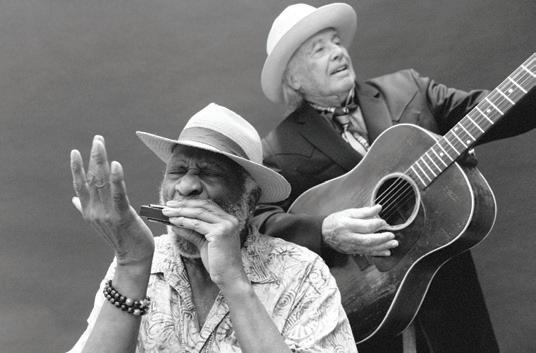
out hooks and dance-inducing rhythms, and these meditations melt into each other effortlessly. Woozy, pulsating tracks such as “Slate Horizon,” “Deep Sky,” and “Stolen Time” feel like alien transmissions from some other galaxy. Ghost Poems is a glorious escape, its rich textural weirdness and otherworldly drones offering fans total immersion within seconds of pressing play. —BRAD COHAN
Purelink,
Puredub
Lillerne Tapes lillernetapes.bandcamp.com/album/puredub
As the trio Purelink, Chicago producers Millia Rage, Kindtree, and Concave Reflection explore the seams joining ambient music and dance. The tracks on Purelink’s 2021 Bliss/Swivel EP fl oat like their rhythms are on the edge of dissolving (“Maintain the Bliss”) or transform the hyperactive sounds of drum ’n’ bass into ghostly apparitions (“Head on a Swivel”); the EP’s tantalizingly unpredictable texture and tone made it one of my favorite releases of that year. I’m just as enamored with their debut full-length, Puredub (Lillerne Tapes). Purelink savor the slow tapering of echoes, and on “Rest Thru” they map gated, skeletal drum loops onto hazy synths in a bejeweled, hypnotizing matrix. In Purelink’s hands, “ambient” means more than a pleasant, ignorable audio wallpaper—they inject it with drama and energy without disrupting its serenity, encouraging people to dance as well as to relax. On “Spirit & Sport,” the sounds of chiming bells and gently rattling chains flutter in and out of the mix, enhancing the song’s tranquil mood—they’re one of many ways Purelink can, well, maintain the bliss.
—LEOR GALIL
Claire Rousay, Everything Perfect Is Already Here Shelter Press clairerousay.bandcamp.com/album/everythingperfect-is-already-here
Prolific experimental percussionist and electronic musician Claire Rousay has created a sprawling body of work that clunks and patters some-
where between noise and silence, music and abstraction. Her new release, Everything Perfect Is Already Here (out April 22 on Shelter Press), consists of two 15-minute ambient explorations that rustle and dissolve in gentle lyrical spasms. She’s joined by the marvelous Marilu Donovan of New York duo Leya on harp, Theodore Cale Schafer on piano, Mari Maurice on electronics and violin, and Alex Cunningham on violin. Rousay previously collaborated with Cunningham on 2020’s clattering and abrasive Specifically the Water (Astral Spirits), but Everything Perfect occupies the opposite end of her sonic palette—it’s a mixture of classical and new age. Romantic sections that recall Debussy lilt and dream and then give way to quiet thumping and muttering, as if the performers had grown tired of playing and decided to get up and drag their instruments around the lo for a while. Rousay treats conventional music and its absence as indistinguishable and equivalent in a way that’s reminiscent of John Cage; you almost don’t notice when the album ends. I found myself listening to a neighbor hammering and a car passing in the street before I realized they weren’t part of the music. Like the title says, Rousay makes music of everything perfect that is already here.
—NOAH BERLATSKY
Cisco Swank & Luke Titus, Some Things Take Time
Sooper
luketitus.bandcamp.com/album/some-thingstake-time
Chicago drummer Luke Titus and New York rapper- singer Cisco Swank unite jazz, R&B, and hip-hop on their new album, Some Things Take Time (Sooper). Brief but stimulating, the record feels like a walk around the block as the neighborhood awakens. Swank and Titus are both young multi- instrumentalists and producers with prodigious backgrounds: Swank attended New York’s famed LaGuardia High School of Music & Art and Performing Arts and is continuing his studies at Berklee College, while Titus became the youngest musician to join the Blue Man Group when he was hired at age 15. They began collaborating in April 2021, a year a er connecting over social media.
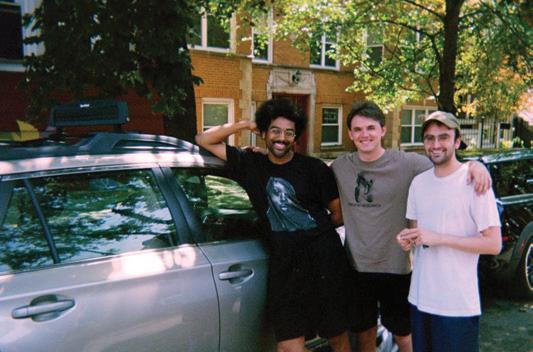
The music on Some Things Take Time often feels like something overheard outside a practice room a er hours. On “Joint 5,” a breakbeat infl uenced by drum ’n’ bass duels with Swank’s calm ascending piano melody as though they’re parts of two different songs united only by their tempo. Though the track threatens to fall to pieces in a clatter of Titus’s snare drums, it ends on the downbeat after a breakneck minute and a half of the same breakbeat-and-piano progression. The duo’s disinterest in typical song structures can make for an unpredictable listen. “Joint 10” begins as an up-tempo showcase for Braxton Cook’s saxophone, whose layers bend in and out of harmony via extended technique or post-facto digital smearing. Then a tape machine clicks, a voice mumbles “Let’s try that other joint,” and the track transitions into a laid-back beat anchoring a haze of synth. On “Could It Be You,” Titus sings cryptic lyrics about entropy and romance through several layers of dissonant vocal effects, a la his collaborator and Sooper labelmate Sen Morimoto. Once again, the duo follow the intense tempo of the track’s first part with a slower, looser groove, almost like a digestif.
Some Things Take Time also features appearances from two of the best young rappers in Chicago, both rhyming about thriving in a corrupted city. On “Nothing’s Changed,” Saba raps about uncles faking clean urine samples, grandmothers saving money for bail, and “the differences between a handout and having assistance.” The bouncy chorus makes clear he’s not lamenting hardship but accepting it. Pivot Gang collaborator Femdot taps into similar themes on “Joint 4,” reflecting on working part-time jobs to support his music: “One thing I know now if I ain’t know it before,” he mumbles, “maintaining sanity is a contact sport.” Fox Valley producer and multi-instrumentalist Phoelix contributes a wordless vocal melody to the title track, bringing the same warm vocal tone he contributed to Noname’s 2018 song “Window” (from her album Room 25 , where Phoelix produced and Titus played drums). These vocal features tap into the same giddy feeling of possibility as Swank and Titus’s instrumental passages. Some Things Take Time finds the common ground between jazz album and beat tape: it grooves unbound by song structure and communicates with more than words. —JACK RIEDY

58 CHICAGO READER - APRIL 14, 2022 ll
Taj Mahal & Ry Cooder ABBY ROSS
4/20 Dendê 4/27 Kaleta & Super Yamba Band WORLD MUSIC WEDNESDAY SERIES FREE WEEKLY CONCERTS, LINCOLN SQUARE OLDTOWNSCHOOL.ORG 4544 N LINCOLN AVENUE, CHICAGO IL OLDTOWNSCHOOL.ORG • 773.728.6000 SATURDAY, APRIL 16 2PM Muriel Anderson Multimedia Concert with Stunning Visuals In Szold Hall FRIDAY, APRIL 22 8PM Nellie McKay In Szold Hall SATURDAY, APRIL 23 8PM Stephen Wade A Storyteller's Story • In Szold Hall THURSDAY, APRIL 28 8PM Juana Molina In Maurer Hall THURSDAY, MAY 5 7PM Identity Dance Concert - Fearless with live music featuring Chromabeats In Szold Hall THURSDAY, MAY 5 8PM Steven Page (formerly of Barenaked Ladies) In Maurer Hall FRIDAY, MAY 6 7PM Chicago Immigrant Orchestra / Zeshan B. at the American Islamic College Auditorium MONDAY, MAY 9 7:30PM Chicago Cabaret Professionals Musical Mondays Pop Goes the Cabaret • In Szold Hall WEDNESDAY, MAY 18 9:30PM Valerie June with special guest Chastity Brown • In Maurer Hall UPCOMING CONCERTS AT NEW SHOWS JUST ANNOUNCED • ON SALE NOW 6/26 John Doe Folk Trio 7/23 Joan Shelley with James Elkington, Spencer Tweedy, Nick Macri, and Nathan Salsburg FOR TICKETS, VISIT OLDTOWNSCHOOL.ORG
Purelink COURTESY THE ARTIST
continued from 57
Soulful musical polymath Taj Mahal and guitar god Ry Cooder go way back. In the mid-60s, they played in Los Angeles band the Rising Sons, one of the country’s first integrated bands fusing rock and R&B (along with Arthur Lee’s Love). The group also featured jazz drummer Ed Cassidy (later of Spirit) and bassist Gary “Magic” Marker (already of Cap tain Bee eart’s Magic Band), and for a hot minute they seemed poised for success—but then Columbia Records shelved their LP, and they split in 1966. Sub sequently Taj Mahal went solo, and though Cooder had joined the Magic Band himself, he backed Taj Mahal on his classic self-titled 1968 debut LP. The two soon parted ways musically, but they led wildly diverse careers that turned out oddly similar to each other. As a singer-songwriter, multi-instrumentalist, and film composer, Taj Mahal developed a distinc tive and evolving vision, incorporating elements of American folk, blues, and jazz as well as Caribbe an, African, Indian, and South Pacific sounds. Cood er, operating mainly as a guitarist and producer, has likewise worked on film soundtracks as a solo artist and session man, and he’s also traversed the globe— he’s drawn on many traditional styles and collaborat ed with African musicians as well as artists making Tex-Mex, gospel, and Cajun music.
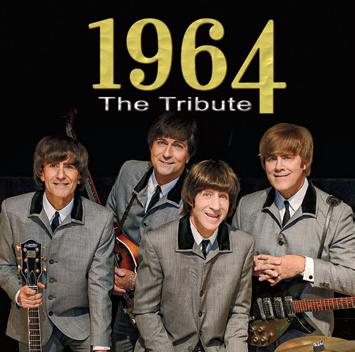



With their shared interests and history, it makes sense that Cooder and Mahal would rejoin to cel ebrate their musical roots—in this case, the primor dial southern blues of Sonny Terry and Brownie McGhee. The duo began playing together in 1939, and their Piedmont style helped define folk blues, which flourished in New York City’s club scene throughout the 40s and 50s. Taj Mahal (vocals, har monica, guitar, and piano), Cooder (vocals, guitar, mandolin, and banjo), and Cooder’s son, Joachim (drums and bass), worked together to cut their own versions of 11 songs recorded by McGhee and Terry (a “wizard harmonica player,” according to Taj Mahal). The tunes I’ve heard so far from Get on Board: The Songs of Sonny Terry & Brownie McGhee (I couldn’t get an advance copy in time) honor these musical forefathers. The album’s raw take on the


mandolin-fueled “Hooray Hooray” features Taj Mahal wailing on harp in a style that recalls Terry’s. Cooder has never been famed for his singing, but on the gospel standard “I Shall Not Be Moved,” his everyman delivery works (with a big assist from Taj Mahal’s vocal harmonies). In 2022, it’s jarring to hear “Pick a Bale of Cotton,” a traditional folk song that’s been criticized for glorifying slavery (its extremely racist lyrics were amended in recordings by Lead belly, Johnny Cash, Terry and McGhee, and oth ers). But a seasoned bluesman like Taj Mahal, with Cooder alongside him enthusiastically picking and echoing the chorus, can pay tribute without perpet uating negative stereotypes. There’s other material that wouldn’t fly if it were written today: McGhee and Terry adapted “Cornbread, Peas, Black Molas ses” from a field song about southern prisoners subject to medical experiments. But again, the for mer Rising Sons pull it off with class and reverence. Get on Board is a history lesson as much a celebra tion of their musical forbears. —STEVE KRAKOW

Asher White, Architecture Exuberant!




Self-released asherwhite.bandcamp.com/album/architectureexuberant









To make her whimsical new indie-folk album, Archi tecture Exuberant!, Chicagoland native Asher White used a dozen or so instruments—including, as she writes in the liner notes, a broken accordion and a drum set she bought off eBay. Her kitchen-sink approach—which also involved guiro, banjo, pre pared piano, and ceramic plates—gives Architecture Exuberant! a charmingly ragged, bucolic earthiness. White’s easygoing songwriting accentuates the inti macy of her diaristic, impressionistically detailed lyr ics, while the quasi-symphonic instrumental harmo nies in her arrangements balance stateliness against a homemade bedroom-pop feel. White is still finish ing up her undergraduate education at the Rhode Island School of Design, and she brings youthful enthusiasm and open-heartedness to this material.
On “Colorwheel (J.M.W. Turner),” her resplendent synths, marching-band-style drumming, and layered vocal harmonies build to a technicolor crescendo with the same heart-on-sleeve euphoria that drew me to Arcade Fire. —LEOR GALIL v





















APRIL 14, 2022 - CHICAGO READER 59
Cisco Swank & Luke Titus ERIK “EBAR” BARDIN
Taj Mahal & Ry Cooder, Get on Board: The Songs of Sonny Terry & Brownie McGhee Nonesuch rycooder.bandcamp.com/album/get-on-board
MUSIC 22_1008_GEN_Ad_Chicago_Reader_APR_JT01Mod:April5,202210:12AMPrint:04/05/2212:32:10PMpage1v7 GENESEE THE SPOTLIGHT IS CLOSER THAN YOU THINK THE 203 NORTH GENESEE STREET, WAUKEGAN, IL BOX OFFICE HOURS: TUE–FRI 11 AM- 4 PM, SAT 10 AM - 2 PM TICKETMASTER: 800-982-2787 • PH: 847-263-6300 SHOWS YOU WON'T WANT TO MISS! GENESEETHEATRE .COM Thursday, May 12 7:30 PM Friday, September 16 8:00 PM Saturday, May 7 7:30 PM "Eight Days a Week" and "I Saw Her Standing There" "Tom Sawyer" and "Closer to the Heart" With Special Guest Dishwalla "Runaway Train" and "Somebody to Shove" Enter to win! chicagoreader.com/contests
MUSIC
Beau O’Reilly keeps the folk cabaret alive
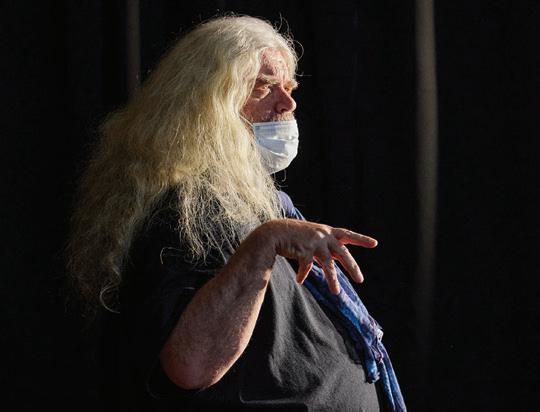 By MARK GUARINO
By MARK GUARINO
The email Paul Finkelman received last month from Beau O’Reilly read simply, “Can your car fit a piano? . . . Please advise.”
The answer was obviously no. Finkelman owned a small hatchback—and besides, there was no way a piano would make it up the narrow stairs at Jimmy Beans Coffee, where he works as manager. O’Reilly has recently transformed the cozy second-floor room above that Logan Square storefront co ee roaster into a weekend cabaret. It’s quickly become a home for folk singers and other left-of-center performers orphaned by the dwindling number of venues that cater to intimate listening—in recent years, for instance, No Exit and the Heart-
land Cafe both shuttered after decades-long runs.
Hours later, O’Reilly and “three European guys in track suits” showed up with the piano, says Finkelman. In under an hour they somehow hauled it upstairs in time for the show that Saturday night: singer-songwriter Vernon Tonges, who accompanies his full-throated howl with his stomping foot, and Crooked Mouth, O’Reilly’s rock band, now in its 14th year. “It’s been a good kind of crazy,” Finkelman says of the cabaret, which opened in March. “To know Beau is to know Chicago.”
Indeed, O’Reilly has been a fixture on the city’s theater and music scenes since the late 1970s. That’s when he moved here from
DeKalb, where he cut his teeth in the folk world by booking Juicy John Pink’s, a club that he and his friends briefly took over in 1975. At the time, folk music had largely died as a popular phenomenon in America, except in Chicago—here it breathed a second life throughout the decade due to a healthy ecosystem of clubs in Old Town and Lincoln Park, where singer-songwriters such as John Prine, Fred Holstein, Michael Smith, and Steve Goodman honed their craft.

O’Reilly either saw or booked all of them, including national folk music luminaries Greg Brown, Eric Andersen, Rosalie Sorrels, and Sonny Terry & Brownie McGhee. A revelation he had in those days is what drives him, at age
68, to use Jimmy Beans to make his return to booking shows: tiny rooms are mighty rooms for making it easier to showcase “work that’s surprising and well-made.”
“You can really see the craft. One or two people with acoustic guitars can not only do that as well as a big band, but they can do it more fluidly,” O’Reilly says. “And that’s a remarkable thing to experience for an audience member—work being made especially for you right in front of you. It’s a rare thing.”
The cabaret space at Jimmy Beans holds about 25 people, which means every performance is a boutique experience. O’Reilly greets audience members downstairs in the cafe and directs them up a narrow wooden staircase that leads to what could be an apartment living room—except for the PA system, the lighting rig, and the wooden risers with seats.
“There’s nowhere to go—it’s a captive audience,” says Chris Schoen, a member of Theater Oobleck who has long incorporated songs into theater performances. On a recent Saturday night, he used his Jimmy Beans set to do something that’s unfortunately become rare in the world of Chicago folk: perform solo to a room of active listeners. During his set he broke the fourth wall to poll the audience about chord progressions, chatted up a woman in the front row who’d brought her comfort dog, and spoke about the influence of the late Ohio songwriter J.D. Hutchison before performing Hutchison’s “Since My Bird Has Flied Away,” a mesmerizing ballad elevated by Schoen’s fluid and playful fingerpicking.
“You want to be seen and heard, and that’s why you do it, but that comes with risks and vulnerability,” Schoen says. “It’s a good scary.”
Jimmy Beans opened in 2016. Finkelman, 32, was hired in 2018 and soon started using the upstairs space for community events: art shows, a Juneteenth exhibition, meetings by local groups. O’Reilly met Finkelman in a classroom at the School of the Art Institute of Chicago, where he teaches writing and Finkelman is among his students. “It’s hard to find anywhere in a big city to just gather, especially if you want to do art,” says Finkelman, who

60 CHICAGO READER - APRIL 14, 2022 ll
Beau O’Reilly at Jimmy Beans Coffee, including (at lower le ) in the audience at the show upstairs on Saturday, April 9 SARAH JOYCE FOR CHICAGO READER
His weekend bookings upstairs at Jimmy Beans Coffee preserve the intimacy, smarts, and daring of this endangered musical tradition.
DECONSTRUCTING DESOLATION ROW
Performances by Jayita Bhattacharya, Frank Bonacci, Michaela Chan, and Bill Ferguson, who will respond in song and lecture to Bob Dylan’s ballad “Desolation Row,” from the 1965 album Highway 61 Revisited Fri 4/15 and Sat 4/16, 7 PM, Jimmy Beans Coffee, 2553 W. Fullerton, second floor, $18 or pay what you can, all-ages
MUSIC
says the pandemic has further eroded people’s desire to get together. COVID continues to hurt many music clubs and theaters, but O’Reilly figures that keeping things small—fewer seats to fill, less risk—could be a sustainable path forward.
“Fringe theater and acoustic music get away with making smart work right now that big venues can’t,” O’Reilly explains. “Partly because I don’t have to sell 300 tickets tonight in order to do my show. I just have to sell 15. Because my show is for those 15 people. And I’m OK about that. I’m hungry for it. I want that kind of direct connection.”
That formula has been a hallmark of O’Reilly’s since the beginning. He came into this world in a big family—he’s the fifth of 14 children—that was squeezed tight into a small cottage in Crystal Lake. His parents were both theater performers, singers, and writers; his father, James O’Reilly, was notably the artistic director of the Court Theatre at the University of Chicago and the Body Politic Theatre in Lincoln Park. O’Reilly likewise became a pillar of the theater scene, cofounding the Curious Theatre Branch and working as a prodigious playwright and actor; he’s also recorded and performed with numerous musical groups, including Crooked Mouth and Maestro Subgum & the Whole.
For O’Reilly, as with most music and theater artists on the fringe, going small has always worked best to create moments that are di cult to forget. One night in December 1994 at the Lunar Cabaret (a Lincoln Avenue storefront where O’Reilly booked for about five years in the 90s), Texas singer-songwriter Townes Van Zandt watched one of O’Reilly’s plays early in the evening, then headlined the late show. Van Zandt, at that point little known outside folk-country circles, was deep into his alcoholism. In the 25-seat room, he sat on a stool and watched the play. When it was over, he turned to O’Reilly and asked with utter sincerity, “Can you write me something and make me beautiful too?” When Van Zandt performed Bruce Springsteen’s “Racing in the Street” that night, he started crying and couldn’t finish. He was dead two years later.
To open for Van Zandt, O’Reilly had booked Diane Izzo, a local songwriter and friend he helped showcase over the years. She too didn’t fit the traditional folk mold; her dark and lyrical self-titled 1999 album drew comparisons to Patti Smith and Nick Drake, and her songs were later covered by the likes of Jim James from My Morning Jacket. She died in 2011.
Lunar Cabaret, like other small homes
O’Reilly has created for acoustic music over the years, belonged to a fading tradition of folk clubs. In Chicago, the phenomenon of the folk singer as we understand it today dates back to the 1950s with the College of Complexes, an itinerant space that for decades hosted freewheeling soapbox debates, art shows, poetry, plays, and music, as well as the Gate of Horn, the nation’s first nightclub exclusively dedicated to folk music. The tradition later found fertile ground at the Fifth Peg, a Lincoln Park storefront where John Prine got his start, the Earl of Old Town, Somebody Else’s Troubles, and Holsteins, and later still at the Heartland Cafe and No Exit, both in Rogers Park.
Today, house concerts make up the majority of the touring circuit, though several venues continue to operate in the Chicago area: the two locations of Uncommon Ground and the Gallery Cabaret, all in the city, the Two Way Street Coffee House in Downers Grove, and the monthly Maple Street Concerts series in Lombard, among others.
Chicago folk singer Andrew Calhoun, whose career stretches back to the days O’Reilly booked him at Juicy John Pink’s, calls the Jimmy Beans space “an ideal venue” because “it has the intimacy of a house concert with the focus of a theater.” Calhoun, who will play the room on June 3, headlined it last month. He sang original songs plus others transcribed from Scottish poet Robert Burns, all without the PA—primarily because, to him, it sounded more natural that way. It’s a style tailored for attentive ears. The cabaret “is exactly what I need as an outlet where I know people will be listening,” he says.
The cabaret is not only for longtime practitioners but also for newcomers. A triple bill last month included Evan Wood, an SAIC student exploring songwriting, and Jim Joyce, a Chicago high school English teacher who played a deconstructed set of folk-punk and comedy.
Encouraging new folk-minded songwriters by giving them a space is O’Reilly’s new mission. The music, powerful in its minimalism, deserves it, he says.
“It’s a precious commodity—this was hugely important music, not only in 1966 but in 1936. It’s how culture moved around the country,” O’Reilly says. “Woody Guthrie wrote hundreds of songs, not because he was bored but because there was a lot to talk about. That’s something that’s worth preserving and is still what makes it exciting.” v
APRIL 14, 2022 - CHICAGO READER 61
@markguarino
Del Hale, aka DJ Miss Twink USA of Rumors and Legion of Doom
To friends and family, they’re Del Hale, a 23-year-old Chicago native finishing their English degree at East-West University. But in the electronic-music community, they’re Miss Twink USA, a dandy bimbo bringing viciously fun party poetry to the DJ booth. Since starting out in the DIY rave scene six years ago, Hale has been playing music to express themselves and find community. Now they’re regularly packing clubs locally and out of state.
Miss Twink USA is part of the crew at Rumors, a party founded by legendary mix master Ariel Zetina. In October 2021 they started a monthly all-Black electronic night at the Empty Bottle called Legion of Doom with DJs Fuj and Niiiiggggaaaaa (aka Andrew Mainor and Shaun LaCosta-Sinclair). And along with DJs Sydfalls and Zolita, in January they received a Broadcast Lab grant from Boiler Room TV to curate a production called Silk
Is Smooth that will drop in May. They’re calling it a “broadcast concept,” and it will fuse sounds from the current underground with gospel, house, footwork, and drill to celebrate Black Chicago’s rich history of using music to imagine new futures.
When I was 17, I moved to North Lawndale and went to an alternative school—not because I was a bad kid or anything, just because I was anxious and wanted to finish early. I grew up very shy and didn’t have that many friends. I had just moved back into the city, and my life was at a weird standstill. I really wanted to find cool people that looked like me and thought like me. I was looking for a chosen family.
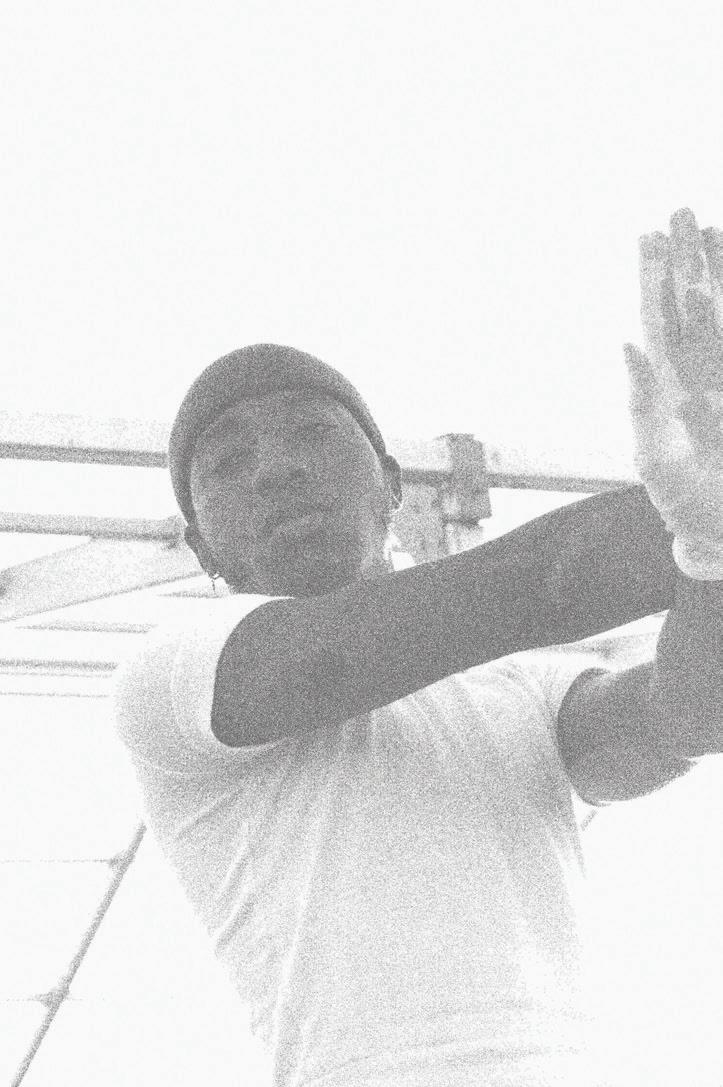
This was around the time when club kids like Imp Queen, Wanna Bon Bon, and Lucy Stoole were popping up. I pretty much followed all the drag queens online, but this was a weird sweet spot because a lot of DIY stu was happening in Chicago at the time too.
I went to a squat party that was all-ages. My friends at the time were getting kicked out of their squat, and some anarchists were taking it over. I’ve been to squat parties where people are like, “Let’s break shit!” But these people were like, “Let’s throw a party! Let’s do a set!”
People were playing music off their own computers. Strobe lights in the corner of the room. It was just packed with anarchists and their friends. And I met the person who became my best friend, Itsï. She’s more in the noise scene, but she was DJing there. Like, suddenly I met every single person that’s in my life now. They were all DJs there, and it was just the coolest shit I’d ever heard in my life.
There was jungle, techno, ambient, and experimental stu , and I thought it was really fascinating. I thought I could match that energy with something crazy. Right after that party, I started making mixes on my computer—just, like, cutting and pasting all these songs, editing with Audacity.
A lot of this was around when I discovered Mister Wallace, Sophie, A.G. Cook, and Traxman. Going out, I didn’t hear a sound that sounded like the music that I grew up listening to—you know, a lot of house and rap and R&B. I felt like there wasn’t a spot for that in the DIY rave scene, and I was like, “Yeah, let’s make a spot for yourself!” I never knew that it was
gonna become something big. I just thought of it as another way to express myself.
My first DJ gig was at a DIY party. I moved in with people I met at that squat party, and we were like, “Let’s start a party.” And we did that a lot—just throwing parties at our house. And people would come through and have fun with us. So that gave me the courage to keep going, and I started playing di erent house parties around the city. Eventually, that brought me to playing Rumors for the first time when I was 18 or 19. That was my first club gig. I was so excited because it was the party I loved going to with my little fake ID.
Not gonna lie, I didn’t know what to expect. I didn’t really know how to play on CDJs or anything. At that point, I made all my mixes with Audacity. They were preprogrammed. I didn’t know how to mix in real life. I was completely self-taught, and this was a way of DJing that I just didn’t know, and I had to learn on the fly. But I always had a certain energy I was going
LEGION OF DOOM
Hosted by Dutchesz Gemini, with sets by Zolita, Sulfurrrrrrr, Ty Jones, and Rika B. Tue 4/19, 10 PM, Empty Bottle, 1035 N. Western, $10, 21+
MISS TWINK USA
Late Night at Berlin, running till 4 AM with other acts to be announced. 10 PM, Berlin, 954 W. Belmont, ticket price to be determined, 21+
LORAINE JAMES, MISS TWINK USA, PURELINK Thu 5/5, 9:30 PM, Hideout, 1354 W. Wabansia, $15, 21+
for, even then. It was crazy to come full circle and be invited to be part of the Rumors crew years later. I love them so much.
After that, I was kind of just thrown into the world of DJing. I went from one gig a month to two gigs a month, and I’ve been just very blessed and thankful that it’s been like that until 2020, when everything shut down. I practice day in, day out, sunrise to sunset, every single day. Like, every single night, just practicing my craft with people who really saw my potential and thought I was cool. Now I’m playing multiple gigs a month and traveling.
I just keep getting more imaginative. Lately, my style has grown into something a little more electronic. I still love the club sound—I will always call myself a club DJ. But lately I’ve
62 CHICAGO READER - APRIL 14, 2022 ll
ANNEASHA HOGAN
MUSIC
CHICAGOANS OF NOTE
“I want to remind people that they are a fucking beacon and unstoppable and a superstar.”
As told to MICCO CAPORALE
been trying to pull in brighter sounds from electronica. And I think blends are so fun. I love to have a smarter blend, then throw out some real random shit. I’ve also been listening to a lot of electroclash. There’s so many inspirations everywhere.

I’m a writer, so my mixes have these, like, weird story lines or moments—like a kick to the head or something bubbly. I’ve been thinking about the most poetic but fascinating things I can translate into music.



There’s some songs I wrote during quarantine where I was like, “I’m gonna go through this feeling of, like, you’re at a packed club, and you’re walking around. You’ve got a drink in your hand, but everybody’s bumping into you. Your drink is falling onto them, their drinks are falling onto you. It’s that feeling of getting bounced around this club maze, and your clothes are wet. Everything’s wet.” That’s what I wanted to capture.
When I play a show, I try to think about the night itself. Like, I look at the flyer and think what people are looking forward to. I’m like, “OK, give them what they want, then flip it on its head.”

I got the name Miss Twink USA when I started out because I had this really bad friend who was trying to insult me one time. They were like, “What are you up to tonight?” and I was like, “Oh . . . I don’t know if I’m up to anything.” And they were like, “ Oh, I’m surprised Miss Twink USA doesn’t have anything to do!” But I thought that dig was, like, so genius. I don’t even look like a twink anymore? But it’s just stuck. It cracks me up. It’s the gift that keeps on giving. The other day somebody called me Miss Twink UK, and I was like, “Oh! We’re going international!” Miss Twink is complete superstar energy. The persona is kind of unwarranted and in-your-face—but a little dandy. It’s silly, it’s campy. She’s just a cool

fucking girl.

It’s honestly the most self-reflective part of me—but it’s funny. It’s so funny to me. Also, more Black people should express their sexuality. I feel like we don’t because we are often fetishized in some weird fucking way. To take my own sexuality back and put it into a character that’s also some of who I am . . . that’s so fun. I’m stepping outside of myself every single time I perform. I’m embracing and trying to liberate myself. There’s so many things in the world we can get tripped up on, but I want to remind people that they are a fucking beacon and unstoppable and a superstar.
Chicago is heavily misunderstood. Like, most of the DJ art here came from mostly Black and Brown people of Chicago and Detroit. We don’t get our props, but the Black talent we have is still fucking impeccable. I’ve heard some crazy cool fucking shit on the dance floor that I’ve never heard before. Even right now,
with my project that I’m doing with Fuj and Niiiiggggaaaaa at the Empty Bottle—Legion of Doom—we’ve been wanting to highlight Black artists as much as we can, because there’s not a lot of shows with an all-Black techno lineup! It’s really crazy.
I want there to be way more shows for all of us. There’s so many cool Black artists here that need way more lifting up. It’s a shame for people to just, like, not pay attention to everybody.
I wish people would be more imaginative about going out and what they want to hear, then follow and support these beautiful people. To live o your art right now is one of the hardest things to do in America, especially if you’re Black. So show up to these people’s shows. You might get a kick out of something, you know? v


APRIL 14, 2022 - CHICAGO READER 63
MUSIC LIVE MUSIC IN URBAN WINE COUNTRY 1200 RANDOLPH STREET, CHICAGO, IL 60607 | 312.733.WINE don’t miss... Coming Soon... Melanie Fiona 4.22 Jonatha Brooke 4.19 Candlebox Asleep at the Wheel 5.8 4.26 4.24 DAN DEACON PRESENTED BY DISPENSARY 33 - 1 PM 4.24 ARI HEST WITH SARAH MARIE YOUNG 4.27 IDES OF MARCH 4.28 4.29 ALAN DOYLE WITH CHRIS TRAPPER 5.1 MIDNIGHT SUN 4.15 ELLE VARNER WITH DJ AKTIVE 4.17 4.18 JUSTIN FURSTENFELD OF BLUE OCTOBER 4.20 THE QUEBE SISTERS 4.21 THE CLAUDETTES WITH BETH BOMBARA 5.3 SWEET WATER WARBLERS 5.5 EILEN JEWELL 5.9 ERTHE ST. JAMES 5.10 TAKE ME TO THE RIVER ALL-STARS NEW ORLEANS 5.14 MICHAEL MCDERMOTT 4.25 5.15 SONDRE LERCHE 5.16 ARIEL POSEN 5.17 5.18 MARC COHN 5.20 BILAL 5.22 BEATLES BRUNCH 5.22 5.23 THE CAROLE KING & JAMES TAYLOR STORY 5.25 YAEL NAIM 5.26 5.27 THE STEELDRIVERS 5.29 TERISA GRIFFIN 5.31 NATALIE CRESSMAN & IAN FAQUINI
@JuggaloReporter
EARLY WARNINGS
cord Music Hall b Zeshan B. 4/28, 7 PM, the Promontory b
UPDATED
b ALL AGES F
Never miss a show again.
NEW
Action/Adventure, Boys of Fall, Rare Candy, Wolf Rd, Weighted 4/30, 7 PM, Subterranean, 17+
Air Credits, Big Silky 4/30, 8:30 PM, Empty Bottle Karrin Allyson Quartet 5/6-5/7, 8 PM, Green Mill
Mohammed Assaf, Omar Al-Abdallat 5/13, 8 PM, Copernicus Center, 18+ Bearcubs 4/30, 9 PM, Schubas, 18+
Jason Bieler & Jeff Soto 4/30, 7 PM, Bananna’s Comedy Shack at Reggies S. Carey, Courtney Hartman 4/30, 9 PM, Lincoln Hall, 18+
The Carousel Tour featuring Anthony Green, Laura Jane Grace, and Tim Kasher 5/3, 7 PM, Thalia Hall, 17+ Chicago Ensemble 5/22, 3 PM, International House, University of Chicago b Claude VonStroke 6/11, 10 PM, Cermak Hall at Radius Chicago, 18+
Elio 5/1, 7 PM, Schubas b
Ensemble Correspondances 5/13, 7:30 PM, Logan Center for the Arts b
The Funky Brunch presents DJ Boring, Kryptogram, Tommaso 5/1, noon, Headquarters Beercade
Aurela Gaçe & AG Band, Eli Fara 5/28, 7 PM, Patio Theater b
Vivian Garcia 4/28, 5 PM, Epiphany Center for the Arts F
Greet Death, Infant Island 4/29, 9:30 PM, Empty Bottle Groupchat, Paige & the Kizers, Road Waves, Jeebs, Oracle Blu 6/24, 8 PM, Reggies Rock Club, 17+ Grum 7/1, 10 PM, Prysm Nightclub
Steve Hackett 5/5, 7:30 PM, Copernicus Center b House Trio 5/26, 7:30 PM, Epiphany Center for the Arts Vijay Iyer and friends 5/6, 7:30 PM, Logan Center for the Arts b
Johnny Goth, Dearly Somber 4/29, 9 PM, Schubas, 18+
Kim Gordon and Sinéad Gleeson discuss women in music with Puja Patel 5/10, 7 PM, Music Box b
Quin Kirchner Group 4/294/30, 6 and 8:15 PM, Andy’s Jazz Club b
Lyrical Lemonade Summer Smash featuring Post Malone, Playboi Carti, Young Thug & Gunna, Wiz Khalifa, Polo G, Trippie Redd, 2 Chainz, Ski Mask the Slump God, Lil Tecca, G Herbo, Yeat, Snot, Rico Nasty, Lil Skies, Lucki, Bia, and more 6/17-6/19, Douglass Park b
Malevolent Creation, Narcotic Wasteland, Beyond Deth, Cereviscera 4/29, 8 PM, Reggies Rock Club, 17+
Mama Digdown’s Brass Band 4/29-4/30, 8 PM, Green Mill Marzz 4/28, 8 PM, Subterranean, 17+ Mavericks 5/5-5/6, 8 PM, Thalia Hall, 17+
Lizzy McAlpine 9/13, 7 PM, Metro b
Mecca Monday featuring Simone Green, Bernard Crump & the Mecca All-Star Band 5/2, 7 PM, the Promontory b
Meth, Bleached Cross 4/28, 8:30 PM, Empty Bottle
Minka, Chicago Funk Mafia 4/28, 8 PM, Bourbon on Division
Ms Nina 4/28, 8:30 PM, Lincoln Hall, 18+
Nattali Rize, Minori, Indubious 5/15, 8 PM, Bourbon on
Division
New Candys 5/1, 8 PM, Beat Kitchen, 17+
Night Lovell, Shakewell 5/12, 7 PM, Avondale Music Hall b Otherpeace, Touched by Ghoul, David Zollo 4/28, 9:30 PM, Hideout
P1Harmony 5/11, 7:30 PM, Copernicus Center b Pedro the Lion, Oceanator 5/1, 8:30 PM, Thalia Hall, 17+
Pert Near Sandstone, Armchair Boogie 5/6, 8 PM, Bourbon on Division
Prep 5/1, 8 PM, Subterranean, 17+
Pusha T 6/7, 7 PM, Radius Chicago, 18+
Rotimi, Dixson, Rooby Man 4/28, 8 PM, Reggies Rock Club, 18+
Run Around, Almost There but Not Really 4/28, 8 PM, Beat Kitchen, 17+
Anson Seabra, Em Beihold 5/2, 7:30 PM, Lincoln Hall b David Singer & the Sweet Science, Kleenex Girl Wonder 4/30, 8:30 PM, Hideout
Smoke Bellow, Sip, Lipschitz 4/29, 9:30 PM, Hideout
Soolking 5/12, 7:30 PM, Concord Music Hall b Spy, Gel, MSPaint, Instill, Hold My Own 4/29, 8 PM, Beat Kitchen, 17+
Erthe St. James 7/2, 7:30 PM, Epiphany Center for the Arts Tré & the Blueknights 4/30, 6 PM, Chant b
Mike Vallely & the Complete Disaster, Evictions, Gatorwater 8/28, 9 PM, Reggies
Music Joint Walker 4/29, 7:30 PM, Epiphany Center for the Arts
Xavier Wulf, Eddy Baker, Idontknowjeffery, Mikey Rotten 5/14, 7 PM, Avondale
Music Hall b
Yung Lean 12/7, 6:30 PM, Con-
AFI, Drab Majesty 11/15, 7 PM, Riviera Theatre, lineup updated b Aurora, Sub Urban 5/27, 7:30 PM, Riviera Theatre, venue changed b Expansions night one featuring Camelphat, Nic Fanciulli, Ida Engberg, Ilario Alicante, Mat.Joe, Anja Schneider 5/20, 9 PM, Radius Chicago, lineup updated, 18+ Hot Chip, Friedberg 5/14, 8 PM, Radius Chicago, lineup updated, 18+ Kaleo, Bones Owens 4/30, 7 PM, Aragon Ballroom, lineup updated b Dean Lewis 5/27, 7:30 PM, Park West, venue changed b Odesza, Sylvan Esso, Elderbrook, Nasaya 9/9-9/10, 6:30 PM, Huntington Bank Pavilion, show added b Orville Peck, Nude Party 6/1, 7:30 PM, Riviera Theatre, lineup updated b
UPCOMING
Adult., Kontravoid, Spike Hellis 5/20, 10 PM, Empty Bottle Adventure Club, Bear Grillz, G-Rex, Alrt 5/13, 10 PM, Radius Chicago, 18+ Agnostic Front, Sick of It All, Crown of Thornz 5/8, 8 PM, Cobra Lounge, 17+ Tori Amos 5/25, 7:30 PM, Auditorium Theatre b Bakar 5/23, 7:30 PM, Park West, 18+ Banda MS 4/29-4/30, 8 PM, Allstate Arena, Rosemont b Belle & Sebastian, Divino Niño 5/26, 7:30 PM, Riviera Theatre, 18+ Charli XCX, Baby Tate, Magdalena Bay 4/29, 7:30 PM, Aragon Ballroom b Chats, Mean Jeans, Thick 5/14, 7 PM, House of Blues b Christian Death 5/6, 9 PM, Reggies Music Joint Darts, Mystery Actions, Rumours 5/28, 10 PM, Liar’s Club
Dayseeker, Holding Absence, Thornhill, Caskets 4/29, 6:30 PM, Bottom Lounge, 17+ De ones, Gojira, Vowws 5/27, 7 PM, Huntington Bank Pavilion b
Iris DeMent, Ana Egge 5/26, 7:30 PM, SPACE, Evanston b Dzö-nga, Laang, Dismalimerence 5/19, 7 PM, Reggies Music Joint Earthgang, Mike Dimes, Pigeons & Planes 5/11, 7 PM, Radius Chicago b Elephante, Hoang, Sabai 4/30,
Sign up for the newsletter at chicagoreader. com/early
8:30 PM, Bottom Lounge, 17+ Fake Fruit 5/9, 8:30 PM, Sleeping Village Fivio Foreign 5/10, 8 PM, Avondale Music Hall, 17+ Flosstradamus 5/6, 10 PM, Concord Music Hall, 18+ Fontaines D.C., Just Mustard 5/6, 8 PM, the Vic b Gang of Youths 5/3, 8 PM, Metro, 18+
Generacion Suicida, Dark Thoughts, Evil Empire 5/26, 8 PM, Cobra Lounge, 18+ Gera MX 5/22, 8 PM, House of Blues b
Griselda, Westside Gunn, Conway the Machine, Benny the Butcher, Doe Boy 5/10, 8 PM, Radius Chicago, 18+ Alex Hall, South City Revival 5/20, 8:30 PM, Carol’s Pub Caleb Hawley, Violet Nines 5/14, 8 PM, Golden Dagger Homeshake, Salami Rose Joe Louis 5/25, 8:30 PM, Thalia Hall, 17+ Honne 5/12, 7:30 PM, the Vic b
Identity Dance featuring Chromabeats 5/5, 7 PM, Szold Hall, Old Town School of Folk Music b Interpol, Tycho, Matthew Dear 5/6, 7:30 PM, Aragon Ballroom, 18+ Joe Jackson 5/25-5/26, 7:30 PM, Park West, 18+ Josh K 5/27, 7 PM, the Promontory King Hannah 5/31, 7:30 PM, Schubas, 18+ Koffee, Buju 5/15, 8 PM, House of Blues, 17+
Kota the Friend 4/29, 9 PM, Metro, 18+ Ray LaMontagne 5/27, 7:30 PM, Chicago Theatre b
Last Dinosaurs 5/31, 7 PM, Bottom Lounge b Lil Durk 5/2, 8 PM, United Center b
Lucky Boys Confusion 5/27, 8 PM, Bottom Lounge, 17+ Ludo, Clownvis Presley 4/224/23, 8 PM, House of Blues, 17+ Mastodon, Opeth, Khemmis 4/28, 7 PM, Aragon Ballroom, 18+
Matrixxman, Justin Aulis Long, Jaq Attaque 4/29, 10 PM, Smart Bar

John Mayer 4/28-4/29, 7:30 PM, United Center b
Mike. 5/2, 6:30 PM, Aragon Ballroom, 17+
Mild High Club, JW Francis 4/28, 8 PM, Metro, 18+
Al Stewart with the Empty Pockets 5/15, 8 PM, SPACE, Evanston b v
GOSSIP WOLF
A furry ear to the ground of the local music scene
ON MARCH 22, 2022 —what would’ve been Fred Anderson ’s 93rd birthday— Experimental Sound Studio and its Creative Audio Archive announced the acquisition of a collection devoted to the beloved Chicago saxophonist, venue owner, scene anchor, and mentor. The CAA describes itself as “formed for the historical preservation of recordings, print, and visual ephemera related to avant-garde and exploratory sound and music,” and its materials also include the archives of performance space Link’s Hall, audio and visual work from Sun Ra and El Saturn Records, and the massive trove of live recordings made by Malachi Ritscher before his suicide in 2006.
Anderson, who died in 2010, cofounded the Association for the Advancement of Creative Musicians, ran storied southside jazz club the Velvet Lounge , and released dozens of acclaimed recordings. He’s remembered for his fearless musicianship and bottomless generosity, which helped turn his clubs into incubators for adventurous musicians. The Anderson archive already holds materials donated by a longtime friend of Anderson’s, Velvet Lounge volunteer Andy Pierce , and by Sharon Friedman , Anderson’s partner in his first club, the Birdhouse; it will soon include photographs from Lauren Deutsch, former executive director of the Jazz Institute of Chicago. The contents of the collection—videotapes, cassettes, posters, newspaper clippings, flyers—can be searched at the CAA website.
Despite their name, Gossip Wolf finds local duo the Ineffectuals to be quite effective! On their new record, Tempered Expectations, which dropped a few weeks ago on Bandcamp, synth maven Tim Nordberg and genre-bending producer Jeremiah Meece blast out bracing jams and squelchy bops that mix Juan Atkins-esque electro beats and pleasingly garbled vocal samples that would’ve sounded at home on 1980s Wax Trax! releases. —J.R. NELSON AND LEOR GALIL
Got a tip? Tweet @Gossip_Wolf or e-mail gossipwolf@chicagoreader.com.

64 CHICAGO READER - APRIL 14, 2022 ll
Air Credits CLAYTON HAUCK
CHICAGO SHOWS YOU SHOULD KNOW ABOUT IN THE WEEKS TO COME
WOLF BY KEITH HERZIK











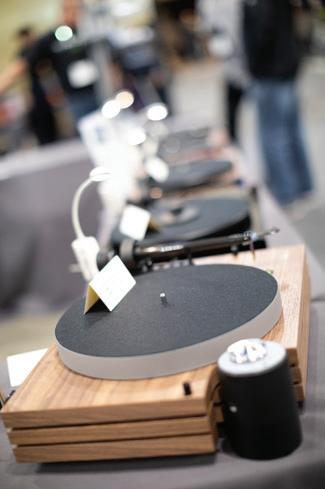
APRIL 14, 2022 - CHICAGO READER 65 Tickets on Sale NOW! Visit www.AXPONA.com AUDIO EXPO NORTH AMERICA HEAR HERE! GREAT MUSIC. INCREDIBLE SOUND. ALL IN THREE DAYS.
your passion
analog, streaming, headphones, speakers,
you can
you
Feast your ears on more than 200 exhibits to really experience what the newest audio products can deliver, including: • Turntables • Loudspeakers • Headphones • Vinyl • Electronics • Accessories See you at AXPONA! APRIL 22-24, 2022 • CHICAGO RENAISSANCE SCHAUMBURG HOTEL & CONVENTION CENTER Streaming Sponsor Live! April 22, 8:00 pm Friday Night Blues Night! Toronzo Cannon Live! April 23, 8:00 pm Saturday Night! Lori Lieberman
Whether
is
the music or all of the above, AXPONA is where
discover the latest gear from the brands you love to create your ultimate listening experience. And
can connect with fellow enthusiasts, designers, and industry experts.
SAVAGE LOVE
Your STI isn’t invited to the sex party
Gonorrhea is treatable but a lot worse than the common cold.
By DAN SAVAGE
Q : Bisexual female in an open/monogamish relationship with a heterosexual male. My partner and I have some friends in the swinging lifestyle that invite us to parties and group sex events. They recently picked up gonorrhea at a hotel takeover and did not find out until a er hosting 20 people at a sex party. So the group is now dealing with a gonorrhea outbreak— mostly oral infections, as we are all very diligent about condom usage for PIV. We are being treated, but I am pretty upset. The thing that bothers me most is how nonchalant they are being about the situation!
One person even called this an “inconvenience” and compared it to “the common
cold.” (WTF?) While some STIs are easily treated, gonorrhea is treatmentresistant and something like herpes, HPV, or HIV would obviously be a very big deal and permanent. They don’t plan to retest a er getting their shots and are already planning group sex events in the next few weeks, which I find concerning. I don’t think I’m comfortable engaging with their group if they are not going to take things like an STI outbreak more seriously. So, my questions are:
1. My test came back negative (my partner was positive) but shouldn’t they ALL retest after treatment? Especially if it is an STI known to be antibiotic resistant?
2. Am I overreacting or
being unfair to our friends? Is this just part of the swinging lifestyle territory that we all have to accept?
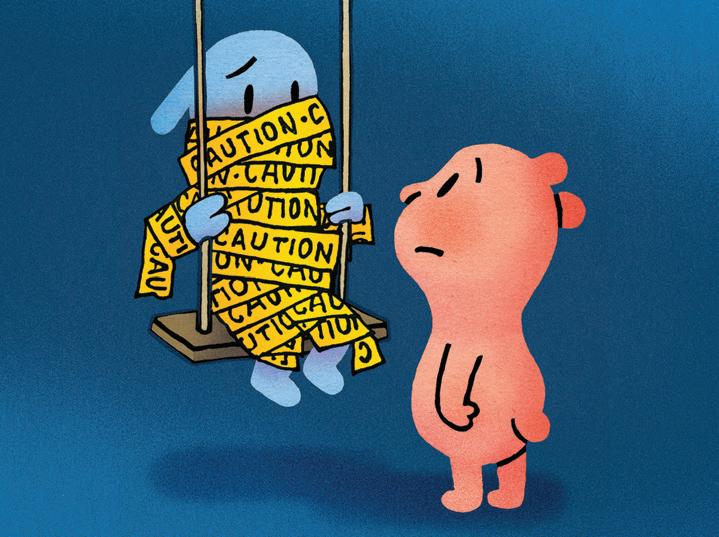
3. If we decide to not engage with the group because of their attitude towards STIs, how do we get back into the lifestyle? We are afraid we will lose access to events and people in the scene, as these friends have introduced us to everyone we know in the scene and have gotten us access to all the events we’ve been to before. —COMPLETELY LOST ABOUT PANICKING
A : 1. “Gonorrhea in the throat is the most difficult to treat,” said Dr. Ina Park. “So, folks that have oral sex and end up with gonorrhea of the throat should get a repeat test in two weeks and abstain from
oral sex in the meantime. For rectal and genital infections, the cure rates for gonorrhea are still so high that routine retesting a er treatment isn’t recommended.”
Dr. Park is a professor in the Department of Family Community Medicine at the University of California, San Francisco, CLAP, and also serves as a medical consultant for the Division of STD Prevention at the Centers for Disease Control and Prevention. And while she thinks your sex friends who aren’t getting a follow-up test after being treated for oral gonorrhea are making a mistake, she explained that you’re wrong about gonorrhea.
“Gonorrhea can still be easily treated with a single injection of an antibiotic called ceftriaxone, and there is almost no resistance to that drug in North America,” said Dr. Park. Which is not to say gonorrhea is no big deal or that things couldn’t get worse. “Those of us in the business of STI research do worry about an outbreak of multidrug resistant gonorrhea, but luckily it hasn’t yet happened,” said Dr. Park. “The bad news is that over half of the gonorrhea strains circulating in the U.S. are resistant to at least one class of antibiotics, and one-in-five are resistant to two or more classes of antibiotics. We currently only have one antibiotic in the U.S. that can reliably treat gonorrhea. But there is one new antibiotic in latestage clinical trials, although nothing is immediately available if standard treatment fails.”
Which it hasn’t, CLAP, at least not yet. So that means you and your partner and all your sex friends—if you get treated and tested again in two weeks—can emerge from this experience gonorrhea-free.
2. Your friends are underreacting—gonorrhea
shouldn’t be compared to the common cold—but you’re overreacting. While contracting an STI isn’t anyone’s goal at a sex party, whenever you’re having sex outside the bounds of a committed and sexually exclusive relationship, CLAP, you’re running the risk of contracting or spreading an STI. And since people in monogamous relationships cheat, there’s no guarantee you won’t contract an STI in a committed and sexually-exclusive-in-theory-but-not-in-practice relationship either. The only way to eliminate your risk of contracting an STI is to never have sex with anyone ever again, CLAP, including your partner.
If the pleasures of attending sex parties aren’t worth the increased risk of contracting an STI, you shouldn’t attend sex parties. You could still have an open relationship, CLAP, but you’ll have to be a lot choosier and make the other people you fuck jump through a lot of hoops. You can ask all prospective new partners to get screened for STIs, provide you with proof of their negative tests, and then refrain from fucking anyone else for a few weeks before meeting up with you. Not everyone is going to wanna jump through those hoops, CLAP, which means you and your partner will have fewer opportunities to fuck other people.
I regret to inform you that the people you wanna fuck could lie to you about abstaining from fucking other people after testing and before meeting up to fuck you a few weeks later, just like people in monogamous relationships sometimes lie. So to ensure your other partners aren’t fucking other people during that time, CLAP, you’ll have to lock them in your basement.
3. Swapping hosts—going to sex parties and swinger events organized by people who haven’t already
given you gonorrhea—isn’t the magic amulet you seem to think it is. Anyone who regularly goes to sex parties to fuck 20 other people is going to be exposed to HPV on a regular basis and is essentially volunteering to be exposed to and very likely contract herpes. (If you aren’t already vaccinated against HPV, get vaccinated.) If you’re using condoms religiously and correctly, and there’s no man-on-man action at these parties (and there usually isn’t at events organized by and for opposite-sex couples), your risk of contracting HIV is very, very low. You can reduce your risk of contracting gonorrhea, syphilis, and chlamydia orally by using condoms and latex barriers for cunnilingus and anilingus, but STIs that are passed through skin-to-skin contact are almost unavoidable when 20 people pile into a living room with a dozen mattresses spread out on the floor.
If you can’t live with those risks or you’re going to fall to pieces if or when you contract another STI, CLAP, sex parties aren’t for you.
Follow Dr. Ina Park on Instagram @InaParkMD. And, hey, it’s STI Awareness Week! I can’t think of a better way to mark the occasion than reading Dr. Park’s memoir
Strange Bedfellows: Adventures in the Science, History, and Surprising History of STDs, which is out now in paperback. The New York Times called Dr. Park’s memoir “joyful and funny,” and praised Park for using compassion and humor to “take the stigma out of these infections.” It’s a wonderful book that I would recommend to anyone, but I would especially recommend it to you, CLAP! v
Send letters to mail@ savagelove.net. Download the Savage Lovecast at savagelovecast.com.
@fakedansavage
66 CHICAGO READER - APRIL 14, 2022 ll
OPINION
JOE NEWTON




















































































APRIL 14, 2022 - CHICAGO READER 67 SCAN HERE CBD PAIN RELIEF CREAM GREAT FOR: BACKACHES ARTHRITIS MUSCLE ACHES The relief you need exactly where you need it most. USE CODE: PAIN & get 3 FREE Gifts greencbdtoday.com/reader Redeem this deal at nakedwines.com/deal50 SCAN ME $100 SAVE Includes Shipping Voted America's #1 Wine Club 2019, 2020 & 2021 "Excellent" Trustpilot rating 7,500+ Reviews Terms and Conditions: $100 o a preselected twelve-pack valued at $179.99. Wines pictured in the advertisement may not be available. First time customers and 21+ only. Void in AK, AL, AR, DE, HI, IN, MI, MS, MO, NJ, OH, RI, SD, TX, UT and where prohibited. By redeeming this o er, you agree to make a $40 monthly contribution to your Naked Wines account (charged until you cancel) that you can use to buy wine. Unused contributions are fully refundable. Additional restrictions apply and vary by state, see complete details at nakedwines.com/terms. 12 world-class wines for $79.99 331661_4.75_x_4.75.indd 1 2/23/22 12:37 PM
JOBS
Hydy Inc is accepting resumes for Director of Product Management in Chicago, IL. Work cross-functionally to identify product management strategy that aligns with business requirements. Telecommuting permitted. Mail resume to Hydy Inc., Attn: Tiffany Cross, 444 W Lake St. Suite 1700, Chicago, IL 60606. Must reference Ref. GR-IL.
Food Safety Scientist (Chicago, IL), must have a year of exp. Reqs: Mstr’s Deg in food safety. Duties incl: development & maintenance of food safety plan for all products, developing & updating food safety reltd docs, establishing & implementing inspection program to improve standards of outgoing & incoming products. Knowledgeable on critical control point, HACCP plans, SOPs, GMPs, food traceability program, mock recall, & audit procedures. Apply by sending resume, cover letter & proof of certificate to El Popocatepetl Industries Inc., c/o Operations Manager, 1854 W. 21st St., Chicago, IL 60608, no phone calls or drop in.
Software developers, Itasca, IL: Analyze, design, develop and test the programming applications using agile methodologies (SCRUM). Design software or customize software for client use with the aim of optimizing operational efficiency. Travel/reloc to various unanticipated locations. Telecommuting permitted. Send res to: Prorsum Technologies, Inc, 650 E Devon Ave., Ste 175, Itasca, IL 60143.
Software Developers. Gather and analyze user requirements, design and develop new software, modify and test commercial client server applications, evaluate existing and emerging software, full life cycle development to perform sophisticated software engineering jobs. Provide ongoing support for system modification, maintenance, optimization, and prepare documentation. Participate in system & database design meetings. Meet w/clients to resolve ongoing development issues. Travel & relocation possible to unanticipated locations throughout the U.S. Work loc: Chicago, IL. Mail res, salary reqmt, position applied for to: Pinion Services, Inc.,
8770 W Bryn Mawr Avenue, Suite 1300, Chicago, IL 60631.
Systems Engineer; Great Computer Solutions, Inc. Jobs loc in Skokie, IL & var unanticpt locs t/o U.S. Mnitor & mnge all installed systs & infrastructure. Est, config, test & maint op systs, app s/ware & syst mngmnt tools. Eval existing systs & prvde tech direction to IT support staff. Plan & impl systs auto as req’d for better efficiency. Timely rprting on the log sheet for the rapid resp to any glitches. Trav/relo to var unanticpt locs t/o U.S. for l/t & s/t assigns. Reqs Bachelor’s or frgn equivt in Comp Sci, Engng (any), Bus Admin, Mngmnt, or rel. Will also accept 2 yrs of exp in job offered or as a Comp S/ware Prof’l in lieu of Bachelor’s degree. Mail res w/h cover letter to Great Computer Solutions, Inc., 5152 Main Street, Skokie, IL 60077; Job 21GCS03; EOE
Mgr of Intellectual Prop. & Licensing – Manage university’s intellectual prop. portfolio; prepare/ file provisional apps with USPTO, communicate with outside patent counsel, enter info in database, prepare/manage NDA’s. JD, Patent Bar – res., cov. let. to Amit Thomas, Illinois Institute of Technology, 10 W. 35th Street, Suite 1300, Chicago, IL 60616
Chicago’s First Lady Cruises has a rare opening for FT or PT 100 ton Great Lakes Captain. Days and/or Evenings, beautiful vessels and nice people to work with. We have a full engineering team-no mechanical skills necessary. Supplement your income or make it a careerwelcome aboard. Jobs@
CruiseChicago.com
Sr. Software Engineer (Data and AI) at Insight Direct USA, Inc. (Chicago, IL): Dev, create, & modify gen comp apps software or specialized utility prgms. Require MS in Data Sci, or cls rel & 2 yrs exp. Add’l duties, requirements, available upon request. Email resume to susan.triggs@insight.com, ref Job#DK01
Yum Connect, LLC. has an opening in Chicago, IL for Senior Node.JS Engineer – eCommerce Platform to develop, optimize and refactor Node.js based web services. Telecommuting permitted. Ref job code C#5719408 & mail resume to: Yum
Connect, LLC. Attn: HR, 3301 Stober Road, Louisville, KY 40213.
BA ServiceNow Manager – (Chicago, IL) RSM US LLP: Prov analysis, devel & documentation of technical & digital improvement opps.
*May work remotely from anywhere in US. Reqs: Bachelor’s (or frgn equivt) in Info Tech, Management Info Systs, Comp Sci or rel field; 5 yrs exp as a Technical Consultant, IT Analyst, or a rel position.
Up to 10% travel required
Email resumes to: Attn: C Volkening – Ref # 2455, claudine.volkening@ rsmus.com
TransUnion, LLC seeks IT Project Managers for various & unanticipated worksites throughout the US (HQ: Chicago, IL) to lead design, implementation, & modification of IT projects. Master’s in Comp Sci/Comp Info Systems/Project Management/ any Eng or related field+2 yrs exp or Bachelor’s in Comp Sci/Comp Info Systems/ Project Management/ any Eng or related field+5 yrs exp req’d. Req’d Skills: Agile, Scrum teams, CornerstoneOnDemand, Rally, Clarity, Scaled Agile frameworks. Telecommuting permitted. Send resume to: A. Goodpasture, REF: PMS, 555 W Adams, Chicago, IL 60661.
Health, Safety, Environmental & Quality (HSE&Q) Manager; Alsip, IL: Arkema is seeking a lead HSE&Q impl, compliance & continuous improvement prgrms in support of the site. Devel & coord on-site prgrms to ensure compliance w/ all reg & permitting reqs rel to Industrial Health, Occupational Safety, Environment & Process Safety Management (PSM) reqs. Provide s’visory leadership to on-site Quality efforts in terms of external & internal customer, product quality systems (LIMS), work processes (AIMS) & tools to ensure the nec service level & customer expectations are met. Participate in HSE&Q activities provided by the site mngmnt, Arkema Coating Resins & Arkema Inc. Req’s: 5 yrs exp. w/ HSE&Q programs in a manufacturing setting & HSE&Q regulations, rules & processes, & exp w/ Manufacturing Management Systems, procedures & work processes. Knowl of office of State Fire Marshal (OSFM) Underground Storage Tank (UST) regs. Contractor
qualification & safety approval process through Avetta (or equivt) per Arkema Contract Safety Policy. Must have 3 yrs. Exp. in latex polymerization. Requires Bachelor’s degree in Chemistry, Engineering or related technical field. Domestic travel required up to 20% To Apply: https://career5. successfactors.eu/sfca reer/jobreqcareerpvt?jo bId=54139&company= ARKEMA&st=F9AA 0658B0EE6032E C45AC1FAFEBE 01CAE5BC55F
TransUnion, LLC seeks Analysts for Chicago, IL location to use advanced stat & machine learning technique to dev predictive modeling & business intelligence solutions for clients. Master’s in Statistics/related field +1yr exp req’d. Req’d Skills: Machine Learning, R, SAS, SQL, Python, Tableau. 20% telecommuting permitted. Send resume to: A. Goodpasture, REF: YL, 555 W Adams St, Chicago, IL 60661.
Thoughtworks seeks Lead Consultant Developer (Professional Services) to work in Chicago, IL & various unanticipated U.S. locations for leading largescale, custom-designed, enterprise-level software development projects that use object-oriented technologies, such as Java, Ruby, or .NET. Requires Bachelor’s in Computer Science, Computer or Electrical Engineering, Information Systems, or related field. Will accept a single degree or any combination of degrees, diplomas, professional credentials or professional experience determined to be equivalent by a qualified evaluation service. Must have 3 yrs exp. in the job offered or as a Consultant, Developer, or related IT position. Must have at least 36 mos. exp. (1) Participating at all stages of the software delivery life-cycle, including analysis, development, testing and deployment; (2) Leading a team of software engineers to oversee project activity, manage project deliverables and progress, prioritize plans for future iterations, and manage team performance. Must have at least 12 mos. exp. (1) Using Agile development methodologies including Continuous Integration, Extreme Programming, Continuous Delivery, Test-Driven Development and pair programming; (2) Using test automation frameworks to test at different levels, includ-
ing unit, functional and integration testing; (3) Developing software applications using Java, Ruby or .NET; (4) Serving as a liaison between client and development team to define scope and technical direction of the project including requirements gathering and design discussions and managing project deliverables and timeframes; (5) Working on projects with distributed teams, including managing coordination across countries and time zones; and (6) Coaching and mentoring junior developers in all aspects of software development, including Agile development methodologies. At least 80% travel across U.S. Send resume to ijobs@thoughtworks.com w/ Job ID JPS-LCD2022.
Seeking Females for Modeling Photographer seeking females for a fine a art photo shoot. No previous experience necessary. Must be over 18. Pay is $200.For details send a picture of yourself to be considered to cameras773@yahoo.com
Established Chicago Loop collection law firm seeks fulltime Receptionist / Administrative Assistant capable of handling the following responsibilities: answer/ manage inbound/ outbound telephone calls, manage/oversee front desk customer service, receive distribute mail, accept / process customer payments, and generally assist with daily office functions and process litigation documents. Interested applicants must be bilingual in English and Spanish, have previous reception experience, strong communication, interpersonal and organizational skills. Position offers benefits and competitive salary commensurate with experience. Please send resume to : katie@ hellerfrisone.com
Thoughtworks seeks Lead Project Manager to work in Chicago, IL & various unanticipated U.S. locations that will manage project teams in the building of complex, customdesigned, multi-tier, enterprise-level business applications that utilize object-oriented technologies, such as Ruby, .NET and/or J2EE and Agile Methodologies. Requires Bachelor’s in Management Information Systems, Computer
Science or related field. Will accept a single degree or any combination of degrees, diplomas, professional credentials or professional experience determined to be equivalent by a qualified evaluation service. Must have 2 yrs exp. in job offered or as a Product Architect, Technical Lead, Team Leader, Iteration Manager, Business Analyst or related. Must have at least 12 mos. exp. in (1) Managing project teams on full life-cycle, customdesigned, software development projects using object-oriented technologies and iterative methodologies; (2) Extensive release planning experience within an Agile environment; (3) Leading and managing development and QA teams, including team coordination and allocation of work; (4) Managing day-to-day project tasks, including tracking progress and budget; (5) Managing product releases and installation; (6) Managing client and stakeholder expectations by providing project status and performance updates, presenting proposed solutions and tracking budgets; (7) Acting as the sole technical architect with responsibility for the application’s design; (8) Interacting with clients and team members to communicate and coordinate technical project activities; (9) Implementing iterative methods such as Scrum and XP (Extreme Programming) and employing Agile
Practices including story writing, task estimation, iteration development, pair programming, stand ups, Continuous Integration and Delivery, automated tests and deployment and showcases; (10) Training and mentoring teams on Agile Development Practices; (11) Coordinating distributed technical teams across countries and time zones; and (12) Conducting new-hire interviews and completing performance reviews. At least 80% travel across U.S. Send resume to ijobs@ thoughtworks.com w/ Job ID TU-LPM2022.
Operations Manager: Direct & coord activities of employees to max profits. Plan & develop policies, goals. Coord marketing. Com w/ clients, employees, subcontractors, real estate agents, attorneys. Plan & manage business budget. Analyze financials. Prep contracts, proposals & estimates for construction bids. Prep documents for accountant, 2 yrs exp as operations manager or accountant. Bachelor’s in accounting or any business administration field. Must speak Polish. Res: MK Construction & Builders, Inc. 2000 N Milwaukee Ave, Chicago IL 60647
(Schiller Park, IL) E.J. Basler Co. seeks Manager - Sales, Engineering/Operations, and Planning w/ Mast or for deg equiv in IE, ME or rel eng fld & 3 yrs exp in job offer or manuf oper systs, IATF & contin improv KPI’s incl
68 CHICAGO READER - APRIL 14, 2022 ll
SECURE, QUIET & EXTRA CLEAN7-STORY BUILDING ❐ Loyola University ❐ Thorndale Beach ❐ Whole Foods ❐ Mia Francesca – all steps away! $825 – $860 rent / 1ST month ½ price! $275 move-in fee / no security deposit STUDIOS AVAILABLE! ❐ Heat & Electric FREE ❐ Laundry Room ❐ Bike Storage ❐ Furnished Lobby w/ Secured Entry & FREE WIFI ❐ On-Site Engineer ❐ Cats OK FOR MORE INFORMATION (773) 396-6785 ✶ AffordableKenmoreAffordableEdgewater.com CLASSIFIEDS JOBS ADMINISTRATIVE SALES & MARKETING GENERAL REAL ESTATE RENTALS FOR SALE NON-RESIDENTIAL PROFESSIONALS & SERVICES CLEANING RESEARCH ADULT SERVICES WANT TO ADD A LISTING TO OUR CLASSIFIEDS? Email details to classified-ads@chicagoreader.com
implem of IATF QA systs & integ KPI meas into QA systs; Swiss Type & General CNC, Hydromat, Acme, Davenport & Multi Spindle (lathe). Freq dom trvl reqd. Apply to HR, 9511 Ainslie St., Schiller Park, IL 60176.
LEGAL NOTICES
NOTICE OF PUBLIC
SALE OF PERSONAL PROPERTY


Notice is hereby given that pursuant to Section 4 of the Self-Storage Facility Act, State of Illinois, that Chicago Northside StorageLakeview /Western Ave Storage LLC will conduct sale(s) at www. storagetreasures.com by competitive bidding starting on April 15th and end on April 22nd @ 9:30am on the premises where property has been stored, which are located at Chicago Northside Storage 2946 N Western Ave. Chicago, IL 60618. 773-305-4000. In the matter of the personal property for the individual listed below, Chicago Northside StorageLakeview. John Frankot CC100, Saul Villa T039. Purchases must be made with cash only and paid at the time of sale’s redemption. All
goods are sold as is and must be removed at the time of purchase. Sale is subjected to adjournment.

Kreating Moments, Incorporated Policy of Non-Discrimination
Kreating Moments, Incorporated shall recruit and admit individuals of any race, color, or ethnic origin to all rights, privileges, programs and activities. The corporation shall not discriminate on the basis of race, color, national or ethnic origin in the administration of educational policies, admission policies, and other administered programs.
The corporation shall not discriminate on the basis of race, color, national or ethnic origin in the employment of its personnel.
RESEARCH
Have you had an unwanted sexual experience since age 18? Did you tell someone in your life about it who is also willing to participate?
Women ages 18+ who have someone else in their life they told about their experience also willing to participate will be paid to complete a confidential online research
survey for the Women’s Dyadic Support Study. Contact Dr. Sarah Ullman of the University of Illinois at Chicago, Criminology, Law, & Justice Department at ForWomen@ uic.edu, 312-996-5508. Protocol #2021-0019.
PROFESSIONALS & SERVICES



CLEANING SERVICES

CHESTNUT ORGANIZING AND CLEANING SERVICES: especially for people who need an organizing service because of depression, elderly, physical or mental challenges or other causes for your home’s clutter, disorganization, dysfunction, etc. We can organize for the downsizing of your current possessions to more easily move into a smaller home. With your help, we can help to organize your move.
We can organize and clean for the deceased in lieu of having the bereaved needing to do the preparation to sell or rent the deceased’s home.
We are absolutely not judgmental; we’ve seen and done “worse” than your job assignment. With your help, can we please help you? Chestnut Cleaning Service: 312-332-5575. www. ChestnutCleaning.com
APRIL 14, 2022 - CHICAGO READER 69
ADULT SERVICES Danielle’s Lip Service, Erotic Phone Chat. 24/7. Must be 21+. Credit/ Debit Cards Accepted. All Fetishes and Fantasies Are Welcomed. Personal, Private and Discrete. 773-935-4995 e Chicago Reader is now biweekly More than 60,000 copies will be available at nearly 1,200 locations across the city and suburbs. Find one near you and/or download the current issue: chicagoreader.com/map Upcoming Issues: The Sound Issue Pride Issue/WCT Insert Summer Theater/Arts Preview Cannabis Conversations Food & Drink Issue Apr. 28, 2022 May 12, 2022 May 26, 2022 June, 9, 2022 June 23, 2022 July 7, 2022 July 21, 2022 chicagoreader.com/classifieds Reach local buyers and find what you’re looking for anytime, anywhere.









































70 CHICAGO READER - APRIL 14, 2022 ll Outside Noise Reduction Keeps Bugs & Spiders Out Reduce or Eliminate Fog & Water Noise from Outside? Visit stormsnaps.com or noisewindows.com sales@stormsnaps.com Alpina Manufacturing, Chicago, IL 1-800-915-2828 Soundproofing Window Inserts the platform The Chicago Reader Guide to Business and Professional Services To advertise, email ads@chicagoreader.com home improvement legal books Fun, Clean, Picture Frame assembly JOB $18/hour Tired or bored of clicking away on a keyboard working at home? Keep your hands and mind busy with a fun, safe, clean assembly job. You’d have your own large assembly zone, at least 15-20 feet away from others, so we’re really safe here. Top rated rm Alpina Manufacturing LLC founded in 1992 Beautiful campus in Galewood, near Mars candy, 3 blocks north of Oak Park. We build and sell display framing systems to customers nationwide including Wal-Mart, Verizon, Circle K gas stations, Hospitals. Full time, Part time, Flex hours for working parents or students. We train, no travel, work in Galewood. Open to any backgrounds. Excellent pay, friendly caring management. Stop in anytime between 7am and 4pm M-F ask for Izzy to apply and check us out. Alpina Manufacturing 6460 W Cortland St., Chicago, IL 60707 business consulting entertainment Brigi e Schmidt Bell, P.C. 847-733-0933 lawyers@bsbpc.com Brigi eBell.com Brigi eSchmidtBellPC Considering Divorce? We Can Help. Collaborative | Prenuptual Divorce | Mediation insurance services health and wellness YOUR AD HERE dance JOIN US! WWW GECHAMBER COM What Greta said . . . shop local 5301N.ClarkSt.Fl.2 CHICAGODANCESUPPLY.COM 773-728-5344 A Matter of Consequences by Michael W. Falls Available on Amazon and Booklocker A Classic Chicago Mystery Customized Massage Therapy, Intuitive Energy Work, and Holistic Talk Therapy 2514 W Armitage Ave, Suite 211 Chicago, IL 60647 773-697-9278 www.intuithealing.com Open Thursday-Monday BY APPOINTMENT ONLY your heading here
More Than 1 Million Seniors Have Taken
It’s a well-known fact that for many older Americans, the home is their single biggest asset, often accounting for more than 45% of their total net worth. And with interest rates still near all-time lows while home values remain high, this combination creates the perfect dynamic for getting the most out of your built-up equity.

But, many aren’t taking advantage of this unprecedented period. According to new statistics from the mortgage industry, senior homeowners in the U.S. are now sitting on more than 9.23 trillion dollars* of unused home equity.
Home Values at All Time Highs
Not only are people living longer than ever before, but there is also greater uncertainty in the economy. With home prices back up again, ignoring this “hidden wealth” may prove to be short-sighted when looking for the best long-term outcome.
All things considered, it’s not surprising that more than a million homeowners have already used a government-insured Home Equity Conversion Mortgage (HECM) loan to turn their home equity into extra cash for retirement.
It’s a fact: no monthly mortgage payments are required with a government-insured HECM loan; however, the borrowers are still responsible for paying for the maintenance of their home, property taxes, homeowner’s insurance and, if required, their HOA fees.

Today, HECM loans are simply an e ective way for homeowners 62 and older to get the extra cash they need to enjoy retirement.
Although today’s HECM loans have been improved to provide even greater nancial protection for homeowners, there are still many misconceptions. Available if You Still Owe on Your Home or Owe
Nothing






For example, a lot of people mistakenly believe the home must be paid o in full in order to qualify for a HECM loan, which is not the case. In fact, one key advantage of a HECM is that the proceeds will rst be used to pay o any existing liens on the property, which frees up cash ow, a huge blessing for seniors living on a xed income. Unfortunately, many senior homeowners who might be better o with a HECM loan don’t even bother to get more information because of rumors they’ve heard.
As Featured
In fact, a recent survey by American Advisors Group (AAG), the nation’s number one HECM lender, found that over 98% of their clients are satis ed with their loans. While these special loans are not for everyone, they can be a real lifesaver for senior homeowners — especially in times like these.

Use the Extra Cash for Almost Anything

The cash from a HECM loan can be used for almost any purpose. Other common uses include making home improvements, paying o medical bills or helping other family members. Some people simply need the extra cash for everyday expenses while others are now using it as a safety net for nancial emergencies.
If you’re a homeowner age 62 or older, you owe it to yourself to learn more so that you can make the best decision for your nancial future.
We’re here and ready to help. Homeowners who are interested in learning more can request a FREE, no obligation Reverse Mortgage Guide by calling toll-free at 800-840-6571
Reverse mortgage loan terms include occupying the home as your primary residence, maintaining the home, paying property taxes and homeowners insurance. Although these costs may be substantial, AAG does not establish an escrow account for these payments. However, a set-aside account can be set up for taxes and insurance, and in some cases may be required. Not all interest on a reverse mortgage is tax-deductible and to the extent that it is, such deduction is not available until the loan is partially or fully repaid.





AAG charges an origination fee, mortgage insurance premium (where required by HUD), closing costs and servicing fees, rolled into the balance of the loan. AAG charges interest on the balance, which grows over time. When the last borrower or eligible non-borrowing spouse dies, sells the home, permanently moves out, or fails to comply with the loan terms, the loan becomes due and payable (and the property may become subject to foreclosure). When this happens, some or all of the equity in the property no longer belongs to the borrowers, who may need to sell the home or otherwise repay the loan balance. V2021.06.21 HYBRID





NMLS# 9392 (www.nmlsconsumeraccess.org). American Advisors Group (AAG) is headquartered at 18200 Von Karman Ave., Suite 300, Irvine, CA 92612. Licensed in 49 states. Please go to www.aag.com/legal-information for full state license information.


APRIL 14, 2022 - CHICAGO READER 71 PAID ADVERTISEMENT
Advantage of This “Retirement Secret” With home prices soaring and interest rates at all-time lows, there’s never been a better time to consider a reverse mortgage These materials are not from HUD or FHA and were not approved by HUD or a government agency.
on
pay monthly bills.
Thanks to the money received through an AAG Reverse Mortgage, seniors everywhere are enjoying their retirement and worrying less
how to
*https://www.yahoo.com/now/senior-housing-wealth-exceeds-record-150300719.html
FREE O a U.S.A.’s #1 Reverse Mortgage Company 330263_10_x_10.indd 1 4/6/22 1:52 PM
on: ABC, CBS, CNN & Fox News Our new Reverse Mortgage information guides & DVD are now available featuring award-winning actor and paid AAG spokesman, Tom Selleck. OurnewReverseMortgageinformationguides&DVDarenow














 By ISA GIALLORENZO
By ISA GIALLORENZO





 By Megan Eileen McDonough, Content Strategist at Deskpass Paid sponsored content from Deskpass
By Megan Eileen McDonough, Content Strategist at Deskpass Paid sponsored content from Deskpass















 By DEANNA ISAACS
By DEANNA ISAACS









































































































 By
By









































































































































































































































































































































 By KERRY REID
By KERRY REID









































 Gene Siskel Film Center
Gene Siskel Film Center





































































 By MARK GUARINO
By MARK GUARINO


























































































